Army children's birthplaces can speak volumes about their families' peripatetic lifestyles, as well as the times in which they grew up. Looking at a page of the 1891 national census for England and Wales listing families living in the 20th Hussars' cavalry barracks in Aldershot, for example, reveals that the daughters of one family, respectively aged three and two, were born in Cairo, Egypt, and Norwich, England, places to which their sergeant father had been deployed, accompanied by their 'on-the-strength' mother. The birthplaces of army children born between the wars, if not in India and other sunny stations, are likely to be those camps and garrisons where the British Army retained permanent bases (and still do), such as Catterick, Aldershot, Colchester, Tidworth and Bulford. Following World War II, locations further afield joined the list of likely places of birth, including Malta, Cyprus, West Germany and Northern Ireland.
 Various aspects of Bulford Camp pictured in a postcard dating from the World War I era.
Various aspects of Bulford Camp pictured in a postcard dating from the World War I era.If the civilian aspects of life outside barracks, camps and garrisons (such as the climate, the language or dialect spoken and the currency used) can change with bewildering frequency (often within a matter of months, but more usually within the space of a year or two) the touchstones of army children's immediate environment 'within the wire' typically remain reassuringly constant. Over the centuries, the ways in which the British Army has catered for the families of its serving soldiers have gradually expanded from being limited to providing accommodation and schooling to supplying spiritual, community, practical and personal support and advice, courtesy of the chaplains, what is today known as the Army Welfare Service (AWS) and affiliated charitable bodies like the Soldiers, Sailors, Airmen and Families Association (SSAFA) Forces Help. And when abroad, the challenge of living in an alien culture may additionally be cushioned by, for instance, the availability of certain familiar British products and foods stocked by the Navy, Army and Air Force Institutes (NAAFI); medical and dental treatment and care; and, thanks to the British Forces Broadcasting Service (BFBS), British television and radio programmes.
PICTURES: THE CONTRASTING FORTUNES OF NINETEENTH-CENTURY ARMY FAMILIES PRIOR TO OVERSEAS POSTINGS ("TOMMY ATKINS" MARRIED – PAST AND PRESENT, 1884)
The two images below illustrate the contrasting fortunes of those nineteenth-century army families that, on the one hand, were accorded 'on-the-strength' status and were therefore allowed to accompany their soldier husbands and fathers on overseas postings, and, on the other, were not recognised as being in any way the army's responsibility and were consequently left behind to fend for themselves. While the first image shows a line-up of army wives and children presenting themselves for a medical inspection (and, by the look of it, a dose of some sort of 'tonic') before setting sail – probably for India – the second depicts a wife whose marriage had taken place without the army's permission standing bereft with her two children on the quayside as the troopship carrying her husband and their father sails away. Both of these scenes are taken from "Tommy Atkins" Married – Past and Present, a composite print that was first published in The Graphic on 12 January 1884 (click here to see it).
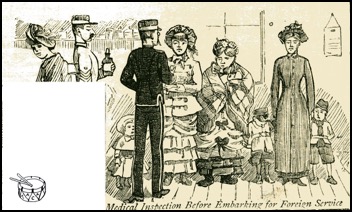

PICTURES: SOUTH BARRACKS, GIBRALTAR
The old colour postcard below presents a view of Gibraltar’s South Barracks, which date from the 1730s.

The South Barracks, Gibraltar (1844), below, is the work of George Lothian Hall (1825–88). Created using watercolour, pen and black ink and graphite on thick, moderately textured, cream wove paper, it is now part of the Yale Center for British Art, Paul Mellon Collection. Written on a fragment of the original mount is the following inscription: ‘The South Barracks Gibraltar – part of the Bay – and/ the mountains of Andalusia/ from the Naval Hospital/ March 1844.’.

PICTURES: CASEMATES BARRACKS, GIBRALTAR
The colourful old postcard seen below presents a view of Casemates Barracks, in Gibraltar, which dates from 1817. No longer a barracks, the buildings and surrounding area have been redeveloped (click here for more from Gibraltar’s tourist board.)
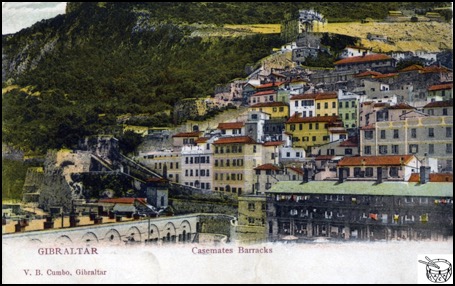
The illustration below is part of the Yale Center for British Art’s Paul Mellon Collection. Created by George Lothian Hall, it shows the officers’ quarters and Casemates Barracks in 1843.

PICTURE: THE BARRACKS, UP PARK CAMP, KINGSTON, JAMAICA
The photograph below is part of an album of views of Jamaica. Reproduced courtesy of the Schomburg Center for Research in Black Culture, Photographs and Prints Division, The New York Public Library, it shows a view of the barracks at Up Park Camp, Kingston, Jamaica. British soldiers were stationed at the camp following its establishment in 1784 until 1962, and it was home to many of their families, too.
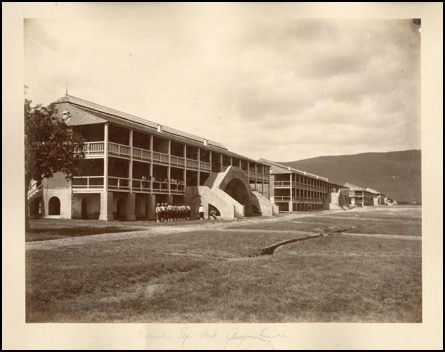
Picture: The New York Public Library Digital Collections: http://digitalcollections.nypl.org/items/510d47df-fb23-a3d9-e040-e00a18064a99.
Click here for further information about Up Park Camp on the Jamaica Defence Force website.
PICTURE: NEWCASTLE MILITARY CANTONMENT, JAMAICA
A picture-postcard view (below) of 'Newcastle Military Cantonment', Jamaica, once home to generations of army children. Newcastle Barracks was established on the instigation of Major General William Gomm in Jamaica's Blue Mountains in 1841, mainly because, at around 1,128 metres (3,700 feet) above sea level, its hillside location was considered healthier than that of Kingston, where the British were prone to succumbing to yellow fever.

In her autobiography, Wonderful Adventures of Mrs Seacole in Many Lands (1857), Mary Seacole (1805-81), née Mary Jane Grant, the Kingston-born nurse and healer, wrote that by 1843, she had 'gained a reputation as a skilful nurse and doctress, and my house was always full of invalid officers and their wives from Newcastle, or the adjacent Up-Park Camp.' A decade later, Mary's services were in even greater demand, 'for the yellow fever never made a more determined effort to exterminate the English in Jamaica than it did in that dreadful year. . . . My house was full of sufferers - officers, their wives and children. . . . It was a terrible thing to see young people in the youth and bloom of life suddenly stricken down, not in battle with an enemy that threatened their country, but in vain contest with a climate that refused to adopt them. Indeed, the mother country pays a dear price for the possession of her colonies.'
PICTURES FROM THE READ FAMILY ALBUM OF ABBASSIA, CAIRO, EGYPT, 1920S, AND A REQUEST FOR INFORMATION
Simon Burgess has generously contributed to TACA photographs from his great-grandparents' family album. Simon writes:
'My grandmother, Eileen Barbara Read, was born on 15 January 1928 at the Married Families' Hospital, Abbassia, in Cairo, Egypt. Her birth certificate was registered on 30th January 1928 by Major W B Hayley, Commanding Officer, K Battery, Royal Horse Artillery (RHA).
Her mother (my great-grandmother, Daisy Marion Read, née Preston) was a nanny, and at the time of her marriage, on 4 July 1927, was registered as living in the 'Ordinance Depot, Abbassia' (according to the wedding certificate). Eileen's father (my great-grandfather, Richard George Read, who was a lance sergeant in 'K' Battery, RHA, at the time) was stationed in Egypt between 1922 and 1930. Some of the photos in their archive are reproduced below, illustrating the life that they led during this period.
I understand that Daisy may be in a photo that TACA has of the school in Abbassia from this period [see 'PICTURE: THE GARRISON SCHOOL, ABBASSIA, CAIRO, EGYPT, IN 1928'].
Though I have lots of information about my great-grandfather's career, I have very little about Daisy and her time in Egypt. If anyone has any information about the school in Abbassia, about British nannies in Egypt during this period, or about Daisy herself, I'd be most grateful.'
If you have any information that may help Simon learn more, you can e-mail him at sighburge@yahoo.co.uk.
Below: Lance Sergeant R G Read, of 'K' Battery, RHA, Eileen Read, and Daisy Read, taken about 1928/9, Sidi Bishr Married Families' Camp, Alexandria, Egypt.

Below: Lance Sergeant R G Read and Eileen Read, about 1929.

Below: Eileen Read (about 18 months old here) seated, others sadly unknown, taken about 1928/9 at the NCO's mess.

Below: Eileen Read with dog, Port Said or Sidi Bishr Married Families' Camp, taken about 1928/9.

Below: Lance Sergeant R G Read, with Eileen Read (seated), other girl sadly unknown, taken about 1928/9.

Below: Military Families' Camp, Sidi Bishr, taken about 1928/9.

Below: Daisy Read and Eileen Read, Sidi Bishr Married Families' Camp, 1928/9.

Below: Daisy Read, Eileen Read, and friend, Sidi Bishr Married Families' Camp, taken about 1928/9.

Below: Eileen Read and friend, Port Said (my favourite photograph of my gran in the collection!)

Below: Lance Sergeant R G Read and Eileen Read on his Rudge Whitworth 500cc, most likely outside Port Said.

Below: Daisy Read and Eileen Read (seated) on R G Read's, Rudge Whitworth 500cc, most likely Port Said.

PERSONAL STORY: 'IT WAS A MAGICAL PLACE, WITH PALM TREES AND COFFEE PLANTATIONS', JAMAICA, 1928–30
With her father serving with the 2nd Battalion, Argyll and Sutherland Highlanders, Mairi Paterson's army childhood began and ended in Stirling, Scotland, where she lived from 1921 to 1922, and again from 1934 to 1938. The years in between saw her family posted to Aldershot, Hampshire, between 1922 and 1924; the Isle of Wight (1924–28); Jamaica (1928–30); Wei-Hai-Wei (today called Weihai), north-eastern China (1930–32, and click here for Mairi's memories of travelling there in 1930, and see below for her description of living in Wei-Hai-Wei); and Hong Kong (1932–34, see below); click here to read of her journey back to Scotland: ‘PERSONAL STORY: SAILING FROM HONG KONG HOME TO SCOTLAND, 1934’; and see below to read of her time living at Stirling Castle: ‘PERSONAL STORY: ‘NOW I WAS LIVING IN A CASTLE: STIRLING CASTLE’, 1934’). In the account that follows, Mairi outlines the early years of her life as an army child, before recalling in evocative detail the two years that she and her family spent in Jamaica.
'My father, Hugh Campbell, from Lochgilphead, Argyll, joined the Argyll and Sutherland Highlanders at Fort George. He became an instructor and was a good shot, competing at Bisley [Surrey]. When World War I broke out, he was seconded to the King's West African Rifles in Nigeria as an instructor. He was wounded in what was then German East Africa. He returned to the Argylls and was stationed at the depot, Stirling Castle, when I was born. We moved to Aldershot, and then to the Isle of Wight, where I started school.
The 2nd Battalion was then assigned a "tour of overseas duty" and was posted to Jamaica. My mother, brother and I did not travel then, as my grandfather was ill, but followed in May 1928, travelling from Liverpool in the SS Orduna. The camp was just outside Kingston, and during the hot season, it was almost too much to bear. Every so often, we were sent up to Newcastle, a hill station in the Blue Mountains. The steep road, with its hairpin bends, ended in the square formed by the church, the school, the orderly room and the NAAFI. There were steep paths up to the bungalows, and we had a donkey to help us get up and down them. When we went to the shop, my mother led the donkey, I sat on its back, my little brother (aged three) was in one pannier and the other was for the shopping. It was a magical place, with palm trees and coffee plantations. There were hummingbirds and mongooses, and it was so steep that one looked down on the roof of the house below. We would catch some fireflies, put them in a glass jar and eat our evening meal on the verandah by their light; then we would release them into the warm night again. On one visit, we were struck by a hurricane. Sent home from school early, I helped put the shutters up on the windows, take in everything possible, tie down everything else – and then watched as my party dress was whipped off the line and disappeared!
Kingston was very different. Our house was in quite a large garden, with four banana trees, a mango tree, a calabash tree and masses of plants. There were beautiful blue and green lizards and many birds. But there were also the terrifying large land crabs, which came out in the dusk, as well as scorpions, which were liable to hide in your slippers. I once watched as a piece of bread that I had put down moved swiftly over the floor, carried away by the ants. The legs of all our pieces of furniture stood in tins of paraffin. At night, you had to get under the mosquito net as quickly as possible and let in as few of the pests as you could.
I attended the army school nearby, and achieved the distinction of being expelled at the age of eight. The teacher must have forgotten that the troops there were not only Scots, but Highland. She gave us a lesson about the Jacobite rising of 1745 and described the clans as ignorant, illiterate savages who rebelled against their rightful king and, fortunately, were defeated by his brilliant son, the Duke of Cumberland, at Culloden [in 1746]. I was an early reader and had just finished D K Broster's trilogy about the '45, so stood up in a fury and said that she was a liar: the clans had an old culture, and Cumberland was remembered as "Butcher" Cumberland for his cruelty. I was immediately sent home. Two days later, my father was told that the school would overlook my behaviour and allow me back. I refused to go, saying that I would never learn anything from someone so stupid. It was eventually settled by a visit from the colonel. He was MacLaine of Lochbuie, a clan chief. He agreed with me, but said that I had also to learn things like arithmetic, and that I would have a different teacher. When I think of it now, I am amazed at everyone's patience. But I went back.
One great worry was becoming ill. Dengue fever was very prevalent. However, we had a "quinine cup": this was roughly made from a piece of a branch of the cinchona tree, and water put in it turned to quinine. The doses were: ten minutes for my brother, twenty for me and thirty for my parents. (I still have it, though it takes much longer now.) As a result of a bad outbreak, nurses from Kingston came to help, and we met a family, also called Campbell, whose members had been among the early settlers in Jamaica. Many years later, I met a black medical student, also a Campbell, who told me that his great-grandfather had been a slave on that plantation, and that on gaining his freedom, he had taken the name as his surname.
After two years in Jamaica, the battalion got its next posting – to northern China. We were to go through the Panama Canal and over the Pacific on a troopship!'
Mairi Paterson (née Campbell, b.1921).
PERSONAL STORY: 'I AM GLAD THAT I CAN REMEMBER WEIHAI AS IT WAS EIGHTY YEARS AGO'
In the previous instalments of her account of growing up as an army child between 1921 and 1938, Mairi Paterson described living in Jamaica (see above) and then sailing in a troopship with the troops and families of the 2nd Battalion, Argyll and Sutherland Highlanders (see 'PERSONAL STORY: CROSSING THE PACIFIC, 1930'), from Jamaica to Wei-Hai-Wei (today called Weihai), in north-eastern China, to which her father had been posted, and where her family would consequently live from 1930 to 1932 before moving on to Hong Kong (see 'PERSONAL STORY: GOING TO SCHOOL BY RICKSHAW AND KEEPING A LOW PROFILE IN HONG KONG, 1932–34', below) and then returning to Scotland (click here to read about the journey: ‘PERSONAL STORY: SAILING FROM HONG KONG HOME TO SCOTLAND, 1934’, and see below for her time living at Stirling Castle: ‘PERSONAL STORY: ‘NOW I WAS LIVING IN A CASTLE: STIRLING CASTLE’, 1934’). This part of Mairi's story has special historical significance because, as she notes, 'At that time Wei-Hai-Wei was leased to the British as a resource for the British navy, and I feel I may be one of the last [British] people who can remember life there and its return to the Chinese in 1932 as my brother and myself were the only British children there'. Read on for more.
'The men of the community were fishermen, and their junks and sampans crowded the harbour. The rising slope behind was cultivated by the women, the main crop being peanuts, as well as crops for food. The district commissioner, Reginald Fleming Johnston, lived in the big house on the point. He had been tutor to the young emperor, who had been overthrown by the communists, and he was an admirer of the imperial Chinese way of life. He had become a Buddhist and lived as a mandarin in Chinese style. He was Scottish and was, perhaps, more welcoming to us because of this. (In the film The Last Emperor, he was played by Peter O'Toole.)
We now had to settle into our new home. It was across the road from the parade ground, and was quite roomy. The most noticeable feature was a wide, enclosed verandah, with a bench that ran along it, under the windows. It soon became our playroom. At the back of the house, the kitchen and bathroom had flagged-stone floors, with drains that led out to the courtyard outside, which was surrounded by walls and had a large, heavy gate. My mother had a very special pair of very handsome curtains, and as soon as they were up, we knew that we were at home. Sometimes they were full length, sometimes folded in half, and sometimes over a door instead of a window – but they were always there.
The weather became colder and colder, and I acquired a fur coat and a fur hat with earflaps. My little brother, Euan, had a furry jacket that made him look like a teddy bear. We were the only European children there, though later Sergeant Sinclair's wife joined us with their newly born baby daughter. My mother asked an uncle to send out books. A huge box arrived with the collected works of Sir Walter Scott, Robert Louis Stevenson, John Buchan and, surprisingly, Zane Grey. Best of all was Andrew Lang's History of Scotland, which became my favourite book. My mother was the strictest teacher I ever had. Every morning, I read a chapter of the Bible and learned some of the Shorter Catechism. Then I studied English and arithmetic, with history and geography in the afternoon. During the week, I read a book, and on Saturday morning, wrote a summary of the plot and chose two characters and two incidents and explained why I'd done so.
We made friends easily, and local children came to play on our verandah. My best friend was Soong Mei-ling. We could not speak much to each other, but did everything together. On Saturday evenings, my mother held open house for any of the men who cared to come. She made oatcakes, scones and shortbread, and they played games like I-spy with us. Sunday evenings meant a visit to Mr and Mrs Hill, kindly elderly missionaries, where we sang hymns around the piano and ate parkins. There were usually about ten of us there, and we all walked home through the cold, clear night.
There was plenty of entertainment as each platoon organised a concert or whist drive each month. Euan and I always had the best seats, and were ready to enjoy what we knew would be coming, depending on which platoon was host. Sergeant Grant would sing a selection of Harry Lauder songs; Second Lieutenant Graham would deliver a humorous monologue; my father would sing "The Road to the Isles"; and so on. We were delighted to hear our favourites again.
THE PASSING OF THE SEASONS IN CHINA
Then it was Christmas. I had begun to have serious doubts about Santa Claus, but said nothing to Euan. On Christmas morning, my father reported that Santa had not been, but just as Euan began to cry, there was a loud knock on the verandah door. My father went to answer it and we heard, "Hello, Santa, you’ve made it". We could see faintly through my bedroom curtains, and watched my father come up the verandah, followed by a figure with a sack over his shoulder. "Have they been behaving themselves?" asked Santa. He did not sound very "Ho, ho, ho!" but instead rather grumpy. There was a long pause before my father replied, "On the whole, they’ve been quite good". Then Santa said, "Well, they were quick to write to tell me what they wanted, but they didn’t bother to say where they were. Last time I came, they were in Jamaica. How was I supposed to know they were in northern China?" We shouted, "Sorry, Santa, we forgot". My father persuaded him that he needed something to warm him up, and a little later Santa sounded more friendly as he said, "I’m running very late and I've still got Siberia to do. Remember to let me know next year". It was much later that I realised that my presents were very Chinese in type!
At the Chinese New Year, we watched the dragon weave and dance his way among the trees and enjoyed the fireworks. But the most memorable moment came one evening, when we went down to the harbour. Most of the village had gathered there, and many were holding little wooden boats, each of which had a small candle fixed in it. As the tide went out and one of our pipers played a lament, the little boats, each in memory of one of the villagers lost at sea, were launched. We watched as the glimmering lights disappeared into the darkness of the China Sea.
Summer came, and Wei-Hai-Wei was transformed. The shuttered house was opened up and cleaned and revealed to be an hotel for the Royal Navy wives and families. The ships arrived – battleships, destroyers, submarines – and the harbour was crammed. Suddenly, there was a busy social life, both on the island and on the mainland. A magician came, and Euan and I were asked up on the stage to help with his conjuring tricks. Dances were held, and the portly Major Hyde taught me to waltz, telling me that I would not get dizzy if I kept my eyes on his middle button. Best of all, a performing-dogs theatre came. My father was very helpful with their accommodation and exercise area, and when one of the cast gave birth to a litter of pups, I was given one. We called him Bodach (Gaelic for "old man") because of his grey whiskers. He was a very intelligent and tough little Pekingese who would tackle anything. (No wonder the Chinese call them "lion dogs".) Instead of staging whist drives and concerts, we now hired sampans and sailed a few miles to a beautiful sandy bay, where we dived and swam from the boat and had picnics on the shore. A greasy pole was run out over the bow, and the men would have pillow fights on it till both combatants fell in.
However, this simple, but happy, life was to end. Its lease to Britain had ended on 1 October 1930, but Wei-Hai-Wei then became a special administrative region until 1932, when it was finally handed back to China. The formal ceremony was very impressive, with the troops standing stiffly to attention, bugles and pipes, speeches and, most notably, the commissioner, Fleming Johnston, formally dressed and wearing a top hat!
We were now to join the rest of the battalion in Hong Kong – a busy city – and I would be back in an army school. Neither prospect attracted me. We had grown to feel part of the life of the place, rather than standing outside it, and had made many friends.
"I AM GLAD THAT I CAN REMEMBER IT AS IT WAS EIGHTY YEARS AGO"
I believe that Weihai is now a busy industrial town, and photographs of it show factories and high-rise flats. It has train and bus connections to the rest of China, as well as a busy harbour, with cargo ships and trade with South Korea. I am glad that I can remember it as it was eighty years ago.'
Mairi Paterson (née Campbell, b.1921).
PERSONAL STORY: GOING TO SCHOOL BY RICKSHAW AND KEEPING A LOW PROFILE IN HONG KONG, 1932–34
As a small girl, Mairi Paterson lived in Stirling, Aldershot and the Isle of Wight. Her soldier father's next posting then took her and her family, along with the 2nd Battalion, Argyll and Sutherland Highlanders, to Jamaica (see 'PERSONAL STORY: 'IT WAS A MAGICAL PLACE, WITH PALM TREES AND COFFEE PLANTATIONS', JAMAICA, 1928–30', above). A Pacific crossing in the City of Marseilles, an overcrowded troopship ('PERSONAL STORY: CROSSING THE PACIFIC, 1930'), having transported Mairi from Jamaica to Wei-Hai-Wei (today called Weihai) two years later, she lived in this north-eastern Chinese seaport until 1932, one of only two British children there ('PERSONAL STORY: 'I AM GLAD THAT I CAN REMEMBER WEIHAI AS IT WAS EIGHTY YEARS AGO'', above). In this, the next instalment of her story, Mairi tells of the two years (1932–34) that she and her family subsequently spent in Hong Kong, at a time when the Japanese threat to it was becoming increasingly pronounced. (Click here to read of her next journey: ‘PERSONAL STORY: SAILING FROM HONG KONG HOME TO SCOTLAND, 1934’, and see below for her time living at Stirling Castle: ‘PERSONAL STORY: ‘NOW I WAS LIVING IN A CASTLE: STIRLING CASTLE’, 1934’.)
'Leaving Wei-Hai-Wei meant not only leaving the simple, friendly life of a small village for the noise and bustle of a city, but also rejoining the rest of the battalion. The families were housed in a four-storey block of flats, the President Apartments, in the heart of Kowloon, on a busy street. The camp was at Sham Shui Po, later to become notorious when it became an internment camp after the Japanese invasion.
My father became RSM [regimental sergeant major] of the battalion and spent most of his time at the camp, coming home only in the evenings. Our flat was on the top storey and on the corner of the building, so we had a very large verandah, running around two sides. It eventually became the home of our increasing number of pets, which included a parrot, two budgies, five goldfish, and a hen and a duck. The last two had been given as presents at New Year – alive, to be killed and eaten when required. After a couple of days, they had become pets, and we could not have eaten them! In addition, there were temporary residents: as I spent my pocket money buying the tiny wild birds that had been caged and were sometimes taken out by their owners, they spent a few days with us until we could go to the New Territories and set them free there. The flat roof of the block was a playground, particularly for flying kites on. Now there were neighbours all around us, and plenty of company.
We attended the army school on Gun Club Hill. It was some distance away, and every morning our rickshaws were waiting to take the children there. They were waiting, too, to take us home after school. I think the rickshaw men enjoyed this: after all, it was steady work, they got to know us, and there was always a lot of laughing and joking. Sometimes there were races on the way home. On one occasion, our rickshaw collided with another, went over and I was on the ground with my brother on top of me. I was quite badly bruised and scraped, and well remember the anti-tetanus jabs.
The school was next door to a Gurkha barracks, and the men smiled and waved when we were out in the playground. We were now back to formal lessons, with several teachers. One I remember fondly was Mrs MacMenamin. She was Irish, and had a lovely speaking voice. On Friday afternoons, the senior girls had sewing, and while we worked, she read us poetry – poems like "Cargoes", "The Lake Isle of Innisfree" and "The Traveller".
A cousin of my mother's, Hamish Cameron, was the managing director of a company engaged in the building trade, and he and his wife, Chrissie, and their two children lived in the area near the waterfront. They were very friendly and welcoming, and we spent a lot of time with them. They had a busy social life, and as there were many Scottish expatriates and a flourishing St Andrew's Society, we enjoyed many activities. I remember the trips to the sandy beaches on the island. On one occasion, I encountered a large jellyfish. I was delirious for two days, with a severe sting on my shoulder and an interesting spiral of red and swollen flesh down my arm as one of its tentacles had wound its way down it. It is very sad now to remember that the Cameron family suffered badly when the Japanese took Hong Kong, and that Chrissie died in Sham Shui Po Camp.
While we were there, an outbreak of diphtheria struck Kowloon. I went down with it, and, on Christmas Eve, was strapped securely onto a stretcher and taken by ambulance to the Star Ferry and across to Victoria Island. The hospital was high up on the Peak, and access was by a funicular railway. The stretcher was placed on the gap between the seats and attached to their supports. As we went up, I could see the streets, houses and shops receding from me. At one point, the climb was so steep that my stretcher and I were almost vertical. I must have been more ill than I realised because my father was told to be "ready for the worst". However, I recovered and quite enjoyed the lazy days of my convalescence.
Quite soon I got to know the Star ferries well. I moved on to secondary school and travelled daily to the Central British School on the island. I enjoyed it very much, especially as several friends from Gun Club Hill were also there.
"THEIR BODIES, FIXED ON POLES, WERE BEING PARADED THROUGH THE STREETS"
There was now growing unease about Japanese attacks on China. There were many Japanese living in Hong Kong, and there were rumours of attacks on them. One day, the blinds on our verandah were pulled down and we were not allowed to look. A Japanese family had been killed and their bodies, fixed on poles, were being paraded through the streets.
One morning, my father left as usual after breakfast. Mid-morning, his batman arrived to collect clothes and personal items. The Japanese had attacked Shanghai, and the battalion had been ordered there to protect the British concession. We watched the men march down to the docks, and that was the last we saw of my father for some time. There was some hostility among the Chinese as our men had not gone to fight the Japanese and save Shanghai, but only to protect the British concession, and we were warned to keep a low profile in case we were attacked, too.
Then came the news that we were going home. My father was to be RSM at the regimental depot at Stirling Castle. He was still away, and my mother was not well, so I was involved in all the decisions and the packing. At last it was all done, and my father was with us again as we embarked on another long voyage.'
Mairi Paterson (née Campbell, b.1921).
PERSONAL STORY: ‘NOW I WAS LIVING IN A CASTLE: STIRLING CASTLE’, 1934
In this, the final part of her account of her army childhood, Mairi Paterson recalls the time that she spent living in Stirling Castle, the regimental depot of the Argyll and Sutherland Highlanders, to which her father had been posted from Hong Kong in 1934. (To read Mairi’s story from the start, see ‘PERSONAL STORY: ‘IT WAS A MAGICAL PLACE, WITH PALM TREES AND COFFEE PLANTATIONS’, JAMAICA, 1928–30’, above; ‘PERSONAL STORY: CROSSING THE PACIFIC, 1930’; ‘PERSONAL STORY: ‘I AM GLAD THAT I CAN REMEMBER WEIHAI AS IT WAS EIGHTY YEARS AGO’’, above; ‘PERSONAL STORY: GOING TO SCHOOL BY RICKSHAW AND KEEPING A LOW PROFILE IN HONG KONG, 1932–34’, above, and ‘PERSONAL STORY: SAILING FROM HONG KONG HOME TO SCOTLAND, 1934’.) In conclusion, Mairi relates what happened after her father retired from the regular army and reflects on having been an army child during the 1920s and 1930s.

Today, all of this is in the care of Historic Scotland, and the restoration of the palace will be complete within a few months, with tapestries on the walls and the famous carved wooden heads on the ceilings. Parliament Hall and the Chapel Royal have already been restored. However, when I lived there, it was still a barracks. The palace housed the officers’ mess and accommodation, and downstairs was the NAAFI canteen. Floors had been inserted into the soaring space of the Parliament Hall, cutting across the tall windows and making barrack rooms for the men. On the ground floor, in one corner was the NAAFI shop. The Chapel Royal was the quartermaster’s store, with tables covered with uniforms and so on.
“I WENT TO BED WITH THE LAST POST AND WOKE WITH REVEILLE”
The offices of Historic Scotland now occupy the Georgian house in the Lower Square in which we lived. It backed on to the original defensive wall of the time of James IV, and every morning I would hear the footsteps of the soldier who walked along the passage outside my window to hoist the standard. I went to bed with the Last Post and woke with Reveille.
Several other children lived in the castle – the children of the officers’-mess steward and of the civilian clerk of works. We had a wonderful time roller-skating in the Lion’s Courtyard, or Lion’s Den, and climbing and sledging in the snow down in the Back Post, which had been the original entrance to the castle.
Although it was a military establishment, the castle was open to visitors, and there were official guides. If visitors turned up after the guides had gone off duty, they were allowed in if they had come some distance. My brother and I knew the castle intimately and had heard all the stories, so we would take them around. But my father had insisted that we must never accept money for this – it was Highland hospitality. On one occasion, when we had refused money from a party of Americans, they offered us sweets. My brother had to dash off to find my father to discover whether this was allowed. The answer: one each.
The Back Post was barred to visitors as weapons and ammunition were stored there under guard. Today, these buildings house exhibitions and the tapestry workshop, and can be visited. Then, it was used a lot for recreation. The tug-o’-war team trained there, hauling a heavy bucket filled with stones up to the top of the posts supporting it.
As with all proper castles, there were ghosts. The Black Douglas rushed past the sentry at the Back Post in the guise of a huge black dog, while the officers’ mess was haunted by the Green Lady. The story was that she had been the daughter of an early commanding officer. One evening, she and her sweetheart, a young officer, were at the entrance to the castle. She saw a flower outside, and the sentry was sent to pick it, while the officer took his place. When her father saw her apparently in the arms of a private soldier, he shot her! While we were there, a batman was found unconscious in the mess and swore that he had seen the Green Lady.
When the very grand annual garden party was held in the Queen Anne Gardens, we children used to lie on the walls of the gate above and watch the guests arriving. We also watched the mess stewards as they circulated with trays of drinks and delicacies, and they usually came up and brought us some goodies.
My grandfather, who was in his eighties and had to walk with two sticks, lived with us. He had a very friendly and outgoing nature and, as a result, had a great time. “Old Mr MacLean” was invited to everything: concerts, sergeants’-mess dinners, boxing matches . . . He even went on the wives and children’s annual summer outing as a kind of honorary grandfather.
My great delight was to come back to the castle after a visit to the cinema or a friend’s party. The great gate was closed, but, as my steps sounded on the drawbridge, the small postern gate was opened and the sentry held his rifle and bayonet aslant across the opening.
“Halt! Who goes there?”
“Friend.”
“Advance, friend, and be recognised.”
I would go forward, and the sentry would move his rifle back.
“Pass, friend. All’s well.”
“OUR MILITARY LIFE WAS NOT COMPLETELY OVER”
At last, however, my father retired from the regular army, and we left Stirling Castle. But our military life was not completely over. My father left the castle to become quartermaster of the 8th Territorial Battalion (A & SH), whose headquarters were in Dunoon, Argyll. He was still there when World War II broke out, and went with the 8th to defend the Maginot line. When the Germans broke through to the north, my father, a real old soldier, got his staff safely across France to the coast by travelling, dressed in peasant clothes, behind the German Army. They got out at St Valéry, and my father was decorated for his part.
Later, my father organised the Home Guard in Argyll, and enjoyed travelling around the country he knew so well. Later still, he became beachmaster at the commando training centre that had been established among the hills and lochs near Inveraray, on the shores of Loch Fyne.
I remember it all so well and feel that I was very fortunate to be an “army brat”.’
Mairi Paterson (née Campbell, b.1921).
PERSONAL STORY: LIFE IN THE BARRACKS, DORCHESTER, DORSET, 1925-35
Bob Manning (b. c.1925) contributed his memories of growing up in the Dorsetshire Regiment's Depot Barracks, in Dorchester, Dorset, between 1925 and 1935 to The Keep Military Museum there. His story, as told by Helen Jones, first appeared on the museum's website (http://www.keepmilitarymuseum.org, which is well worth visiting for those with an interest in the regiments of Devon and Dorset, as well as in what life in a regimental depot was like for army children), and TACA is grateful to her, and to the museum, for permission to reproduce it.
'Local resident Bob Manning grew up in the Depot Barracks between 1925 and 1935. He remembers that much of the area of the barracks was out of bounds to the children. They were not allowed to enter the site through "The Keep" itself, but had to use the steps up to the site, situated on the Poundbury Road, opposite the cavalry barracks. They were not allowed near the soldiers' quarters either.

Above: The Dorchester Depot Barracks pictured in around 1900.
Bob lived in the "Little Keep" itself towards the end of his father's posting. Before that, the family was billeted in the married quarters. These have long been demolished, but were behind the "Little Keep" building. The married quarters were two stories high, with four or five quarters in each. There was an iron stairway at each end and a walkway between them. "Playing chase up one stairway, along the walkway and down the other staircase was strictly forbidden - not, that is, to say that the prohibition was always heeded. It was too good a chance for the boys to miss", recalls Bob. Bob remembers that the family did its grocery shopping in the NAAFI [Navy, Army and Air Force Institutes] stores on the barracks site, and that the children were often sent there on their own. Soldiers used the NAAFI to buy cigarettes and polish.
It was fun living in the barracks as a child as there were lots of places to play. There was a grass bank between the barracks and the railway. The grass was allowed to grow long before it was cut with scythes. The boys were given the clippings to make forts. The old soldiers who had fought on the North West Frontier of India taught them the word sanger, meaning "fort". Of course, the forts in India were made of stone, but the boys played out imaginary wars in their grass forts. The girls played ball games and skipping games in a grassy area near the "school" room.
The boys also liked leaving the barracks site to play on the earthworks at Poundbury. There was no industrial site there in those days, and they had to climb over a fence and cross the railway line near the railway tunnel to reach the earthworks. They would show off by "bravely" setting foot in the tunnel. At weekends, whole families would go to the earthworks, taking picnics with them. They could bathe in the river from the lower slopes. The boys also enjoyed playing along Poundbury Road itself, amongst "a rather scrubby line of trees and bushes which we called Sherwood Forest".
There were many places where the children were not allowed to go. They had to keep away from the "school" room during exams. This was not a school for children, but for soldiers. They were not allowed near the stores and offices, the officers' quarters, the officers' mess or the stables where the officers kept their horses. They were not even allowed to walk anywhere near "The Square" (the parade ground).
Bob recalls that in front of the officers' mess was a small, grassy area, and that other regiments would sometimes visit for training exercises. They would set up bivouac tents on this area. Bob can remember the Green Howards coming. The boys would try to persuade the visiting soldiers to give them cap badges, but they were not usually successful.
THE MARABOUT BARRACKS
On the other side of the road from the Depot Barracks were the old cavalry and Royal Artillery barracks known as the Marabout Barracks. Bob recalls that there was a sports field there, and that on Saturday afternoons families from the Depot Barracks would gather there to watch football and hockey matches.
There was a drill hall, too, where the children would watch the TA [Territorial Army] band practising marching and countermarching. There were workshops run by civilian staff, under the charge of a Mr Nicholls, as well. Children were not allowed to go there unless Mr Nicholls himself invited them in. They were allowed to visit the pigsties, however. The pigs were looked after by a Mr Frampton, and he was always happy to chat to the children.
There was a hospital on the Marabout Barracks site that served the families of the Depot Barracks. Colonel Sidgewick was in charge here, assisted by an NCO [non-commissioned officer] named Sergeant Lemon. All of their ailments were treated by Colonel Sidgewick, and he also gave them their inoculations.
The depot's commanding officer was Major De La Bere. He lived just outside the perimeter of the depot, but used to enter through a door in the walls. The lads were expected to raise their caps to him, should he pass them.
Bob was only about 10 years old when he left the depot, but is pleased to share his memories of growing up in Dorchester's Depot Barracks.'
PERSONAL STORY: MEMORIES OF WOOLWICH, BY AN RAF OFFICER
This piece was first published in the May 2007 issue (No. 147) of Pennant, the journal of the Forces Pension Society (see http://www.forpen.org for further details). TACA is grateful to both Squadron Leader Peacock and Pennant for permission to reproduce it.
'I am not of the army, although I come from an army family, as did my grandparents on both sides. My brothers went into the army: one to the Scots Guards and the other to the West Kents. There is always one, though . . . and I went into the Royal Air Force. This sin was never forgiven, Bomber Command notwithstanding.
My father was a Royal Engineer and an instructor at the "Shop". Our lives revolved around that noble edifice, with its highest of standards.
I well recall the last tattoo I was taken to on Woolwich Common. It was "The Storming of the Kashmir Gate" and in those days they really knew how to put on a big production.
Most Sundays after church parade at the garrison church, we (my parents, two brothers and many others) would assemble on the edge of that wonderful parade ground, usually not too far from that menacing lump of gun in the foreground of the picture (see below). There we waited breathlessly for the crash of drums and the blare of brass as what was a superb military band marched out through that archway and began a magnificent display. It really prickled the skin, as it does now, just to think of it.

To the right of that long line of buildings was situated the garrison theatre. Many times did we enjoy the productions put on by the staff and others. A great treat, especially when they put on something about the "war to end all wars". It was all so exciting, so thrilling. No one thought about Hitler in that year or the repeat performance to come.
I recall several visits to the Rotunda, that sombre place, with its memorabilia of the First World War. Probably the seed of an allergy to trenches, ditches and mud was planted there.
But to remember the "Shop" and the cadets in their pillbox hats and playing bicycle hockey gives so much pleasure. My Scots Guards brother and myself were choirboys in the splendid church and I well recall singing at the funeral of General Wagstaff. Very military it was, too. I can still hear the sound of clinking medals and spurs.'
Squadron Leader Trevor Peacock.
PERSONAL STORY: EXPERIENCING TERROR AND THRILLS AT CATTERICK CAMP AND WAR'S OUTBREAK AT ALDERSHOT
TACA has sadly proved something of a letdown for this former army child, who writes: 'I have looked at the TACA website with interest, but was rather disappointed not to find accounts by army children concerned with the effects of being the child of a soldier . . . I do not propose now to give you my biography, but I thought that an example or two of my own banal experiences as an army child might encourage other army children to follow suit. I hope that these few memories of mine, as an army child, will encourage other army children to share some of their experiences with the rest of us.' We should, perhaps, say in response, firstly, that those with an interest in history would not agree that the following recollections are in any way banal, and, secondly, that similar memories would indeed be very welcome.
'I was born in Catterick Camp, in the army hospital there - a wooden building, as it was then. My father was posted to Aldershot when I was about four or five, so until then I lived in a completely military environment. I can remember very little of that time, but I do still recall being terrified of pipe bands, which often marched past our quarter. If I shut my eyes, I can see the serried ranks of white spats worn by the bandsmen. Another source of terror for me was tanks. They really scared me, rumbling by. I think it was the clatter of the tracks and the (to me) enormous size of these unwieldy vehicles. These frights, and many similar ones, were probably not everyday experiences, but, in Catterick Camp, pretty frequent.
On a brighter note, I can remember being very impressed by a display by the Royal Signals, as I now know them to have been. This was the thrilling sight of the dispatch riders mounted on their motorcycles, leaping over horse-drawn cable wagons as they circled the arena in the opposite direction. Of course, military dispatch riders and cable wagons were an everyday sight in Catterick Camp in those days, and, to an army-child infant, perfectly normal; I only remember them because of the leaping motorcycles.
Aldershot was a very different environment. It was a large town, and the army garrison was mainly on the outskirts. My father had bought a house near the railway station, so we did not live directly in an exclusively army environment. However, as an army child, one regarded civilians as "different", and I felt quite at home when going through the barracks, gazing at the horses in their stables and cadging army biscuits from the various regimental cookhouses. We attended an army doctor's surgery and an army dentist's surgery, an army church and, when necessary, an army hospital - a separate one for wives and children. We bought our food rations from the NAAFI shop.

Above: Aldershot Camp, Hampshire, as it looked during the early decades of the twentieth century.
Two events remain particularly in my memory. The war (I heard the declaration on the radio), of course, was probably more noticeable in a large military garrison, especially as we lived near the station, but was brought home to me particularly vividly when, one day, I found the town absolutely swamped by exhausted soldiers fast asleep on the pavements, in all manner of dress, and without their equipment. These were the survivors of Dunkirk, who had been packed into trains on the coast and sent to Aldershot. My mother and many other ladies carried around tea and sandwiches for them. They were soon housed in the barracks, of course, but it was a shock to a small boy to experience the less glamorous aspects of war.
One more Aldershot memory: one Sunday, on going to church (the Roman Catholic one), we found it packed full of French Canadian soldiers, a church parade. That was a bit of a shock, but a pleasant one, since it brought home to me that our country was not alone. I am surprised that I can still remember it so well, but this is probably because it was a very personal experience.'
JRG (b.1929).
TACA CORRESPONDENCE: REQUEST FOR INFORMATION ABOUT A ROYAL ENGINEERS OFFICER AND IMAGES OF RANIKHET, INDIA
Jon Alexander has sent the following message requesting information and images relating to wartime India.
‘I was born at the British military hospital (BMH) in Ranikhet (India) in May 1942. My father, Peter Alexander, was a lieutenant (then a major) in the Royal Engineers, with postings in Bombay, Bangalore and Madras during the 1939–1946 period. If anyone has information or memories concerning my father during this time, I will be pleased to hear from them via TACA. If anyone can contribute photographs of the BMH in Ranikhet at that time (or now, if it is still in use), or of St Peter's Church (Ranikhet), where I was baptised, I shall be most grateful.’
If you have any information, memories or photographs that you think will interest Jon, he can be contacted through TACA.
NEW RESEARCH PROJECT: DOCUMENTING BRITISH ARMY CHILDREN’S EXPERIENCES OF VERDEN, GERMANY, 1945–93
TACA has received the following call for contributions from Anca, a German researcher who is resident in Verden, a town in Lower Saxony, Germany.
‘I am writing a history of a period of our town’s history entitled "BAOR: The British Garrison of Verden (Germany), 1945–1993”. One chapter of my research project is devoted to the education and everyday life of British army children in Verden at this time.
I initiated my research project because my own children (born in the early 1990s) know next to nothing about the presence of nearly 4,000 British people in Verden from 1945 to 1993. I therefore want to ensure that the history of these temporary residents of our town is documented and remembered.
I am therefore very interested in the memories of those British army children who spent part of their childhood in Verden. I would particularly like to understand more about their everyday lives. Did they have contact with their German peers, for example, perhaps in the playground or through sports and clubs, or did they experience their Verden army childhood living completely separately from the people of Verden, that is, did they effectively live a parallel existence?’
If you think that you can help Anca in her immensely worthwhile task, please e-mail her at karli60@gmx.de. All contributions will remain anonymous, documenting the contributor’s year of birth being the most important consideration. (And see below for an update.)
TACA CORRESPONDENCE: DOCUMENTING BRITISH ARMY CHILDREN’S EXPERIENCES OF VERDEN, GERMANY, 1945–93 – AN UPDATE
Some time ago, we posted a request from Anca, who is researching the history of Verden, the German town in which she lives, for any army children who lived in Verden between 1945 to 1993 to share their memories of this post-war British Army garrison town (for further details, see above, ‘NEW RESEARCH PROJECT: DOCUMENTING BRITISH ARMY CHILDREN’S EXPERIENCES OF VERDEN, GERMANY, 1945–93’). Anca has now updated us on her project:
‘Your announcement on TACA allowed me to make contact with a few British alumni who spent a part of their life in Verden, at different periods.
So I got different experiences, different opinions about their army childhood and wonderful pictures, too. This is very helpful for my project and I was especially glad to receive personal memories sent to a stranger, a great sign of confidence.
I learned that ex-army children are now scattered all over the world. I received e-mails from the UK, Australia and the USA! The numerous postings of their fathers seems to have made the children very cosmopolitan.’
Anca’s project remains ongoing, so if you would like to share your memories of Verden with her, please e-mail her at karli60@gmx.de (as before, all contributions will remain anonymous).
PICTURE: KLAGENFURT, AUSTRIA
The postcard below presents a view of Klagenfurt, the capital of the Austrian province of Carinthia. Many British army families lived in Klagenfurt while it was designated the headquarters of British Troops in Austria (BTA), i.e., from 1945 to 1955.

PERSONAL STORY: ‘IT IS ETCHED ON MY MEMORY, THE DEVASTATION’, HAMBURG, (WEST) GERMANY, 1948
Brian Spurway has most kindly contributed two evocative photographs to TACA, which were taken in north Germany in 1948. The first was taken in Hamburg, and the second, on the island of Norderney. As Brian explains, his was an RAF family, but their army counterparts would have shared their experience of Hamburg:
‘In 1946, my father, then a RAF flight sergeant, was stationed at Klagenfurt in Austria. My mother, brother and I joined him there later that year. In the terrible winter of 1947, he was posted to Hamburg, to No 5 MTBD [Motor Transport Base Depot], where we three joined him as soon as a married quarter became available; that being in a block of flats on Alsterdorfer Strasse. Most, if not all, of our close neighbours were army families. The photograph I attach is of children from some of those families at a birthday party in one of the flats; whose party it was, I cannot remember, but I am the nine-year-old with his elbow on the table – how my mum used to nag me for that! I would hazard a guess that the gentleman on the right was the birthday child’s father. It would be marvellous if someone reading this could recognise himself, or herself, or, indeed, anyone else in the photo; I remember only the faces.
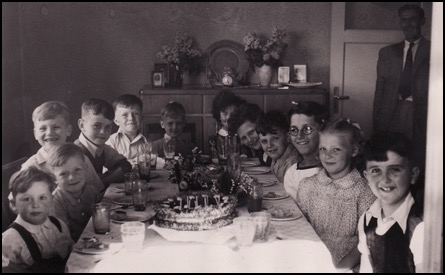
The block of flats we were in had once been just one of probably four or five such blocks, but at the time we were there, it was just one of the two surviving after the massive bombing of Hamburg. It is etched on my memory, the devastation between where we lived in Alsterdorfer Strasse, just a short distance from Fuhlsbüttel Airport, and the city itself. I still see us playing in the bombed-out remains of the blocks that had been destroyed, and finding remnants of personal belongings that had once belonged to the occupants. All through my secondary schooling, and for years afterwards, I used a Tintenkuli fountain pen that I had found amongst the ruins – lost later, sadly.
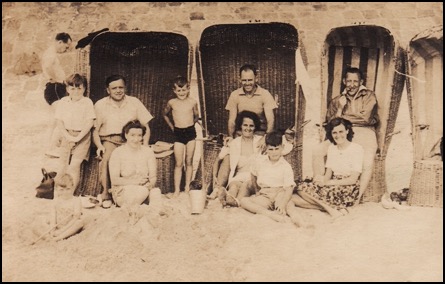
The photograph above is a holiday snap that was taken on the beach at Norderney, where we stayed in the summer of 1948; it’s not a great photo, with its age and the sepia look, but it certainly conveys atmosphere and history. I remember it being very hot there that year, but with a very strong wind constantly blowing in off the sea, hence the basket-weave “deckchairs” in use by the adults. The family of four on the left was called Minty, and they must have lived in a flat near ours as the elder son also appears on the birthday photo sitting on my left. My father and mother are in the centre, with me sitting on the sand and my younger, by two years, brother, Ian, standing up in the fetching black woollen bathing suit. The couple on the right, whom I remember as being childless, were called Judd, and I well remember them living in a flat very close to, in fact, overlooking, I’m pretty sure, the school I attended in Altona. I recall that we all stayed in a rather nice hotel, and also that, with fathers in attendance, we boys had great fun exploring what I can only imagine were Second World War German fortifications of some sort.
I had learnt to ski whilst in Austria, and I recall our taking a winter holiday later that year at a place called Bad Harzburg, again staying in a very smart hotel; sadly, I have no photographs of that holiday. I do remember spending most of my time on the ski slopes and also seem to have, somewhere in the back of my mind, the knowledge that we were sometimes very close to the border between East and West Germany – am I only imagining it, or do I truly remember seeing East German border guards patrolling that border?’
Many thanks to Brian for sharing his photographs and memories. And if you recognise anyone in his photographs (maybe even yourself), please e-mail TACA, and we’ll pass on your message.
PERSONAL STORY: MEMORIES OF POST-WAR BERLIN
When, a few years after the end of World War II, Mrs Elizabeth Robertson, the daughter of Major General Geoffrey Kemp Bourne (later General the Lord Bourne, GCB, KBE, CMG), moved to Berlin with her family, the former and future capital of Germany was divided, with the Soviet Union occupying East Berlin and the American, British and French sectors constituting West Berlin. Although the Berlin Wall had yet to be constructed, relations between the Soviet Union and the Western powers were becoming increasingly hostile, contributing to the Soviet-imposed economic blockade of West Berlin. This lasted from June 1948 until May 1949, and was circumvented by the Berlin Airlift that Mrs Robertson recalls below. Mrs Robertson's reminiscences originally appeared in the May 2008 issue (No. 149) of Pennant, the journal of the Forces Pension Society (see http://www.forpen.org for more information), and TACA thanks Mrs Robertson and Pennant for permission to reproduce them.
'My father took over the job of British Commandant in Berlin from General Herbert, when the airlift was already in train, and it then continued for some months. The planes flew constantly non-stop over our house and, together with the French and Americans, kept the city alive.
I offer some memories of that time: the lovely house and garden on the outskirts of the city, sloping to the edge of Lake Havel, and which I think belongs to a German industrialist; summer parties on the terrace; a garden party for displaced persons from the Russian Sector; sailing on Lake Havel; and on the opposite side the woods and beach enjoyed by Berliners; the grey grimness of much rubble still; and no entry to the Russian Sector except by strict permits, some for permission to go to the opera. Hitler's Bunker and Spandau Jail, and, of course, the famous Olympic Stadium; overnight journeys by train from Berlin to the British Zone and vice versa, and sometimes by car down the autobahn through the Russian Zone without stopping.
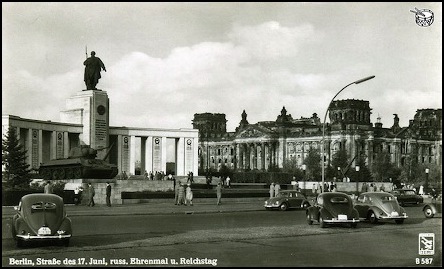
Above: A postcard, dating from the 1950s, showing the Soviet War Memorial on the Straße des 17. Juni, in West Berlin's Tiergarten district (in the British Sector), and the ruined Reichstag.
The British way of life had to be separate, with its own currency, bus transport etc. The only leeway I had was once or twice to visit the home of my music teacher in the American Sector (she had two harpsichords, which took up most of the room) and to go with her to a carol concert in a large church in the Kurfürstendamm, which was unforgettable.
An erstwhile ADC of my father's went back in recent years to the house we lived in and found little had changed and received a warm welcome. My mother took great care and delight in the garden, and the large greenhouse was full of cyclamen plants in the winter, which could either be piled into the house or even picked, there were so many. I often think the German gardeners must have been consoled by such enthusiasm, the results of which contrasted so greatly with the surrounding circumstances of hardship and deprivation and such destruction in the city. Although I learnt German, it is my regret that I was unable to go around freely except on an occasional bus.
Plainly my father did his very best for the people of Berlin, and they were immensely grateful. Although I did not know it at the time, he resurrected the Tiergarten with seeds specially chosen for the soil and collected in Britain, and he also built a church for the British community.
I am sure that some of you reading this will have other and completely different reminiscences, and will remember far more than I have written here.'
Elizabeth Robertson (née Bourne).
PERSONAL STORY: BERLIN, 1948 TO 1951
In the following account, Tim Sanders describes the excitement of travelling from England to Berlin in 1948, and of settling into a war-devastated city that had been divided into four sectors controlled by the four occupying powers. He continues by describing the life that he led as an army child in West Berlin – then a frontline city on the very edge of the Iron Curtain – at the start of the Cold War era, until his father was posted away.
'I was born in Hertfordshire in 1944, was evacuated to Wales and then lived with other family members in Kent and Guernsey after the war ended, our house in Finchley, north London, having been destroyed by bombing. Indeed, my first flight ever was at the age of three, when I flew in a De Havilland Rapide biplane from the then Croydon Airport to Guernsey, to live with my maternal aunt for several months; the eventual return to the mainland by boat to Weymouth was a distinct anti-climax. All this time my father was still serving abroad in the King's Own Yorkshire Light Infantry, transferring in 1947 to the Royal Tank Regiment. We were living in Farnham, Surrey, when he was posted to Berlin, and we were to follow.
The route was from Farnham to London Waterloo Station, and then to Liverpool Street Station for the boat train to Harwich Parkeston Quay. After that, it was by overnight boat to the Hook of Holland for one of three military trains taking military forces and their families to selected areas of BAOR (British Army of the Rhine). For those going to Berlin, it would take all day, from 0700 to 1730, to reach the border between the British Zone and the Russian Zone at Bad Oeynhausen. A change of trains here, with a short stay in a local hotel, would be followed by a journey on the sealed and guarded overnight sleeper train through the Russian Zone, reaching Berlin at around 0600. The train consisted of only a few coaches, guarded by an officer and several men, all armed, and with live ammunition. So it was to be a long journey, and it was very exciting for me to be going abroad for the first time.
I have a range of particular memories of this journey. They start with the dark and dingy recesses of Liverpool Street Station: smoke and the smell of hot engines, steam and bustle, hot metal, whistles blowing, doors slamming and the dimly lit compartment booked for my mother, my younger brother of only a few months of age, and me. Then the dingy cabin, somewhere in the depths of the ship, allocated to the three of us, followed by the bitter cold of the Dutch morning air as we walked 200 yards from the ship to the waiting train, through military police and immigration checkpoints. I think that the "Berlin" train was Train A. We had our own six-seat compartment, and for me the big attraction was the huge picture window so that I could see everything much more easily than from British carriages.
The seemingly endless journey, at never more than slow-to-medium speed, took us across flat Holland into Germany. We passed tens of miles upon tens of miles of wrecked rolling stock, some already rusting, with bullet holes plain to see, some semi-burned out, all seemingly parked to await their eventual fate, and all clearly looking to me, even at that young age, wrecked beyond further use. I was very glad to have my big window to look out of because the corridor down the other side of the carriage was always full of soldiers in their khaki battledress uniform. They came from various organisations, many of them with white-lettered-on-red-background shoulder flashes giving the titles of their units or service. They were all smoking, so it was very stuffy walking down the train for the meals that we had in the open-spaced dining car.
By the time we reached the evening pause point at Bad Oeynhausen, I was thoroughly exhausted, and I can just remember tumbling into the bed in the sleeper train – again, a first for me. The blinds were supposed to be kept down all the time that we travelled through the Russian Zone, but I remember that the jolt of the train stopping woke me up in the middle of the night and that I then decided to have a peek out of the window. However, all that I could see was a poorly lit platform with nobody there – and the next thing I recall was arriving in Berlin to drive some distance to the requisitioned family house in Charlottenburg, a well-to-do residential suburb in the British Sector of the city. Number 10, Warnen Weg, had escaped the bombing – and is still there as I write today (in 2008). Even at that early hour of the day, I remember that many of the buildings that we passed were in ruins, and that in some streets it was necessary for our vehicle to drive in a series of "S" bends in order to keep moving forward. It was a day or so before I had recovered from what was, for me, a very exciting journey, but some 60 years later, I still love travelling internationally.
SETTLING INTO A PARTITIONED CITY
Warnen Weg, in Charlottenburg, was only about 10 minutes' walk from the British Officers' Club, and also from the NAAFI Families' Shop. That was on a big roundabout, then called the Reichskanzlerplatz (literally "Reichs Chancellor Place" in English), but since renamed in order to be politically correct in the post-war era. Warnen Weg itself was seemingly a long road in my memory, but I was then a small boy, and it is, in fact, only about 100 yards long. The houses at each end of the road had been completely or partially destroyed, and as a small boy, you could wander in and out of them at will. One bungalow had housed an architect's business and contained hundreds of building plans, as well as all of the normal household contents. Several other army families lived in Warnen Weg, most of the fathers being captains or majors.
Our four-bedroomed house in Warnen Weg is still there today; it would be some 25 years later, in the second half of the 1980s, that I would revisit it. We had a large staff as a contribution towards raising employment levels amongst the Berliner population and getting the economy back on its feet. I don’t know what they were paid, but the fact of a job was an obvious morale-booster. We shared our boilerman with No 6 and No 8, the coal-stoked boiler being vital in winter. I suppose that he slept in one or all three of the houses – he didn't have his own room in the basement. We had a live-in cook/housekeeper, a kindly lady called Herta, whose family had all been killed. Herta had one day off a week and she lived in the attic level of the house. We also had a cleaning lady who would come in some days a week – and all of this for my father's rank as a junior captain. But these were very unusual times, of course. I remember vividly the huge double radiators under the very large, double picture windows that kept the house airy, yet warm, in the winter. The window handles were too heavy for me to operate. I started my stamp collection in Berlin. German stamps with face values of millions of marks from the 1930s' period, when a suitcase of banknotes was needed to buy a loaf of bread, were still very easily obtainable from the few stamp dealers in business then. I would walk to the NAAFI shop to buy my latest stamp collectors' magazine, much of it above my head, but you had to start somewhere; then I would sit at home by the big radiators in the winter sunshine to read up on the latest news.
Winter in Berlin could be very cold indeed; it is easy to underestimate how far east Berlin lies, and its relative proximity to Siberia. One day, I was outside in brilliant sunshine for over two hours, without any protective hat, and the wind-chill factor must have been very high. I got second-degree frostbite on the edges of my ears, and every summer for at least 20 years after that my ears would blister and peel in the summer sun.
My father was a captain, the second-in-command of the Royal Tank Regiment's "Independent" tank squadron, a token presence in Berlin of some 15 to 20 tanks, surrounded as the city was by the Russian Zone, then containing thousands of Russian troops and, no doubt, hundreds of tanks in numerous tank divisions and mechanised infantry divisions. I expect that the Americans and the French had some tanks, too, in their respective sectors of Berlin, but I never saw them. The British Sector contained Spandau Prison, where the British forces had the rotational task, shared with the other Allies, of guarding Rudolf Hess. I suppose the token British tank squadron was an early forerunner of tripwire diplomacy as it wouldn't have lasted five minutes against the Russians. There was a real concern amongst the adults regarding what the Russians could do if they chose to, but like many other such very real threats, we lived so close to it every day that we tended to ignore it in favour of getting on with day-to-day events. This was so even in 1950, when memories of the Berlin Airlift of the previous year [June 1948 to May 1949] were still crystal clear.
These were pre-Wall days, and you could visit the Russian Sector of Berlin out of sheer curiosity. The reader should remember that the Russian "Zone" that surrounded Berlin was the region that began once you reached the "outward boundary" of each of the four "sectors", i.e., the British, American, French and Russian Sector respectively. The Russian Sector's border with the other three sectors was also the border between West Germany and East Germany, so in order to buy anything in the Russian Sector, you had to obtain East German Deutschmarks. The rate of exchange was 4 East marks to 1 West mark, but the point was that only three items were really worth buying. Firstly, there were the carved Russian dolls in wooden, brightly painted "nests", probably three or four dolls to a nest, which would be about 6 inches high at the most. Secondly, 33 rpm long-playing records by Polydor of classical music were popular with the adults, for those that had record players (we didn't have one). Thirdly, tickets for the East German opera house were popular for monthly visits by the British (my parents went occasionally). I saw my first Russian soldiers at the daily guard-changing ceremony at the Soviet Army War Memorial (pictured at left in 2007) in the Russian Sector.

You could also pass through the Russian Sector by taking the S-Bahn (the "S" stands for both Stadt, or "city", and Schell, or "fast", in German, an English aide-mémoire being "S" for "surface") suburban train, or a U-Bahn ("U’ standing for Untergrund, or "underground") train. The various routes for these trains crisscrossed between the fringes of the Russian Sector, on the one hand, and the other three Allied sectors, on the other hand. You had to be very careful indeed not to alight from these trains within the Russian Sector because to do so as a family unit without a uniformed Allied forces member present was strictly forbidden, and would have caused a local incident of considerable proportions. It always felt a bit worrying when transiting these bits of the Russian Sector, but nothing ever went wrong for us.
I have a strong recollection of the pungent smell of cigars that was always present in public places, especially on buses, trams and trains. ("No smoking" carriages hadn’t been thought of yet.) The same smell was ever present in the concrete fortifications that still lay everywhere, wide open to inquisitive investigation by a small boy such as me. (I had experienced this before on Guernsey, in the massive towers and bunkers built there by the Germans.) It was as if the smokers had left only yesterday.
My father obtained for virtually nothing a former Mercedes-Benz four-seater staff car as a family car. It had a brown fabric roof that folded right back and rested on the rear of the back seat. It was coloured medium green, had very big headlights, a big wooden steering wheel and looked very grand. There was a Union-flag metal badge on the front and back bumper, as required by Allied occupation rules. It would be a classic car if it was around today in 2008, and was exactly the model that senior German Army officers had used in Hitler's army. Petrol was rationed somehow, and as most places that one needed to reach were within walking distance, the car was normally used at weekends only.
We used to go sailing at the British Officers' Yacht Club at RAF Gatow, on the river Havel, in the forested area called the Grunewald. This is one of the "green" areas of Berlin and is still there today. The river widens out to some 984 feet or more, and there was plenty of space in which to sail. I learned to sail in Berlin, mainly in a four-berth Bermudan sloop about 35 feet long, known as a "One Hundred Square" because that was the area of its mainsail. There were two or three of these large yachts and a further dozen or so half-decked racing yachts, known as the "Star" class, all requisitioned from German sources.
There was an island that we used to circumnavigate about 30 minutes from the moorings; such a sail took most of the day because the wind direction required many changes of course rather than a simple, straight-line approach and return. The Pfauen Insel (Peacock Island) lay beneath a rocky promontory on the river bank, which had a Greek Orthodox church on top of it. At midday daily, the bells of the church tolled out the melody "Now Thank We All Our God". You had to be careful when going around the island to keep well inside a line of yellow buoys marking the line of the Russian Zone (not the Russian Sector) across the river Havel. Once one of the "One Hundred Squares" caused an international incident in daylight by crossing the line and continuing onwards. It was rewarded with a burst of machine-gun fire through the mainsail, albeit well above the heads of the crew. It was only then that the yacht went about and returned to the right side of the border.
The back of the sailing-club building was on the Russian Sector's border, I think. On occasions, cases of vodka would be handed through a back window by a Russian in exchange for cases of whisky handed back by a sailing-club member.
I drank my first ever Coca-Cola at the US Officers' Club, which seemed to me to be a very grand building in comparison to the single-storey British Officers' Club. I will never forget the look and taste of this fizzy, dark-brown, sweet liquid, chilled to a very suitable coolness and very delicious. It was a great change from the usual fizzy ginger ale that was the only special drink available as a treat for a small boy at the British Officers' Club.
Our chief food supply was the daily ration truck; it being 1948, rationing applied here just as it did in England. A cardboard box provided our staple food for 24 hours. There was always greengage jam – no other flavours. (In later life, I became a marmalade gourmet in retaliation!) Buying food in the few food shops that were open in the city was subject to very strict rules, not to mention the intermittent availability of the food itself. Dairy produce of any kind was strictly forbidden as the hygiene system was still being re-established. Vegetables could only be bought at certain open street markets or shops, all listed officially. In any case, you needed West German Deutschmarks to buy anything in the city; the army issued you with British Armed Forces Vouchers (BAFVs), which were paper money. There was even a 3-penny paper note as the smallest-denomination paper money within the BAFV range; it was about the same size as today's 5-euro note and it was coloured a sort of orange brown. My pocket money was 1 shilling a week, so the 3-penny note was important to me as a quarter of my weekly income.
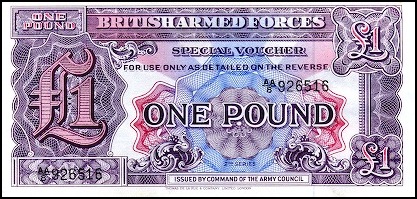
Above: A £1 British Armed Forces Special Voucher (2nd series, issued in 1948).
If my mother took me to the shops other than the NAAFI, we used to get a snack consisting of a Bockwurst (a boiled sausage) and a bread roll with mustard. These were available from a multitude of little stalls on wheels that were very much a part of the street scene then, standing on many of the corners of main street intersections in the city centre. Heaven knows what was in the sausages, but they never did us any harm and they were a huge relief after the British rations – especially the dreaded greengage jam!
When shopping, we used to visit the well-known department store called KaDeWe (pronounced "KarDayVay") quite a lot. The name is an abbreviation of the words Kaufhaus des Westens ("Department Store of the West" in literal English translation). I don't know how much of the bombing it escaped, but it certainly must have been one of the first shops to be reinstated as it had always been a focal point on the Tauentzienstraße, adjoining the main shopping street, the Kurfürstendamm – rather like Selfridge's position on Oxford Street, London. In my day, it had four floors; today, in 2008, there are six or seven. The presence, and reasonable stocking, of the shop was very much one of the key demonstrations by the Berliners of their determination to get back on their feet after the war, and I know from comments made by our house staff of Berliners that they were proud of the fact. It was only 100 yards or so from the famous Kaiser-Wilhelm-Gedächtnis-Kirche, the bombed church whose remains stand today in the centre of the Kurfürstendamm as a memorial to the destruction of World War II. On the top floor of the KaDeWe (pictured at right in 2007)
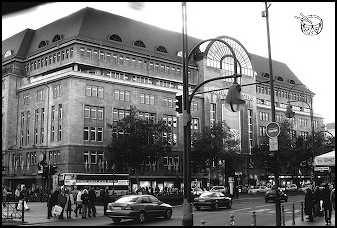
My primary school in Berlin was a former three-storied Schloß (castle, or fortified mansion) in its own substantial grounds on rising land. It had been converted for its new task by the BFES (British Families Education Service), the British forces' educational authority, which also ran secondary education at two boarding schools in the British Zone of Germany, as well as a range of other primary schools at the British garrisons there. The BFES was not to be confused with the BFBS, or British Forces Broadcasting Service, the British forces' own radio-broadcasting service. The Americans had AFN, the American Forces Network. I expect the French had an equivalent, though I never heard it. The BFBS was an important link and morale-sustainer for the British and their families, surrounded as we were by Russians who might invade and roll over the city at any time, as it seemed. My classroom was on the first floor and had a good view over the surrounding city. When it snowed, we tobogganed down the lawned slope at the front of the school. This was the first of three such BFES schools that I attended in BAOR before going to boarding school in 1955 at Dulwich College, London. I must be one of a number of young people who, in history lessons, learned three times about the Romans, without ever getting past Julius Caesar's invasion of Britain in AD 44. Personally speaking, I am sure that the BFES teachers were very earnest, but I am not sure that they were very good.
I learned to swim properly in Berlin, having started to do so before leaving Farnham. In Berlin, the swimming club had the use of the 1936 Olympic Games pool, indoor in winter and complete with 10-metre diving-boards' structure. I and some of my chums soon learned to jump off the 10-metre board, but I was the first to dive off it. Years later, I was to become a trained military parachutist with ease, having no fear of heights. The British Officers' Club in Charlottenburg had a small outdoor pool, and for two years running I was the first to swim in it after Easter and the annual snow-melting.
The reconstruction of Berlin was a massive task, of course, and when I lived there, virtually every other building was in ruins and was spread halfway across the street, or so it seemed. Every day at noon, sirens wailed across the city and everything came to a halt. Then explosions began and continued over the next hour as structures were "blown down" to be cleared. Huge mounds of debris grew up in designated areas of the city; as boys, we called them "dubble rumps" (i.e., "rubble dumps"). It was these mounds that became the small hills and raised areas that constitute the little parks with grass and trees that you can see around Berlin today. In winter, we used these newly-formed hills as toboggan runs; they were very dangerous because we had no knowledge of how deep the snow cover really was, and you had to steer around all of the mangled bits of reinforcing metal rods sticking up all over the place.
LEAVING BERLIN
It eventually became time to leave Berlin as my father was posted to a Royal Tank Regiment base at Fallingbostel, one of the big garrisons in north-western Germany. It would take all day to drive there in our grand old Mercedes-Benz staff car. The first stage was to drive down the British Sector part of the autobahn to the Russian Zone border; this included driving along one side of the autobahn that had been the famous AVUS motor-racing circuit during the 1930s. The Russian Zone transit would take up to three hours, depending on how long any inspections at border checkpoints might take. This would include crossing the river Elbe on the still "temporary" wooden bridge built by the Russians after the Germans blew up the original structure on their final retreat to Berlin in 1945. It was still relatively unusual for British families to drive out of Berlin rather than take the train, but under the right circumstances I think that these road transits were encouraged as a demonstration of the Allied right to do so. We had a large envelope of instructions, some written in Russian, but we were warned that most of the guards could not read and that we were not to laugh if they studied the papers obviously upside down. No stops were permitted, driving was to be at a certain steady speed so that the Russians could estimate where one should be on the route at any time, and so on.
We had been warned about the "duty nail-hitter" who would hold up progress at the river Elbe bridge, which was about 200 yards long and built of huge balks of timber, with a planked surface to drive on, in a one-way-only traffic system. True to form, as our car, with its prominent Union-flag metal badge, approached the bridge threshold, a character in overalls, carrying a large carpenter's cloth bag, appeared from nowhere some 50 yards in front of us, on the bridge, and raised his hand to stop us. He then took five minutes to select a good spot for the longest nail that I have seen to this day, and then slowly, and deliberately, banged it home into the decking. Every few strokes of the hammer, he would look up and grin, as if to say, "We control this road, you don't". Eventually, he decided that he was ready and waved us forward with much ceremony. The rest of the Russian Zone crossing was uneventful; it was in daylight, of course, and you couldn’t see much from the autobahn. I so clearly recollect that everywhere was totally deserted – there was not even an animal in a field – and, of course, there were no service stations. There were no other vehicles on the other carriageway either, just miles and miles of autobahn in indifferent states of repair; we could almost have been on the moon, and my mother said that it gave her the shivers.
"THE RUSSIANS ARE COMING!"
I have kept until last a story of the terror that I experienced one night. I awoke in my bed to find the sky filled with flashing lights accompanied by a cacophony of bangs, crashes, whizzes, whooshes and so on – non-stop. Huge flashes of light were penetrating the curtains – surely this was the long-awaited Russian attack on Berlin that the adults had talked about. I knew exactly where my father kept his emergency bag that he would take on the crash-move exercise that they practised against such an event. I also knew that Herta, the housekeeper, was staying with friends, so I ran downstairs shouting, in the hope of finding my parents. It took the very surprised babysitter several minutes to calm me down, explaining that this was my first New Year's Eve in Berlin, complete with the customary fireworks that I had never experienced before!’
Tim Sanders (b.1944).
PERSONAL STORY: CONTRASTING CHILDHOOD EXPERIENCES OF JOHOR BAHRU, MALAYA, AND NEWCASTLE UPON TYNE, 1950S
Trish Bailey (née Boyle), whose father served in the Royal Northumberland Fusiliers, has contributed some recollections of her life as an army child to TACA, and we are immensely grateful to her for the following insights into her childhood. (And see also ‘PERSONAL STORY: ‘KHAKI SUNSET: THE TRANSITION FROM MILITARY LIFE TO CIVVY STREET’ for her reflections on leaving the army environment.)
‘We arrived in Johor Bahru, Malaya, in 1950. I recall little of the voyage worth remembering, but my first distinct memory was after we had disembarked at Singapore. I remember standing with Mum and my brother, Stephen, outside a small shop, just off the docking area, waiting for Dad. I don’t know where he had gone – possibly to finalise some procedure or other. While we waited, a man passed, said “Hello” and went into the shop. Mum mentioned that he was the captain of the ship. When he came out, he gave Stephen a red car and handed me a small, dark-blue bottle of perfume. I have no memory of what happened to this; possibly my mother thought it an unsuitable present for a child of seven. (During the 1960s, this memory returned when a particular dark-blue bottle of “scent”, as we called it then, became the favourite of many girls, including me: it was called Evening in Paris. It may not have been the same, but the bottle certainly triggered that memory of the gift I had received all those years ago in Singapore.)
It was getting on for dusk when we arrived at our bungalow in Johor, although it was probably still evening, or maybe even late afternoon, because dusk comes early in the Far East. I remember the taxi pulling up outside and immediately our amah, the Chinese house servant that all Europeans were lucky to have, came to the door, bowing and smiling a welcome. I was transfixed by her gold teeth! There were also a couple of other Chinese women and a small child with her, also smiling. I don’t know if they were friends of hers or relatives, but they weren’t part of the set-up and left on our arrival. I don’t remember anything else about that day, but I imagine that we were pretty tired and went to bed early.
OUR IDYLLIC DAYS IN MALAYA
The following day, Stephen, ever the adventurer, went outside and quickly came running back in with an exciting tale: “Mum, there are flowers outside and when you touch them they close up!” Of course, we had to go and look! They weren’t flowers, but small weed-like plants related to mimosa that were known as “touch-me-not”. They were a constant fascination to us, for several days at least, but probably more like weeks.
What I especially loved about the Far East was having a verandah. Ours was tagged along the back of the house, and on one side stood a huge, American-style fridge, a “Frigidaire”. Just to open the door and feel, as well as smell, the comfort of freezing air hitting us was a blessing! The verandah was an oasis during the heat of the day, but by evening it became something magical. Sitting in this neither-indoor, neither-outdoor construction, under the soft, inky-dark sky dotted with its sequins of stars, with the hypnotic sound of cicadas and frogs below, and the tiny pulsating lights from fireflies twinkling in the shrubbery, was the signature of nightfall in the Far East. The verandah was often a good place to begin the day, and in the early evening we children would sit here, to collect ourselves after the day’s play outside before going to bed. Later in the evening, our parents would remain and have a glass or two. There would be the murmuring of voices and the clinking of ice in glasses, which had condensation running down the outside. The butterflies of the day would be replaced by moths, big and bold, while some, just as pretty as their daytime counterparts, fluttered around bumping into the lamps and anyone who happened to be in the way. Chit-chats, small gecko lizards, spent their time running up and down the walls, inside the house as well as outside. Poor Mum was afraid of them, but she became used to seeing them, and I think that the fact that they kept themselves above floor level, while being excellent at not falling down, allowed her to relax. We kids were fascinated by how they would let go of their tails as a means of escape if anyone held them, although in time new ones would grow. These little creatures were necessary for dealing with the flies and mosquitoes and other nasties not quick enough to dodge being caught by their fast-flicking tongues. All life could be seen on the verandah – it was an enchanting place!
Going to bed was another pleasure as I felt cosy and protected lying under the canopy of a mosquito net, with just a cotton sheet – white army issue! – to give light cover, while the gentle whirring of the fan above sang its own melody, and the chorus outside didn’t miss a beat. Across the way, over the large monsoon drain that we kids liked to play upon by trying to run across without falling off, was the NAAFI block, and one particular song that I recall from then, which must have been the in-song of the day, was “Wheel of Fortune”, and Kay Starr’s voice appealing to fortune’s wheel would give a final blessing to the day as I drifted off to sleep. I have forgotten to mention the routine of the spray gun, or Flit pump (which sprayed dichlorodiphenyltrichloroethane, or DDT) that Amah would use in the bedroom to finish off any lurking baddies not dealt with by the chit-chats. Imagine using such a thing inside today!
The families lived in whitewashed semi-detached bungalows that stood in one long row - hence the name: Long Row. An aerial view must have given them a likeness to a cemetery! We lived at number 28a and were in about the middle of the row. The uncarpeted floors were tiled, and Amah used to polish them, on her hands and knees, with red Cardinal polish. She clearly did a good job because I don't recall any of the polish coming off on our clothing.
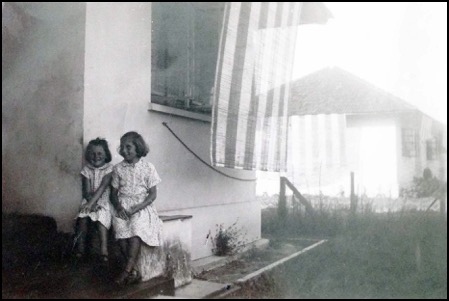
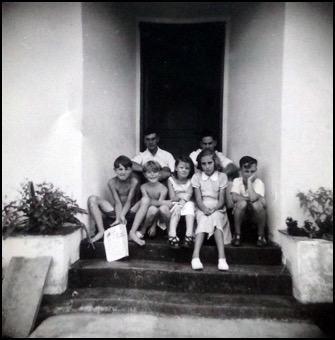
SCHOOL, SHOPPING AND THE ZOO
School was attended for only half a day, Saturday included, on account of the heat (I imagine), and in order not to give us extra playtime. However, we grabbed the opportunity whenever it was handed to us and, funnily enough, didn’t suffer from sunstroke or even sunburn. Although I do remember Stephen having a bad case of prickly heat shortly after we arrived, we quickly acclimatised. Our school was a small building just a stone’s throw from home – at school I would sometimes see Amah going about her work! One memory of school must have been of the first Christmas that we were there. My class was busy gluing strips of coloured crêpe paper prior to making chains, and each desk had a glass pot of glue with a brush standing in it. Engrossed in my task, I became aware of the piano starting up and then voices from another class. I couldn’t remember hearing the carol before, and was captured by the haunting melody. “In the Bleak Midwinter” remains my favourite carol to this day. The conflicting lyrics that were being sung when we lived under a bright-blue sky didn't register with me! (Even the frequent rain didn’t cast a gloomy outlook and, unlike in northern Europe, it was soon over and the sun would be out again, leaving not a trace of damp.)

Another memory of being out in the Far East, which was most probably an everyday occurrence (although possibly not so in today’s new world), was the shopping experience. The streets were busy with all manner of traffic: human, motorised and pedalled. Those not in motion sat at the roadside chatting and smoking, feeding children or playing mah jong. The high lilt of Chinese singing wafted from open windows or doors, and, of course, there would be a delicious smell from cooking. I recall us going into Johor town to buy a rug one day and, as we entered the small shop, we were followed by a couple of chickens! They were quickly shooed out, squawking and clucking, with a broom. The chickens could easily have been a dog or goat as such scenes were normal.
One particular memory for me is of the time that we went to the zoo in Johor. We were sitting in a cafe having ice cream – this was served in a glass dish that had a stem, and on top of the ice cream was a wafer, which I think was pretty standard in those elegant days. Anyway, Stephen and I asked if we could go downstairs to look at a young elephant that was tethered to a post by a chain around one, or possibly both, hind legs, but was otherwise able to move around. Permission was given, and off we went, stopping at a stall en route to buy a bunch of bananas. The bananas, a particular variety, were very small, sort of adult-finger length, with many on a bunch. I was in charge of feeding. All went well to begin with, but, as the bunch was depleted, I found it difficult to remove the bananas, which caused the elephant to become impatient. Its trunk kept swaying towards me, and I remember feeling its breath on my arm. I became quite nervous, so handed over the rest of the bananas, complete with stalk. They were greedily grabbed and shoved into its waiting mouth, but instantly there came a piercing scream, and the bananas – still with attachment – were pulled out and thrown at me, hitting me on my upper leg. In the next moment, the trunk reached for Stephen, who was standing close by, and pulled him to the ground. He lay face down, with his head a short distance from one raised leg. A Sikh gentleman standing in the group pulled Stephen away by his legs just as Mum and Dad came running up. The rest of our visit is a blank, but I remember leaving the zoo very soon afterwards. (I would like to mention the following connection, although time has moved on some years in the meantime. I was now “wife of” and living in Germany. One very hot late-July day, my husband and I had gone to the zoo. We stood at the elephants’ enclosure eating ice cream. As I licked my cone, one of the elephants stretched out its trunk towards me and I playfully, but pointedly, pulled my arm away, telling it “No! Go and buy your own!” The animal immediately turned around and trotted off, and we continued watching the rest of the herd. Within seconds, the rejected elephant had come back again and pointed its trunk directly at me through the metal railings. It then sprayed me with muddy water! It was an unbelievably calculated act! We were both astounded that an animal could assess something in such a deliberate way.)
BACK TO BLIGHTY AND NEWCASTLE UPON TYNE
Sadly, our time in Malaya came to an end and we were once again driven to the Singapore docks, where we boarded the troopship the Empire Windrush, which was bound for Blighty. There was another person with us on the outward journey that hadn’t been on the inward: my one-year-old brother, Martin! He had been born in the British military hospital (BMH) in Singapore.
Every day of the journey to England was quite special. There were new playmates for one thing, and we liked running around below decks, to which, on occasion – possibly because we made enough noise – one of the crew would come down and direct us back up on deck. There used to be two sittings for mealtimes, with the children going to the dining hall first. When we left the hall after the evening meal, the signature tune of Winifred Atwell’s “Black and White Rag” always played to let the adults know that we were on our way out.
We disembarked for a short period at Port Said one evening, being taken across by small boat, leaving the Windrush in a blaze of lights to await our return. I don’t think that we spent much time in Port Said, but I do remember having a meal in a small café. One of the highlights of being on board was the slow cruise along the Suez Canal. The view from either side of the ship was fantastic, and we would run from one side of the ship to the other to see as much as we could.
Like all good things, that idyllic time quickly came to an end. We docked at Southampton on a rather cloudy day. I looked around at the other ships, some blending in with the gloom, and wished that we would turn around and head back East. We travelled to the north by train, first staying for a short time at a transit camp in Hull – Tranby Camp, I believe it was called – before going to Newcastle upon Tyne, where we occupied a quarter in Fenham Barracks. I didn’t think that I would like it there, but I was soon proved wrong. My two best friends were Pat and her sister, Sheila Colclough. Our flat was in a block that faced the parade square. This was frequently in use for “square bashing”, and I remember Martin, my little brother, standing at the fence watching the soldiers practising bayonet drill. When the command came to “Charge!” Martin turned and began to run for home, crying “Mummy!” The square was also used for the Northumberland Fusiliers’ band's more refined practice sessions. (Pat and Sheila’s father was a bandsman.) Saturdays saw us making our way to the Plaza cinema for the matinée. We mostly watched cowboys-and-Indians films and would leave for home belonging to one camp or the other.
All the other kids went to the local school, whereas I went to the Sacred Heart Convent in Fenham, getting the bus just outside the main gate. Another memory was of having a needlework lesson at the convent. Needlework was not one of my favourite pastimes, and that hasn’t changed over the years – I’d rather pay someone to sew than tackle it myself. At the time, we were making nightdresses, having progressed from aprons. The garment in question would have served young Victorian ladies to perfection, being high-necked and having sleeves reaching to our wrists, with the dress itself finishing just above the ankle. (Oh, the sauce of it showing our ankles! And if this wasn’t bad enough, the nightdresses were made from winceyette!) On this one particular day, I had already had to unpick the same seam twice as it wasn’t satisfactory. When I took it up for inspection for the third time, I was again told to redo it. Feeling pretty frustrated and upset, I returned to the sewing table amid the clattering machines and decided to rebel. I would not undo the seam again! After a suitable time had passed, I took the nightdress for its fourth inspection – it must have seemed to any onlooker that it and I were on a piece of elastic! I waited for more disapproval and was genuinely confused when I was told, “Now that is much better! Why couldn’t you have done it like that to begin with?” I never wore the nightdress!
I WOULD LIKE TO RECONNECT WITH MY CHILDHOOD FRIENDS
I could give more memories but feel that I have outstayed my welcome now. I would love anyone who remembers me, Patricia Boyle, as I then was, to get in touch (by e-mailing me at trish.bailey@ntlworld.com), particularly Pat (née) Colclough and/or her sister, Sheila, and, not mentioned in my memories, Jennifer, Patricia and Helen Phillips. Also, Dorothy, Suzanne and Kathleen Simblet. They were not in Fenham with us, but in Catterick Camp. Their parents were friends of mine.
I do have one photo of the Colclough family (below), which was taken in their married quarter in Fenham Barracks, Newcastle upon Tyne, in around 1956 or 1957. Pat (on the far right of the photograph) and Sheila (on the far left) were the eldest of many siblings, and if it helps in my search, the others were: Malcolm, Dorothy, Lilian, Wendy, and the last was a baby, whose name I don’t recall. If memory serves, their father's name was Ron. Their mother was Ann.

I remember them as being a happy, close family, unlike mine. I often think about them, and wonder where they are and how their life panned out. One memory I have of Pat is of the two of us falling in love with Audie Murphy, after seeing him in To Hell and Back at the cinema one day. We would write letters to ourselves, pretending that Audie had sent them. One day Pat “received” a more loving letter than I did, and this caused us to fall out – but not for long! They were very innocent times!
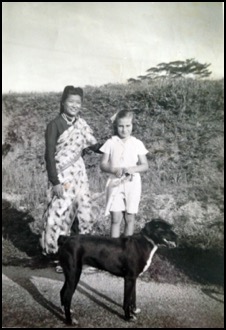
The photo at right, which shows me when I was nine, was taken in Johor in 1952. I was then three years younger than when I knew the Colcloughs, but might still have resembled the “Pat” that they knew. (I also wonder if my little friend and next-door neighbour, Susan Dolman, or her two brothers, David and Anthony, might recognise, if not me – they knew me as Patricia – then our address: Long Row, Majadee Barrracks, Johor.’
Trish Bailey (née Boyle, b.1943).
PICTURES: AN ‘HONORARY ARMY CHILD’S’ PHOTOGRAPHS OF ASPECTS OF AN ARMY CHILDHOOD IN HAMBURG, (WEST) GERMANY, EARLY 1950S
‘Honorary army child’ Horst Schlüter, also known as William (Willy) Simmons, attended the British School Hamburg, in (West) Germany, during the 1950s. Horst writes: ‘My dad (stepfather), ex-RAF, was employed by the then Imperial War Graves Commission, later the Commonwealth War Graves Commission. In those early years, Commission members, although civilians, had military status and therefore access to most facilities, such as rations, the NAAFI, the recreation centre at Scharbeutz and education. I was enrolled at the British School Hamburg prior to taking the Eleven Plus exam, which I passed possibly at the end of the first year, after which I attended what I remember as being the "secondary modern grammar stream", the foreign languages taught being French and German’. He has kindly contributed three photographs to TACA from that time, with the rueful comment that ‘regretfully, I'm beginning to have difficulties remembering teachers' and pupils' names’. Horst’s photographs and accompanying captions appear below.
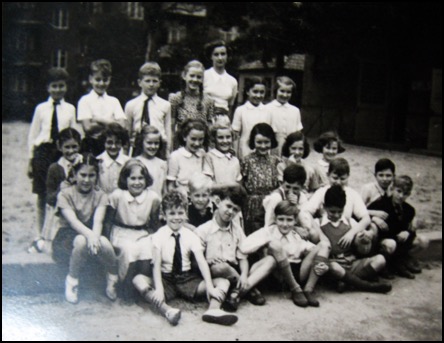
Above: 'The first form, British School Hamburg, possibly after the summer break in 1953. Our teacher was Miss Mackenzie – or perhaps Miss Williams? The more I try to remember teachers’ names, the more confused I get: wasn’t Mary (Pinky) Mackenzie in my class pre-Eleven Plus? And wasn’t Miss Williams our French teacher? Fellow pupils’ names that I remember - although I'm not able any more to point them out - are Virginia Cook and Janet Bogardez (a Canadienne); there were possibly two Davids, David Green and David Ward, and there may also have been a Peter Short.'

Above and below: 'These two photos were taken at an NCOs’-/sergeants’-mess dependants' Christmas party in around 1951. I strongly believe the mess to have been situated at Arborfield Barracks, on Sengelmannstrasse. In those days, there was a number 9 tramline running parallel with the road, and it was only two or three stops away from Hamburg airport. Memory always told me that locals referred to the barracks as the Hanseaten Kaserne ["Hanseatic Barracks", but having meanwhile tried to confirm this, I’ve only found conflicting results.' Above: 'I’m the first boy on the left, sitting at the table.' Below: 'Here I’m standing at the end of the line on the far right.'

We are most grateful to Horst for having contributed these evocative photographs from his family album. If you recognise anyone in them (maybe even yourself), or can put names to faces, please do let us know.
PERSONAL STORY: BOYHOOD MEMORIES OF ROTENBURG, (WEST) GERMANY, 1952 TO 1954
TACA is indebted to ‘MW’ for expanding on his memories of travelling from ‘our familiar English Midlands civilian environment to a unique BAOR [British Army on the Rhine] military rural one’ in Rotenburg, Lower Saxony, (West) Germany, during the early 1950s, and especially for his recollections of day-to-day life there as an army child, along with his illuminating insights into aspects of his British Families Education Service (BFES) schooling during the early 1950s.
‘In early 1952, when I was aged nine years, my father was serving in Korea, but the rest of my family was living in a Victorian terraced house in Leicester. My brother and I attended a local boys’ prep school with a view to entering a local grammar school. There were about two-dozen boys in each year-form.
In June 1952, my father reported for duty with 31 Armoured Workshops, REME (Royal Electrical and Mechanical Engineers), based in Rotenburg Airfield Camp, Lower Saxony – somewhere on the North German Plain between Bremen and Hamburg. In mid-August 1952, my mother, brothers, sister and I joined him there. It took us two days to travel from our familiar English Midlands civilian environment to a unique BAOR military rural one. On the first day, we travelled for about six hours by British Railways steam trains from Leicester to Harwich Parkeston Quay (in Essex) via London. This was followed by an overnight passage in a troopship, the Empire Wansbeck – a former German ship – to the Hook of Holland. After breakfasting, we boarded a BAOR troop train, also hauled by a steam engine, and continued across The Netherlands and north-west Germany to arrive at Rotenburg that evening.
Our modern, German, detached married quarter (MQ) stood in its own grounds in a forest clearing near Rotenburg airfield. It compared very favourably with our previous English Victorian terraced house. The wooden window shutters and double windows (not double-glazing), as well as the opaque globe lighting with twist switches and Continental electric plugs, were quite a novelty. All BAOR MQs were fully furnished, including German-made, colour-coded domestic crockery: other ranks (ORs) – plain; warrant officers (WOs) and sergeants – blue bands; junior officers – blue-and-yellow bands; field officers – blue and gilding; general officers – crested. (Not that I ever saw any, but they were listed on every BAOR MQ inventory as, for example, “Cups, Tea, General Officers”!) Each family was allocated a monthly allocation of “breakerage” exchange points for replacements – any shortfalls had to be paid for on “marching out” of the MQ. We had to wait a couple of weeks for the packing cases with our toys, books and spare clothes to be delivered via the MFO (Military Freight Organisation) system. Our British bikes did not survive the battering from the local German cobbled roads and tracks for very long.
Our family was also taken on the unit ration strength so that our rations could be delivered weekly to our house by the unit ration truck. The fresh rations were stored in a fridge – quite a novelty, compared to the cold slab of an English larder. (I understand that which family received which cut of meat was hotly debated within the Unit Wives Club.) Shortly after we arrived, the milk ration was changed from tinned evaporated milk to fresh Danish milk in waxed cartons – another novelty compared to British milk bottles! We were discouraged from drinking local German milk because it was in short supply and not tuberculosis-tested. My mother was entitled to visit a B Class NAAFI (groceries and hardware shop) once a week – our nearest one was at Verden, a half-term trip treat for us – and an A Class NAAFI (clothing supermarket) once a month (our nearest one was in Hamburg, and this visit was the highlight of our Easter and summer school holidays). Our main currency was BAFVs (British Armed Forces Vouchers), in denominations ranging from 6d to £10; limited access to Deutsche Marks was controlled, and we therefore rarely visited the shops in Rotenburg, where I was puzzled by their strange sausages and flashy, lightweight football boots.
I think that the transport for these trips was provided from the unit’s scale of recreational “Occupation” transport, which included a big 32(?)-seater bus and a smaller 22(?)-seater bus; other recreational vehicles included Volkswagen minibuses and “Beetle” run-about cars. Most married officers and sergeants owned a second-hand, pre-war, mid-range Mercedes or Opel car. Coffee, cigarettes, spirits and petrol were strictly rationed by ration cards to counter black-market trading. On summer afternoons, we used to swim in the camp’s static water tank, while the soldiers were working in their workshops. A weekend afternoon visit to a local Bullensee (Bullen Lake) “beach” was our equivalent of a trip to the seaside.
At least a dozen families lived in requisitioned houses in Rotenburg, rather than in MQs on the airfield camp. You could easily distinguish a British MQ from a German house. German houses’ walls still had bullet holes in them, while the British houses neither displayed any lace curtains nor aired their duvets between 0900 and 1000 every morning (because we had blankets and eiderdowns on our beds). Virtually all of the German houses had temporary felt roofs; those houses occupied by British families were reslated first, in 1953. There was a major BAOR MQ building programme during the mid-1950s to enable the requisitioned houses to be handed back to their German owners soon after the signing of the “1955 Treaty” [the treaty ending the occupation of West Germany].
In April 1945, the Guards Armoured Division had fought one of its last significant actions of World War II near Rotenburg airfield, so there were still a dozen or so knocked-out, rusting Sherman tank hulks lying around the nearby woods. The bodies of the Guards tank crews who had been killed in action had already been reburied in Soltau Military Cemetery, but their temporary grave crosses remained near their tank hulks.
The only military parades that I can remember attending were two annual 7 Armoured Division Remembrance Day parades held in Shiel Barracks, Verden, and a big parade held in a Hamburg park on Coronation Day (although the highlight of the day was hearing of BFBS (British Forces Broadcasting Service) radio’s announcement of Hillary and Tensing’s conquest of Mount Everest). Flimsy airmail editions of the UK national newspapers, a couple of days out of date, as well as a limited selection of fortnight-old magazines and comics, were available from the local Red Shield (British Salvation Army) Club canteen.
Our local BFES (British Families Education Service) primary school was a requisitioned family house, 3 miles away, in the town of Rotenburg in Hanover (now known as Rotenburg an der Wümme). From Monday to Friday during term time, we used to travel from the airfield camp to our school in the town and back in a military vehicle without any adult escort. If the small unit bus was unavailable, we travelled in the back of an army 3-ton truck! The departure point was at the airfield barrack gates beside the unit guardroom.
The arrival of our family, with three school-age children, meant that there were now ten British children of school age based in Rotenburg, so Rotenburg BFES School was now entitled to a British BFES primary-school teacher. Prior to our arrival, a German lady, Frau Linder, had taught the children. I think Miss Hammond, formerly in the WRNS (Women’s Royal Naval Service), had arrived by Christmas 1952, and Miss Newbury, formerly in the ATS (Auxiliary Territorial Service), had replaced her by September 1953.
On the ground floor of the schoolhouse were two small classrooms, a dining room and kitchen. The teacher’s flat was on the first floor and the cellar was used as a storeroom. As the classrooms were so small, the ten or so boys and girls were divided into two groups. Frau Linder taught the younger ones and the British teacher taught the older ones. The school’s budgerigar spent most of the classroom lessons perched on my shoulder. Delicious cooked lunches were served in the dining room, which was also used as a play area when it was wet outside. Our playground was the lawn; there were no other games facilities.
As far as I remember, there were no formal German lessons in school. However, we sang the German nursery rhymes that Frau Linder had taught the younger ones while travelling to and from school on the school transport. Yet I did pick up some basic colloquial German by playing with two German boys who were living in DP (displaced person, i.e., refugee) accommodation in a large Gut (farmhouse property) opposite our MQ – their diplomat father could only visit them and their mother for one long weekend every month until they were allocated a flat near Bonn – as well as with the children of the Forstmeister (forestry commissioner), who also lived nearby. We also learnt some German from our mother’s Putzfrau (domestic help), and from the elderly boiler man who stoked the central-heating boilers in the cellars of each house throughout the airfield camp’s MQ patch. He lived in a wooden hut beside a henhouse and large vegetable patch in our garden and taught me some rudimentary smallholding skills. My mother also acquired some goslings with a view to “fattening them up for Christmas”, but they became family pets and were handed over live to a neighbour on our departure from Rotenburg.
We attended Sunday-morning church services in the airfield camp chapel. On Sunday afternoons, all of the British children, no matter what their religious denomination, attended a “Sunday school” run by two Salvation Army ladies in the Rotenburg military canteen beside Rotenburg’s railway station; again, we travelled to and fro in a unit bus.
The only school trips were to the Coronation Children’s Sports Day at Verden in June 1953, and to a BFES schools sports day at Fallingbostel the following summer. In July 1954, I also attended a week’s BFES summer camp in the grounds of the Winterberg Leave Centre, where I met some of my future friends at King Alfred School (KAS), Plön (a BFES BAOR secondary boarding school) for the first time.
My elder brother, who was of secondary-school age, was not allocated a place at KAS until Easter 1953. The father of the only other boy of my age was also posted away at the same time. When an HMI (Her Majesty’s inspector [of schools]) visited the school in the summer of 1953, he recommended that I should have more social interaction with my own peer group. So every Friday thereafter, I used to attend the larger Verden BFES primary school, travelling 20 miles each way beside the post corporal in the 15-cwt unit postal truck. Despite the small numbers at Rotenburg School and the constant churn of teachers and pupils, in early 1954, I passed the Moray House 11+ Test and thus qualified for the KAS grammar stream. Little did I realise, as I boarded the KAS A Train for Plön in September 1954, that I was leaving Rotenburg forever, because my father was unexpectedly posted to Lippstadt, on the KAS B Train route, during my first term at KAS.’
MW (b.1943).
PERSONAL STORY: LIFE IN MARRIED QUARTERS IN EARLY POST-WAR BRITAIN
The combination of his father's army duties and his mother's illness resulted in a fractured family life for the young Peter Crump, who was born in Kent in 1944. Stability was at last established in early 1951, when the Crump family moved into brand-new married quarters at Manorbier, in Pembrokeshire, Wales.
'I was born in the last year of World War II (April '44), the first-born son of Ronald and Dawn Crump. At the time, my father was serving in the Royal Artillery in the London area. He was a sergeant major instructor in gunnery (SMIG) in the anti-aircraft branch of artillery. As far as I am aware, there were no married quarters in the area in those days, and so, like many young families, if they were fortunate, accommodation was found with relatives. The first couple of months of my life were spent with my maternal grandparents in their house in Welling, Kent. That is, until the V-1 bombs started dropping short of London in July – one exploded close enough to blow out all the windows of our home, so my mother took me off to stay with her maiden aunt near Bristol.
The next couple of years must have been a succession of long visits to relatives as my father continued his army duties around southern England and occupied Germany. As far as I can gather, the gunnery staff carried out much of their instruction in units, which is perhaps why I was christened in St Agnes, Cornwall. I understand that it coincided with a regimental ack-ack [anti-aircraft] firing camp.
It was during the awful winter of 1947, at the age of two years and ten months, that I had my first memory. By now, my father was on the staff at the School of Ack-Ack [School of Anti-Aircraft Artillery] at Manorbier, in west Wales, and we had been quartered in Lannion Barracks, Pembroke Dock. I can recall the troop-carrying vehicles (TCVs) bringing the soldiers back from work struggling to make it up the snow-covered hill at Lannion. Displaced Poles drove the TCVs. At an early age, I became aware of different modes of military transport. At a later age, when trolleys became all the rage, our trolleys would represent our favourite type of military lorry!
Over the next three years, there was a succession of memories associated with living once again with relatives, as my father's army duties must have taken him back to the London area. To make matters more difficult for my father, my mother contracted tuberculosis (TB) after the birth of my brother in March 1947. My mother spent many months in a sanatorium near Orpington [in Kent]. I stayed with my grandmother, and my brother, with an aunt, for a while. At some point, I was also deemed to be at risk from TB and was hospitalised in Brighton [in East Sussex] – a ghastly experience, made worse by falling out of bed and breaking my ankle, thereby prolonging my stay in the hospital. My father spent his spare time visiting his wife and two sons, all separately located and all done by public transport! At some point, my brother and I spent time in Dr Barnado's Homes – again in different locations. I guess that my mother was still in hospital, and that there was simply no one to look after us. I do remember a short interlude when we were accommodated in the brand-new NAAFI hostel built at Chatham [in Kent]. This was the first time that the family had been together since those few months in Pembroke Dock. The hostel provided food, as well as accommodation. The restaurant was cafeteria style, and I was mesmerised by having a choice of food. Up until then, I had found that food was something to be endured – strange to think that NAAFI food introduced me to the delights of eating.
MOVING TO MANORBIER
The turbulence and uncertainty came to an end in the winter of 1950. My father was posted back to the School of Ack-Ack, Manorbier, and by early spring, the first batch of newly built quarters was ready for occupation. We moved into number 31 Gray Avenue, a semi-detached, two-bedroomed house complete with coke boiler and coal fire in the sitting room. The additional heating was in the form of single-bar electric heaters placed on the wall of the bedrooms. Shortly after moving in, the house numbers were changed, and our house became number 7. I never understood the reason for this, but it stuck in my memory. Life gradually took on a sense of normality. A month or so after moving in, my brother, of whose existence I was not conscious up until that time, rejoined the family.
Life in quarters at Manorbier became fun. Other families had moved into the quarters, and they had children, so there were friends to be made, games to be played and places to explore. There was also regular school to attend. The nearest – in fact, only – school available was the CE [Church of England] primary school on the other side of Manorbier village. This was a typical mid-Victorian school, built of stone to last and made up of no more than three classrooms. The privy was an afterthought, and of the hole-in-the-ground type. The school kitchen was an asbestos hut with a large, coke-heated oven. The chimney from this oven gave off a very peculiar and unpleasant smell – a kind of mixture of burnt gravy intermingled with coke gasses. The school had to cope with a considerable influx of new pupils, for which it was never properly equipped. The headmaster was a Mr Morgan: a tall, angular gentleman, who was always immaculately dressed in a pinstriped suit. All of the children were in complete awe of him, if not downright fearful! The headmaster took the senior (grammar-school) class, and Mr Morse took the next age group down, followed by Mrs Thomas and Miss Lewis, who taught the infant class. I must say that they were brilliant and very professional teachers. Despite having only three classrooms and four teachers, no hard-standing play area and very little equipment, the staff of that school provided us with a very solid grounding in the three Rs.
Travelling to school presented a problem: there was no school bus, so the army had to take on the task. If you needed to move troops around, the army used TCVs. Children were no different, so for quite a while our school bus was a TCV. The TCV delivered us to, and collected us from, school. Some drivers were more accommodating than others. We loved travelling in the back of the truck on our own, and, on occasions, we were able to persuade the driver to take a non-standard route, thereby prolonging the journey, or even to take the vehicle cross-country for a short while to increase the bumpiness of the ride. After a year or so, the local bus company was persuaded to provide a school bus. The school day in the early 1950s was from 0830 to 1600 hours. The school kitchen provided school dinners at 6 pence per day, the half-crown dinner money being collected on Monday mornings.
Manorbier Camp was a source of interest to us children. We became expert at recognising the various vehicles and other equipment. Exercises in those days were called "schemes", and from time to time the road running alongside the quarters would rumble with the noise of heavy vehicles and massive radar trailers going on a scheme.
We supported the school (of artillery) football and cricket teams, of course, and by copying our elders we learnt the "shouts" and many of the names of the soldiers in the teams. Although the camp had a barrier and guard hut on the road into it, it was open to all foot-borne traffic. This, of course, meant that we could explore, and we came to know where the MT [military transport] compound was, the camp NAAFI, various messes, the cookhouse and so on. There was a small and permanently manned MI [medical inspection] room. Mr Rolfe was the civilian medic – he was a kind, and gentle, man. Sometimes he dealt with our cuts and grazes, and occasionally he stitched us up, but we were always welcome to drop into his hut for a chat. This was special because grown-ups were not inclined to chatter idly with small boys. From time to time, we were invited by Mr Rolfe to travel in the Austin ambulance when it had to take a soldier for an appointment at the nearest main hospital at Haverfordwest. To ride in the ambulance with its canvas doors, preferably rolled back, was a real treat.
The weather always seemed to be good to tolerable. Occasionally, all-day rain curtailed activities and one was confined indoors, but my overall memory tells me that most of our spare time was spent out of doors. There never seemed to be any shortage of things to do: there were the wonderful cliff paths to explore, particularly the walk to the Lydstep Caverns and the path down to Skrinkle beach. The summertime meant organised visits to the beach and swimming. In reality, the swimming wasn't very good, but the body-surfing was what we really enjoyed. The routes to and from Skrinkle beach and Manorbier beach were via public rights of way. Derelict pillboxes, haystacks and apple trees all had to be explored. Hedges and fences were no bar to us: we went where our fancy took us – no one seemed to mind.
The local farms specialised in dairy herds and early new potatoes. The farmers were tolerant, and we were invited in to watch the cows being milked and even try our hand at it. Milking by hand was not unusual; delivery of bottled milk had still to reach west Wales. Mr Johns, our local dairyman from Manorbier, delivered the milk around the quarters. The milk was unpasteurised and had come straight from the cow that morning. The wives came to the van with their jugs, with the milk being doled out from the churn with a pint scoop! The early potato crop was very important to the farmers. Both food and labour were still in short supply, and much of their labour came from the camp: in the early evening, the farmers would visit the camp to pick up those soldiers – mostly national servicemen – who were looking to earn some extra money. They would be taken off, sitting on the back of a flat-bed trailer, to the field to pick potatoes until last light. The farmers would even take us young boys on Saturdays – I was aged no more than nine, but a day's work in the fields could, and did, produce 30 shillings' payment. A handsome sum indeed! I can remember that eggs had to be laid down in isinglass, because eggs, like everything else in those days, were strictly seasonal. Turkeys were almost unknown, and chicken was reserved for Christmas. Everyone had a vegetable garden, and any surplus was salted and bottled for later use. Rabbits were a welcome source of meat. We even saw the Breton onion-sellers, complete with berets and bicycles, at the appropriate time of the year.
SOME SIGNIFICANT DATES AND SUNDAY SCHOOL
Dates, as such, were not important to us kids except at Christmas and on birthdays. However, 1951 sticks in my mind because of the Festival of Britain. I didn't get to go to London, but several of the children from the quarters did. Then, of course, the next key date was in 1952, and the death of King George VI. There was a subdued tone amongst the grown-ups. The normal wireless programmes were dispensed with and sombre music was the order of the day. There was an atmosphere that we children didn't understand. June 1953 brought the Coronation and television. There were one or two families that had television, including good friends of my parents, Vi and Johnny Johnson, who were without children, but did have television. They kindly invited a host of neighbours with children to watch the Coronation on television. It was a marvellous day, culminating in a mammoth open-air tea party and fireworks under the castle at Manorbier beach. This was a combined party of locals from the village and people from the quarters.
The wireless played an increasingly important part in our lives. When we first moved into the quarters, we didn't own one. Then, one Saturday, I can remember my father coming back from Tenby with a very large box, which turned out to be a wireless. My mother introduced me to listening to the wireless, and I became an avid fan of Mrs Dale's Diary and Housewives' Choice, as well as Jennings Goes to School. The wireless proved a great source of entertainment, and, unsurprisingly, given a choice even today, I prefer the radio to the television!
I shouldn't finish without mentioning Sunday school. Sunday school was the norm for many of us. Not in my case, I think, because my parents were particularly religious, but more because it freed most of Sunday afternoon up for them! The local village church was near Manorbier beach, and on the opposite side of the valley to the castle. It was always a drag to walk to the church, but if we were lucky, the Reverend Davis gave us a lift home in his Morris Minor. These were some of the very few occasions on which we travelled in a motor car, and it more than made up for going to Sunday school. Normal travel (and even that was occasional) was by bus or train.
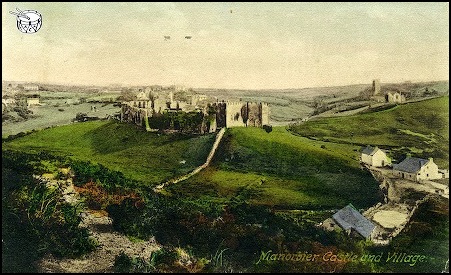
Above: A pre-World War II view of Manorbier Castle and village.
Looking back, I find it difficult to comprehend how much freedom we were allowed. There seemed to be very few restrictions placed upon us. We came and went as we pleased, and provided that we were present for meals, no one seemed to mind. A high proportion of our increasing knowledge came from our peer group: the facts of life were passed on by those a couple of years older who had moved on to Tenby Grammar School, who were given them in their first year at school. (At the time, I thought the whole thing highly improbable.) Grown-ups didn't figure largely in our lives, except, perhaps, at school. There were obvious shortages of money, choice and food were strictly seasonal, but we knew no different, so it did not affect us in any way. Sweets were still rationed, but again, we knew no other system. In retrospect, I think that I was very fortunate to have had such an interesting, carefree and enjoyable time between the ages of six and ten at Manorbier. I suspect that few children today could be so fortunate as we were.'
Peter Crump (b.1944).
PERSONAL STORY: AN EAST AFRICAN ADVENTURE
Penelope Ann Perry was three when, in 1949, she and her mother travelled to Kenya to join her father – himself once an army child – who had been assigned to the 5th Battalion, King's African Rifles. In the course of her tale, Penelope describes the long journey from England to Kenya, and the dilapidated corrugated-iron farmhouse near Nakuru, the 'married quarter' that became her family's home. She also conveys the excitement of living in East Africa, and the dreariness of an interim posting to Staffordshire before the family's subsequent return, this time to Jinja, Uganda. In conclusion, she reflects that their experiences as an army family in Africa from the late 1940s to the 1960s had a lasting effect on their lives.
'I grew up the child of a British Army soldier and recognise that my sister and I are fortunate in that Dad always made it home. He, too, had been an army child. I had lived in Lancashire, Cheshire and Hertfordshire by the time I was three. Prior to my birth in 1946, my father had spent six years in India and Kashmir; my bedtime stories were often Rudyard Kipling's intertwined with tales of the many cities that Dad had been to and the experiences that he had had in these places.
In 1949, my mother and I travelled by troopship from England to Kenya to join my father, who had been stationed, unaccompanied, in Egypt. He had left England when I was one month old, and had now arrived in East Africa, having been assigned to the 5th Battalion, King's African Rifles, at Nakuru. I recall being held up to the railings on HMT Empire Ken to see Mount Vesuvius light up the night sky as we travelled off the coast of Italy. I explored the bazaars of Port Suez with my mother, who was grateful to get off the ship, having spent the entire journey confined to our cabin trying to overcome seasickness. A young woman in the cabin next door, en route to join her husband in Rhodesia [now Zimbabwe], kindly took me to the dining room for meals. My mother must have been relieved to finally arrive in Mombasa, Kenya. I could not remember my father at that point, but he was very happy to see my mother and me. Dad took us to stay in the town and promised to bring us back to the beautiful beaches, a promise that he kept, as we were to make many more trips there.
Below: My mother and me on the beach at Mombasa (left). Dad (he's the one with the pipe) with Samburu tribesman at Archers Post, Kenya, in 1949, just prior to our arrival (right).
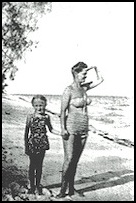
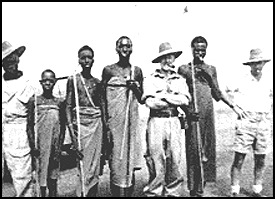
Our "married quarter" near Nakuru was a corrugated-iron farmhouse, set on 3 acres of uncultivated land at the end of a dirt road. It was known locally as Rubens Farm. It was so awful that Mother cried when she first saw it. The house was built up on stilts, supposedly to stop rats and snakes from entering the house. Whoever thought that this would deter them knew nothing of either species as the house had been taken over by both! The inside of the house was very spacious, with large rooms that had wooden-plank mahogany floors that had been very well polished and maintained at one time, but were uncared for and filthy when we first arrived.
At the side of the house was an enormous water tank. Situated under mature oak trees, it was made of corrugated iron and measured about 6 feet across and 12 to 15 feet high. It was our only water supply, providing rainwater, and had a sieve-like cover on the top to stop leaves and debris from ending up in the bathtub. Dad had to climb a tree periodically to get to the top of the tank to keep the sieve relatively clean. I liked it when he did this as he would help me up into the tree with him, and from the top we could see giraffes, zebras and other types of wildlife in the distance. We had no electricity, so I cannot fathom how water got from the tank to the house without some type of pump. Water then had to be heated on the stove and poured into the tub. At the age of five I thought that this was great fun, but I would not feel the same way today!

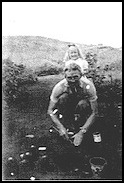
Left: My father and me making 'mud pies' – I would rather have made sandcastles on the beach, but army children and their parents are adept at improvising!
Lighting at night came from paraffin-filled lamps that we Brits call "Tilley lamps". Without electricity, Mother did all the laundry by hand, including bed linen and towels, and, after my sister was born, nappies (there was no such thing as "disposable" then). All linens had to be washed in the bathtub as the kitchen sink was too small. The kitchen had only a wood-burning stove, which was similar in design to what in England is known as an Aga, but it would have to be fed with logs from early in the morning in order to get it hot enough to cook an evening meal. I will forgive the reader for thinking that this was the American Wild West of the 1850s, but it was not – it was British East Africa in the 1950s!
The army furnished the house, and Mother made curtains from fabric that she had bought at an Indian store in Nakuru. She polished the floors and decorated them with her hand-hooked rugs. Her embroidery, and her mother's bone china, which she had brought with her, was displayed on the dresser. She planted a flower and herb garden around the house, which became her little corner of England. She made it into a lovely home and cried when she had to leave it.
My school holidays were spent exploring new places, which often included the beaches of Mombasa and the surrounding countryside. We often took the train to the coast, and, through the compartment windows, could view an abundance of wildlife: elephants, zebras, giraffes and wildebeests, all in their natural habitat.
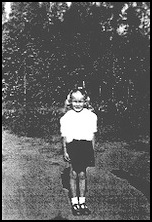
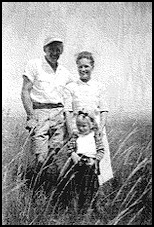
When my mother was pregnant with my sister, she would have to travel to Nairobi for her regular check-ups, and I would accompany her. We made one such trip in the company of several other pregnant military wives. We were seated in the back of a 3-ton army lorry for the hot, dusty and bone-shaking trip. There was often heavy rain, and if the roads were muddy, we would get stuck in the mud and the driver would have to elicit help from local tribesmen to push us out. One day, we were escorted by a single armed soldier who was about eighteen years old, whose first assigned mission was to accompany and help these pregnant women in and out of the back of the lorry, once they had got the tailboard down. He was made fun of for the entire trip, and I often wondered if his family heard the true story of his first mission in darkest Africa!
SENT TO STAFFORDSHIRE AND THEN BACK TO AFRICA!
My sister was about two when we were sent to cold and dreary Staffordshire. We all hated it: it was boring by comparison. Then, a year later, we were off again, back to Africa. We were all so excited when Dad told us. We had been given three weeks to pack, but mother could have done it in three days. This time, Dad was joining the 4th Battalion, King's African Rifles, at Jinja, Uganda, which was a new place to explore, but close enough for us to get back to Kenya when we wanted to. Things had progressed since 1949, and this time we arrived at Nairobi Airport by military charter and took the train through Kenya to Uganda.
In Jinja, my sister and I went to the local school, where we met children from all over, whose parents, if not in the British Army, were either missionaries or employed by the railways. We were driven to school by a soldier in whatever vehicle he could obtain from the MT [military transport] department that day. Sometimes it was a 3-ton lorry, and at other times it was an army ambulance or Land Rover. Each morning, I would walk with my sister down to where the school-bound vehicle would pick us up. It was a short walk of a few minutes from our home, and each day we would pass the same African soldier, or "askari". He was a heavy-set man, well over 6 feet tall, and he would always say "Hello" in Swahili as we passed. His name was Idi, and we saw him frequently. Years later, in 1971, when I was living in the United States, in Los Angeles, working, as it happened, for East African Airways, a message came over the Teletype one morning announcing that there had been a military coup in Uganda. The person who had taken charge of the government was Idi Amin, the very same Idi whom we had passed on our way to school each day! Strange, the turns that life takes, isn’t it? In 1959, we met Queen Elizabeth the Queen Mother on a state visit to Uganda. A photograph taken of the four of us meeting her is one that I treasure.
During the 1960s, we were sent back to England, to Chester [in Cheshire]. It took a while, but we finally settled into English life there – well, almost. Seeking more excitement in my life, I joined the Royal Navy (sorry, Dad!) Even after my father retired from the army, he could not rid himself of the travel bug. And, as with many "old soldiers", he could never get used to being a civilian. My mother, too, had become accustomed to being uprooted every so often, and to being sent to some distant land where life was not always easy, but was ever so interesting. For many years, my parents would visit my husband and me here in the United States, or we would visit them in England, and the conversation invariably turned to reminiscences of the army and of our life in Africa.
My sister now lives in Spain, and I live in Miami. The life that we experienced as army children instilled in us both a sense of independence and a love of new places. We were exposed to people from other cultures and exotic food, and it gave us a first-hand education that we could not possibly have had in a classroom in England. I most certainly think that we are the better for it.'
© Penelope Ann Perry (b.1946).
PERSONAL STORY: ‘MY EARLY YEARS IN KENYA AND ELSEWHERE . . . I WOULD LOVE TO KNOW MORE’
Roger Noble initially contacted TACA to contribute his memories of Miss Seed’s School in Aldershot, Hampshire (‘TACA CORRESPONDENCE: MORE MEMORIES OF MISS SEED’S SCHOOL, ALDERSHOT, HAMPSHIRE’). He has now expanded on his early years as an army child, which were spent adventurously in Kenya, and occasionally in Hong Kong, amongst other countries. And what a story he has to tell!
‘I was born in 1947, and in 1949 found myself on board a troopship bound for Mombasa with my mother. We were joining my father, who was then a captain in the Royal Army Service Corps (RASC) and, I presume, the quartermaster. Initially, we stayed in a hotel on the beach, which I suspect might have been the Nyali Beach Hotel. The first job was to buy me some shoes as I had let the side down by throwing all my shoes overboard on the voyage.
We then moved into the married quarters. It is all a bit vague, but I am fairly sure I remember my father getting some steps built with old railway sleepers in the back garden down to the beach. I would love to know where the married quarters were. Mombasa, in those days, seems to have been something of a malarial swamp. The inevitable happened when my father went down with malaria. This resulted in 1951 in a new posting to Nairobi.
For a four-year-old, the train journey into the Kenya Highlands was a great adventure. When we arrived, we initially stayed in a place called Kenton Hostel, which seems to have been a holding area until married quarters became available. We must have been reasonably close to Nairobi as my mother took over the bookstall in the New Stanley Hotel. I would love to know the name of the barracks.
While we were in Nairobi, I first met my maternal grandfather, Major Harold Dunster. Grandfather had become a copper-miner in Chingola, in what was then northern Rhodesia (now Zambia). He had joined the 12th Lancers on 19 January 1916 as a private, and arrived in France three days later. He saw most of the major battles from then on in, and, amongst others, was at Cambrai, which was later to lead him to tanks and also the Somme. The family was well represented on the Somme, with my paternal grandfather, Sergeant Wheeler William Noble, of the Army Service Corps (ASC), being gazetted on 13 September 1916 for a Military Medal. Family legend suggests that the award was for rescuing a number of horses from a burning building. I have never managed to verify this, but it sounds plausible, given his job. Sadly, my great-great-uncle, Private John Noble (of the Durham Light Infantry, or DLI), died of his wounds on 4 September 1916.
After the war, Harold Dunster eloped to the Curragh, in Ireland, where he had been posted, with my soon-to-be grandmother. I am not sure what cock-and-bull story she told him, but she was actually sixteen at the time. Grandfather was later posted to Cairo, Egypt. In 1931, he drove a Rolls-Royce armoured car across the Libyan Desert. (The story of the expedition is told in a book by the medical officer on the trip, Major Dun. I have a copy of the book: From Cairo to Siwa: Across the Libyan Desert with Armoured Cars.) I think that he had a brief period with the Royal Pioneer Corps in the 1930s before serving in the Royal Tank Regiment during World War II.
Anyway, my father, mother, baby sister and I flew up to Chingola. Grandfather could not believe his luck when he discovered that he was no longer the only kid in the family, especially when he discovered that I spoke fluent Swahili. He concluded that this called for an adventure (I was soon to discover that this was his answer to everything). My mother and sister were bundled on to a plane and my grandfather, grandmother, father and I set off for what appears to have been a 1,100-mile (as the crow flies) drive to Nairobi. We were travelling in an Austin A30, which was totally unsuitable for the journey, all of which was along rough tracks through the bush. My father had a close encounter with a cheetah, which ambled out of the grass as he was trying to push us out of some sand. Grandmother did not notice the warthog when she went behind a bush, and we finally had to make a mad dash for the dry river bed, which we had to cross. Unfortunately, the rainy season had started early. Grandfather made the mistake of continuing to drive at night, and failed to spot the lump in the road as we neared the river. The lump turned out to be a crocodile, who was not impressed with being run over, and gave the car a good thrashing before we got away. The rush was all in vain as the river was a raging torrent when we got there. We were forced into a long detour to the nearest bridge. Grandfather’s car looked a bit bedraggled by the time that we got to Nairobi. Adventures in the bush and trips to see his farming friends in the highlands were to become a regular part of my life.
One 5 November, I went to a Bonfire Night party, but was in a terrible state by the next day. Very soon, I was in the military hospital, paralysed from the neck down, with a severe case of polio. I believe I was one of the few children in the hospital, and was spoiled rotten by the nurses. They were all very impressed when a big box of chocolates arrived from Frank Sinatra and Ava Gardner. The two of them had been staying in the New Stanley Hotel while Ava filmed Mogambo with Grace Kelly and, I think, Clark Gable. Frank seems to have been hanging around while filming was going on, and often used to chat to my mother in the bookshop. Anyway, I eventually recovered without too much in the way of residual effects.
In the meantime, the Mau Mau crisis was building, and we were shipped to Farnborough, in Hampshire. Dear old grandfather, having survived two world wars and heaven knows what other adventures, failed to wake up one morning about this time. Grandmother, who was well ahead of her time, discovered toy boys, married a South African policeman seventeen years younger than herself, and disappeared to Bulawayo. On returning to England, I went to Miss Seed’s School for officers’ children in Aldershot before going to Barfield School in Runfold, near Farnham. Boarding school came a bit of a culture shock after a childhood spent with grandfather in the African bush.
My father was then posted to Hong Kong. I believe the army policy was to pay for parents to see their children every third year, but my mother ran a kindergarten in their flat, so she could see me once a year. It was a great adventure for a nine-year-old to travel to Hong Kong after not seeing my parents for a year. The trip involved stops in Frankfurt, Rome, Istanbul, Bahrain, Karachi, Delhi, Rangoon and Bangkok.
My parents returned to England at the end of the 1950s, and my father had further postings to Folkestone, Lisburn (in Northern Ireland) and Rheindahlen (in Germany) before hanging up his boots as a lieutenant-colonel. He had joined up as a boy soldier on his fourteenth birthday in 1927.
Having these distinguished military forebears, there was clearly only one career for me. Yes, I became a chartered accountant! After I married in 1969, my wife and I spent fourteen years in Hong Kong, so I did eventually manage to catch up on what I missed out on during my brief visits as a youngster.’
Roger Noble (b.1947).
PERSONAL STORY: THE CAMP AT HOHNE, GERMANY
The Friend family lived in Hohne, (West) Germany, from 1951 to 1961, and Terry Friend, whose father was in the Royal Horse Artillery, describes his memories of its camp below. (For his recollections of the family's married quarters in Hohne, see the 'ACCOMMODATION' page; for his memories of attending school in Hohne and Wilhelmshaven, see 'SCHOOLING'; for his childhood view of the repercussions of the Hungarian uprising in 1956, click here; for his reflections on Remembrance Day, click here; for his account of Christmases in Germany, click here; and for more about Terry himself, visit his website: http://www.another countrysong.com.)
'I've lived in many places, but very few of them have had the impact upon me, or impressed me as much, as Hohne did. The camp, which was established in the early 1930s, was huge, with wide areas of countryside between various areas of buildings. In fact, the camp itself was off the beaten track, being situated deep in the German countryside.
The wireless was the thing for us in 1951, that and the cinema. Yes, the camp boasted a cinema, with an excellent choice of films all week. There was always a "family" film scheduled for the weekend, and during our time there, the almost weekly family outing to the cinema became a much loved and longed-for treat. We always sat upstairs, which was reserved for married families; downstairs was for the soldiers. The stairway was made of stone slabs; these had been worn away. Every time I ascended those stairs, I thought about all the countless army boots (British and German) that had passed up and down to wear them out so much. There was a sort of Saturday Cinema Club, which Chris and I went to a couple of times, but we didn't like it all that much. There were no parents present, and it used to get quite unruly. Bored kids would throw things around and clamber through all of the seats, which were made of wood, and as you squeezed through, they would close behind you with a bang. The noise could be horrendous. I didn't envy the manager his job one bit. Often, he would stop the film, then we would all protest by stamping our feet and chanting "We want the film, we want the film". I bet Saturday was his worst day of the week.
There were two outdoor swimming pools, and we were to get to know these very well. In summertime, especially during the six-week school holiday, the pool area would almost become our second home. Mother would take us there every day when the weather was fine. She would sit on the grass and read her magazines, or knit, whilst we swam and splashed about for hours. At the beginning of the season (the pools were closed during the winter months), we would suffer agonies in the cold water.
The Roundhouse was, as the name suggests, a circular building – quite large, and quite unique, from an architectural point of view. During the war, it was the garrison officers' mess for the German forces stationed there. In our day, it was used for many things. In the middle was a large hall that was used like a community centre. Dances and sporting events were held there. I myself remember going to some of Pop's regimental boxing tournaments. Mother used to do fencing there at one stage, and I clearly recall being in tow on several occasions. SSAFA [Soldiers, Sailors, Airmen and Family Association] fêtes were held at the back every summer. There were horse and pony rides, swings and roundabouts and stalls of all kinds, much like a village fête at home. Once – probably the very first time that I ever sat on a horse – I promptly fell off the second the beast moved. It was a huge animal, and I was a very small boy. It was a long way down to the ground, and I almost knocked myself unconscious. That put paid to my afternoon's activities! On entering the main entrance, there was a lobby. A corridor led left to the NAAFI [Navy, Army and Air Force Institutes] shop, which was a local supermarket really. Turning right, down the other corridor, there was a small newsagent's and bookshop. Next door to that was the YMCA shop that sold all sorts of things: toys, gifts, sweets, watches, clocks – you name it, they sold it. At the far end of the corridor was the Other Ranks' (ORs') Club, which was strictly out of bounds to we children. The last point that I would like to make about the Roundhouse, which always struck me as odd, was that every building in the camp, including the married quarters, all had red or orange slates on the roof. For some reason, the slates on the roof of the Roundhouse were blue-grey in colour. The cinema was likewise adorned. I found it very strange that these two buildings alone had to be different from all the rest!
A grey van became part of the institution of life as we knew it in Germany. An enterprising shopkeeper from the nearby village of Bergen, a Mr Shomberg, had a grey van, and every Wednesday he would peddle his wares in the camp. Mother used his mobile shop every week. His grey van would pull up outside our house, and he would ring a hand bell to attract his customers. The side of the van would open up, and he would stand behind the counter and serve us. Mother would always buy us some sweets, and these I soon developed a passion for. They were, of course, German sweets, completely different in taste and texture from anything that we English were used to. I will always remember with fond affection the "chains" of pink, chewy "boys and girls" that I eagerly used to consume. His gingerbread men (and gingerbread ladies, too) had to be tasted to be believed. His liquorice also was a firm favourite. He sold all kinds of things, and I seem to remember us getting sausages, eggs and bacon from him. When we moved to England, the old grey van and its assortment of German sweets was one of the things that I sorely missed.'
Terry Friend (b.1947).
TACA CORRESPONDENCE: ‘WAS THE TIME THAT I SPENT AT A CAMP IN ANLABY, HULL, IN THE 1950S A FIGMENT OF MY IMAGINATION?’
Robert Mauldon, whose father served in the Loyal Regiment (North Lancashire), has contacted TACA to ask for ‘information about the barracks which housed families while our fathers were serving abroad. This was in Anlaby, near Hull’. He continues, ‘I have tried all websites to find about this, even contacting the museum at Preston Barracks, and no one can give me this information. Is it a figment of my imagination?’ Robert now explains more:
‘I was born in Lusaka, Northern Rhodesia, I spent my schooling mostly in army schools, ending with Slim School, in the Cameron Highlands, Malaya [now Malaysia].
What I would like to find out about is a period of my life that seems to have been forgotten by others. I was evacuated from Egypt, and was moved to B & Bs in Blackpool. My father was posted to Trieste, and my family was then transferred to a barracks in Anlaby, near Hull. The year, I think, was 1952 or 1953.
This period of my life is full of happy memories. We lived in wooden huts that had a sitting room, three bedrooms and a bathroom. We ate in a canteen, and I remember a large cheese always being set out on a table so that anybody who was hungry could take a slice.
We had our own school and cinema. Next to the barracks was a large mansion that was overgrown and empty; it had orchards where we children would spend our days when it was summertime. We boys organised ourselves into gangs and used to fight each other with peashooters etc. An epidemic occurred when some boys were found to have sores around their mouths. It took a while to find out that this was because we were using a type of cowslip stem as peashooters. Oh, happy times! We also had a few children that had polio, the one blight on our carefree existence. The other thing that I remember is that there were no men there, apart from the workers on the camp.
I hope that someone can help. I have tried all avenues to find out about this part of my history, but with no success.’
If you think that you can indeed assist Robert, please contact TACA, and we’ll pass on your message.
TACA CORRESPONDENCE: CAN YOU RECALL TRIESTE OR KLAGENFURT, AUSTRIA, DURING THE 1950S?
Michael Barnacoat’s father was a teacher with the British forces in the Free Territory of Trieste (and later also in West Germany), and was joined in Trieste by his nine-year-old son in 1950. Michael attended school in Klagenfurt, Austria, from 1952 to 1953, returning to Trieste in 1953 in order to be evacuated. He was then a pupil at Windsor School, in Hamm, Germany, from 1953 to 1960. Looking back, Michael has a number of questions about Trieste and Klagenfurt that he hopes someone can help him to answer.
‘Does anyone remember the primary school in Trieste and have photos of it, or of any of the sights around Trieste at that time i.e., 1950 to 1953?
There was a villa on the hill overlooking Trieste and the Adriatic. We lived in the basement flat before moving to the sailing club, where I think my father was the secretary. We used to have rigging and sailing races in the harbour. I think the villa was one of the stops on the Opicina tram route.
I also have memories of taking part in a radio quiz show in Trieste and of taking the bus from Trieste to the Schloss [castle] near Klagenfurt, where I boarded.
I would love to know more about the old hunting Schloss up in the hills above Klagenfurt where we children from Trieste, Graz and Vienna stayed while we attended the day school in Klagenfurt. We were taken from the Schloss to the school each day by army truck. There was a matron and an education sergeant who used to look after us, taking us skiing in winter and hiking in summer during the weekends. There was a hotel on the lake for British families – the Golf Hotel, I think. Does anyone have any information about it? Does anyone have photos of the boarding Schloss and/or the school in the town of Klagenfurt?
I have seen the Pathé news footage of trains leaving Trieste, but wonder if anyone has any photos of the evacuation or of the transit camp that we were sent to in Holland before being sent on to Germany.
If anyone can recall these places, it would be wonderful.’
If you have any answers to Michael’s questions, please contact TACA and we’ll pass them on.
PERSONAL STORY: LIVING AND LEARNING IN AUSTRIA, 1953 TO 1955
John Leggett's father was in the Royal Army Service Corps (RASC), and John consequently lived in England (Catterick), Austria (Vienna, Graz and Klagenfurt) and West Germany (West Berlin, Bad Oeynhausen, Düsseldorf, Hildesheim, Wuppertal, Bad Harzburg, Goslar, Braunschweig [Brunswick], Herford, Osnabrück and Bielefeld) as a child. He went to school in many of these places, too, also attending Prince Rupert School (PRS) Wilhelmshaven, in West Germany, for over three years. John shares his memories of living in Austria below, adding that he has never met anyone who was at his BFES schools in Vienna, Graz (where he attended two schools) and Klagenfurt at the same time as him. Others are also keen to learn more about these schools (see, for example, 'TACA CORRESPONDENCE: INFORMATION SOUGHT ON ARMY SCHOOLS IN AUSTRIA'), so if you can help fill in the gaps, please do contact TACA.
'I was eight in 1952, when we travelled to Austria from Catterick Camp: Mum and I, my twin sisters and my baby sister. It seemed to take forever, starting with a train to King's Cross, in London, a troopship from Harwich to the Hook of Holland and then the dreaded military train. I can't remember exactly, but I think it took a day on the train to reach Vienna, arriving late on Christmas Eve, with all of us kids in panic mode: "How is Santa going to find us?" Dad met us, and Santa provided the goods the next day.
In Vienna, we lived in a small married-quarters' patch alongside the barracks at Schönbrunn. The school was very small, and was just inside a side gate to the barracks. It was only open at school start and finish times, so if we wanted to get into the barracks at any other time, we had a long walk round; some of us always managed to find a hole in the fence for a short cut, though. This school in Vienna was my seventh school in four years, so my early school memories are a bit blurred, and the only part of my schooling that I recall here is extra-curricular. Once, for example, during term time, a few of us were taken to a recording studio, which we were told was Hungarian, to make a voice-over, in German, for a film. Apparently, we British kids were used because our German sounded "posher" than that of the locals. Other memories of Vienna include:
- being sent to the baker's for bread and wandering further down the road to watch the Russian soldiers marching up and down;
- regular visits to the Schönbrunn Palace grounds and the zoo, unaccompanied by adults (I'm fairly certain that we used the hole-in-the-fence method of entry to the zoo, too);
- visiting the large Prater funfair, with its huge Ferris wheel;
- the regular parade involving British, Russian, French and US troops;
- the regular supply of American DC Comics that Dad acquired from his American mates at their NCOs' club; and
- regular deliveries of huge blocks of ice for use in meat safes as we didn't have fridges.
We stayed in Vienna for about a year before moving to Graz. Initially, we lived in a big apartment in the town. My school was not far from the famous Graz clock tower, and I'm sure that I walked to school. Later, we moved to married quarters near the barracks, and I changed schools to the one there. The school must have been for quite young children as, after a while, I didn't have any lessons and spent my time in the headmaster's office, messing about with the typewriter and doing odd chores. I was nine, and this was my ninth school.
As in Vienna, we were in Graz for about a year before moving to Klagenfurt. On arrival in Klagenfurt, we lived in a transit hotel, which was an Austrian guesthouse on the Wörthersee; I think that all of the occupants were British service families. We eventually moved to a married quarter beside the British military hospital at Lendorf, just outside Klagenfurt.

The school was in the centre of Klagenfurt: a large building, with a big concrete playground. The dining room was in a small building outside the main school site. I can remember that the headmaster was a Mr Watson. He drove a huge American car, but was really short and had cushions on the seat and blocks on the pedals so that he could reach them. I came across him some years later when I was at PRS Wilhelmshaven, and he was headmaster of the school at Jever. (I think he still had the big car then.) We were transported to school in the back of 3-ton trucks. These had folding seats down each side and a double row in the middle; there was a small set of steps permanently attached to the back for us to climb in on. We had an Austrian lady as an "escort" and used to drive her mad: as she counted us on to the bus, we'd climb out via the canvas sides of the truck and then join the queue to be recounted. Other memories of Klagenfurt are:
- the large fence around the barracks and the married quarters, as in Vienna, so that getting to the small local shops a few yards away involved either a long walk via the main gate or a climb under the fence – usually the latter;
- finding a disused wartime bunker built into a quarry. It was supposed to be locked, but we kids found a way in; and
- building a raft on the Wörthersee, which, surprisingly enough, actually floated.
We left Austria in 1955, when the Allied occupation ended, and whilst I have since met people who served there, mainly as conscripts, I've never come across anyone else like me who went to school there. I'd be delighted to hear of any others who were in Austria at the same time.'
John Leggett (b.1944).
TACA CORRESPONDENCE: SEEKING IMAGES AND INFORMATION ABOUT THE SUEZ CANAL ZONE
TACA has received the following message from Peter Howell, who was born an army brat in Egypt in 1950:
'I was born in BMH Moascar, [Suez] Canal Zone. Does anyone have any photographs of Moascar Hospital?
Also, I was baptised in the Parish of St Saviour's, Suez. Does anyone have any photographs of the church? Was it a garrison or civilian church, and where was it in Suez?'
If you can help Peter, do get in touch: he can be contacted through TACA.
THE FAMILY GUIDE TO THE FAR EAST, 1950S
Although it is undated, the foreword to a booklet, below, produced by the War Office entitled The Family Guide to the Far East is signed by ‘John Harding, F.M. Chief of the Imperial General Staff'. Harding held this position between 1952 and 1955, so the booklet must date from this period.

In his foreword, Harding states that ‘This pamphlet has been produced to help Army wives and families going to the Far East. It contains information about the preparations before leaving, the journey itself and conditions on arrival’. He continues: ‘A visit to the Far East is a great adventure affording unique opportunities for seeing other parts of the world and meeting other peoples. Apart from finding plenty of new and varied interests there, British wives and families can also be a great force for good by adopting a natural, kind, friendly and understanding attitude to all the people of different races, in whose midst they live’.
Topics covered in the booklet include the medical certificates and vaccinations required; money matters; passports, visas and military permits; domestic animals and private motor cars; accommodation in the UK; customs; and packing cases. Some of the advice to those travelling by troopship includes the following:
‘31. (c) In tropical climates clothing should be light, loose and washable. The ideal to aim at is the smallest amount of clothing necessary to protect your child from the sun. Many changes of clothing, easily washable are required, such as cotton or drill shirts and shorts for boys and cotton sunsuits for girls . . .
33. Eyestrain and headache may result from prolonged exposure to glare from road surfaces, a sandy beach or from the sea. Certain children seem to be rather more sensitive to light than others, and for those cases it will be necessary to wear dark glasses and a wide-brimmed linen hat when out of doors. A pair of reins is useful for guiding “toddlers” round the decks.
35. A nursery is fitted in most troopships. If and when available a trained nurse or stewardess will be in attendance.
Educational classes are usually arranged on board for children up to the age of 15 years.’
The guide continues with sections on travelling by air; arrival overseas; advice on buying food; taking over quarters; bathing in the sea; and malaria prevention. There is also a section on the education of children overseas:
‘11. If you intend to send all or any of your children to a Service Children’s School overseas, you are asked to tell the Headmaster of the school which your children are now attending in the United Kingdom.
12. Army Children’s Schools are established throughout FARELF to provide education for Officers’ and Soldiers’ children in family stations. In type and scope the education provided conforms to that of the Education act, 1944.
13. The Schools vary in type and size from Primary and All Age Schools of about 30 children to Secondary and Primary Schools of over 300 children. School hours are usually from 8.15 a.m. to 12.30 p.m. each day. In HONG KONG during the winter months, the school hours approximate to those in the United Kingdom. The Schools are staffed by Queen’s Army Schoolmistresses, Seconded Teachers from the United Kingdom and Locally Entered teachers. The Locally Entered Teachers are normally Service wives and daughters. It will probably be a long while before the Schools can be fully staffed by United Kingdom-Based Teachers.
There is also a boarding school for boys and girls in the Cameron Highlands. N.B.–Warm clothing must be provided for this school as it is much colder there.’
There follows a section headed ‘Interests for women in FARELF’, which begins:
‘1. You will have heard that in FARELF you are provided with a servant when you are living in a quarter. You may, therefore, feel that you will have to find something to do while you are in the Far East to occupy and interest yourself.
2. If, however, you have any children with you, you will have a full-time job looking after them. Your servant whether Malay, Chinese or Indian will certainly be very fond of children and very willing to help you with them, but it will be most unlikely that they have been trained to look after European children. If your children are going to school which they do only in the mornings in Malaya and Singapore (in Hong Kong in the cold weather the school hours are the same as in the U.K.) it may be a good thing for you to find outside morning occupation.’
PERSONAL STORY: HAPPY DAYS IN HONG KONG, 1953
A year in Hong Kong, when he was four years old, preceded Richard Hall's stint as an army child in Münster, Germany (see 'PERSONAL STORY: MEMORIES OF MÜNSTER, 1958–60' below). Here, he recalls the highlights of that year. (And click on the highlighted link to read Richard’s brother Roger’s army-child memories: ‘PERSONAL STORY: MEMORIES OF AN ARMY CHILDHOOD’.)
'We travelled out from Southampton on the troopship Empire Orwell. My mother was constantly suffering with seasickness; I seemed to be able to run about the entire ship, which appeared to be enormous. Families were meant to stay in the stern part of the ship, the forward area being reserved for single soldiers, but I got up to the bow one day and was dragged back by one of these soldiers before I fell overboard! The voyage took about a month, and as the sun had not yet set on the British Empire in 1953, we stopped at Port Said, Suez, Aden, Colombo and Singapore before arriving in Hong Kong.
We had a Chinese amah who looked after me once we got to Kowloon, and I was spoilt by this girl as I had white-blond hair (the local Chinese liked to touch my hair – it was meant to be lucky). I often went with her to visit her family. Another little adventure was when I got lost at the library at Whitfield Barracks in Nathan Road. I was playing on the swings while my mother was choosing some books. I went in to find her and, being very small, could not see her. Instead of waiting to see if she would turn up, I went out on to the street and got on the No 7 bus to our home in Boundary Street. Of course, when I got there, Ah Gee (the amah) asked me where my mother was, and I said that she had left me there at the library! Half an hour later, my mother turned up in a police car telling me that half of the Hong Kong police force was looking for me!
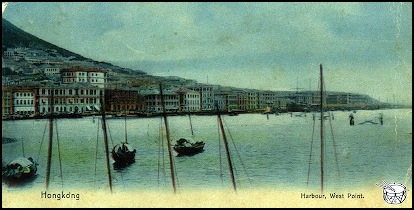
Above: The harbour at West Point, Hong Kong, in the early twentieth century.
The rest of my memory of Hong Kong is of countless days spent swimming at the various beaches around the area – it appeared to have been just one big holiday. Sadly, we came home after a year because my mother had not enjoyed the first few weeks in Hong Kong and we had to make a decision whether we wanted the posting to last for one or three years. I celebrated my fifth birthday on the Indian Ocean on our way home.'
Richard Hall (b.1948).
PERSONAL STORY: ‘MY EXPERIENCES WERE RATHER UNIQUE FOR A SEVEN-YEAR-OLD’, MOASCAR, EGYPT, 1953–54
The daughter of a Navy, Army and Air Force Institutes (NAAFI) official, Barbara Steels effectively experienced the life of an army child during the 1950s and 1960s, growing up as she did alongside service children in Egypt (or the Suez Canal Zone), (West) Germany and Malta, and attending British Families Education Service (BFES) schools. In this, the first part of her childhood memories, Barbara recalls living in Moascar, Egypt, between 1953 and 1954. (See below or click on the titles for the next parts of Barbara’s story: ‘PERSONAL STORY: ‘WE VISITED THE SUEZ CANAL FREQUENTLY; I COLLECTED THE NAMES OF SHIPS IN A LITTLE NOTEBOOK’, FAYID, EGYPT, 1954–55’; ‘PERSONAL STORY: LIFE IN LÜNEBURG, (WEST) GERMANY, 1955–58’; ‘PERSONAL STORY: PRINCE RUPERT SCHOOL, WILHELMSHAVEN, (WEST) GERMANY; THE AUTUMN TERM OF 1957’; ‘PERSONAL STORY: PRINCE RUPERT SCHOOL, WILHELMSHAVEN, (WEST) GERMANY, 1958 THROUGH TO EARLY 1961, AND TWA TODAY’; and ‘PERSONAL STORY: MALTA, 1961-63; FILLING THE EDUCATIONAL GAPS; THE ROYAL NAVAL SCHOOL TAL-HANDAQ’.)
‘It was in the spring of 1953 that my mother, sister and I embarked on the journey to Egypt. My father, a NAAFI official, had been there for a year before us, and the allocation of a house meant that we could join him. We had not been abroad before, and, at the age of seven, I was aware of preparations for the venture. We all had to have travel injections, which I recall were much more painful than they are now. We had an official NAAFI clothing list, and I remember being fascinated that we needed to get Aertex T-shirts – I had never heard of these before, but was told that the material enabled ventilation during the hot weather.
After a three-day journey, calling at Nice, Rome, Athens and Cyprus, we arrived in Egypt, and were met by my father at an airport in the desert somewhere. My father, Ronald Miller, drove the car, but an armed soldier accompanied us on the journey.

Our new home was a brand-new galvanised corrugated-steel bungalow, with a mesh screen enclosing the large ground-floor verandah. The bungalow was well appointed inside, and I recall us having a large paraffin-oil-fired fridge and a cooker that seemed to smell of fumes and sent out black smoke occasionally, to the consternation of my mother.
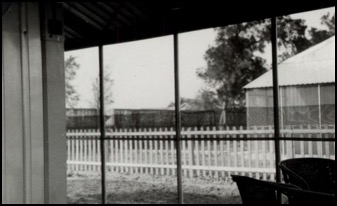
My sister and I soon started at the Moascar Garrison primary school. I only have a few memories of this school. We were taken to school and returned home on an army truck, with a staircase added to the back for ease of boarding. The school day started early in the morning and finished before lunch. We were told that this was because of the heat, and it was certainly an opportunity to spend more time with the family and playing with friends. I remember that my class group was smaller than a recent school class in the UK. One day, I arrived at school and there were only three other children in my class – the reason was that all of the other pupils had conjunctivitis; the whole school closed the following day until the outbreak was over.
The school at Moascar was my third school, and even at the young age of seven years, I can recall how confused I was that the multiplication tables were taught the other way around to how I had been taught in the UK, where it was 2 x 3= 6, 2 x 4 = 8, while in Moascar, it was 3 x 2 = 6 and 4 x 2 = 8. I soon learned and understood this different method, but it was the start of being confronted at successive schools by different methods of calculation in maths, and I became more and more confused by the subject.
While we were living in Moascar, my mother became Tawny Owl and then Brown Owl of the Brownie pack attached to St George’s Garrison Church. We met at a hall at the back of the church, and I recall the large red-and-white wooden toadstool that we danced around. We attended several church services and paraded down the main street of the garrison.

Below: A parade of Brownies.

I also remember attending some military parades where the soldiers lined up for inspection and then, every so often and quite randomly, individuals fainted – they just fell over, and it looked really strange. I also recall a regimental goat called Pegasus being dressed up and paraded at these ceremonies.
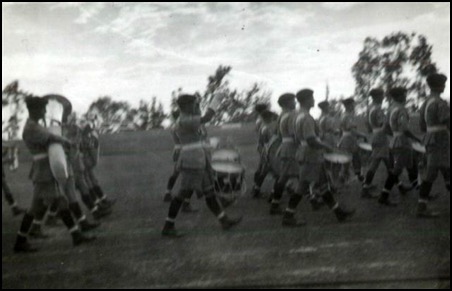
Above and below: The photos above and below show the celebration of the Queen’s coronation in 1953.

Social life, as I recall, consisted of playing with neighbouring school friends, birthday parties and going to the beach. These were always enjoyable experiences, and my memories of them are very clear. The photo below was taken at the birthday party of a neighbour and friend, Susan Moss.

Above: Susan Moss’s birthday party at the bungalow next door to us.
We spent many relaxing hours at the United Services Club, and we swam in Lake Timsah. I remember a long wooden jetty, and I have a memory of seeing small seahorses in the water. We always seemed to be in the company of other NAAFI families and their children, and life for my mother, sister and I was like one long holiday.

One of my least enjoyable experiences from this time occurred at the large garrison swimming pool, where, on one occasion, I was playing with my friends near the shallow end when a soldier picked me up and threw me into the water. This was my first experience of going under water and getting it up my nose and in my ears and eyes. I was actually put off swimming by this thoughtless act, and it was not until several years later that I learned to swim. To this day, I’m not too keen on the water due to this experience.
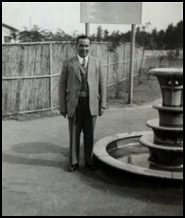
Below: A memento from my time in Moascar.

Life in Moascar as I recall it seemed quite normal at the time. It is only now, when I look back, that I realise that my experiences were rather unique for a seven-year-old.’
Barbara Steels (née Miller, b.1946).
TACA CORRESPONDENCE: INFORMATION REQUESTED REGARDING THE FREE TERRITORY OF TRIESTE, 1954
In 1954, the six-year-old Sylvia French, whose father was in the Oxfordshire and Buckinghamshire Light Infantry (the ‘Ox and Bucks’), was living with her family in what was then the Free Territory of Trieste. As she explains, Sylvia is now trying to put her memories of living in Trieste, and of being evacuated from it when the Free Territory of Trieste was broken up, into context.
‘I can remember going to school in Trieste, where my dad was in the army, by small boat in 1954. I also remember being evacuated by boat to the Hook of Holland and then England, and having pictures taken for the papers. I would love to have some more information on this. Can you give me any help or know where I can get some information, please?’
If you have any information for Sylvia, she can be contacted through TACA.
TACA CORRESPONDENCE: HELP SOUGHT REGARDING SEK KONG ARMY QUARTERS AND JUNIOR SCHOOL, HONG KONG
TACA has received the following message from William Ritson, who was born in 1945 and whose father was in the 1st King’s Regiment (Liverpool):
'I was brought up with the army until 1960. We lived all over the world and recently I have been trying to show my grandkids where we lived, with the help of Google Maps. I have found most places (Berlin, Kowloon, Osnabrück, Brentwood, Bury St Edmunds and Maghull), but I am drawing a blank with Sek Kong army quarters [in Hong Kong]. We moved there from Kowloon in 1953, after sailing out on the Empire Halladale – a great trip, with Christmas at sea. I have found RAF Sek Kong on the map, where we went swimming and to the cinema, sat on hard benches and watched mostly black-and-white films. My problem is tracing the army quarters, which were only ten minutes' walk from the RAF base and on the same road. I really can't find any landmarks at all. I would be grateful if anyone could help me with my search, with road names, map references, photographs or anything to do with Sek Kong army quarters. Thanks in anticipation.'
If you think that you can help William with his search for information about Sek Kong (now Shek Kong) during the 1950s, he can be e-mailed at the following address: writson@btinternet.com; alternatively, he can be contacted through TACA.
PERSONAL STORY: ‘WE VISITED THE SUEZ CANAL FREQUENTLY; I COLLECTED THE NAMES OF SHIPS IN A LITTLE NOTEBOOK’, FAYID, EGYPT, 1954–55
In the first part of her story (see above, ‘PERSONAL STORY: ‘MY EXPERIENCES WERE RATHER UNIQUE FOR A SEVEN-YEAR-OLD’, MOASCAR, EGYPT, 1953–54’), Barbara Steels, the daughter of a NAAFI official, described living in Moascar from 1953 to 1954, the year in which she and her family also moved to Fayid, further to the south. Although Moascar and Fayid are in Egypt, both were part of the (Suez) Canal Zone at the time that Barbara, along with other army children and forces families, lived there. Here, she relates what Fayid was like then. (See below for the next chapter of Barbara’s life story, ‘PERSONAL STORY: LIFE IN LÜNEBURG, (WEST) GERMANY, 1955–58’, and click on the titles for ‘PERSONAL STORY: PRINCE RUPERT SCHOOL, WILHELMSHAVEN, (WEST) GERMANY; THE AUTUMN TERM OF 1957’; ‘PERSONAL STORY: PRINCE RUPERT SCHOOL, WILHELMSHAVEN, (WEST) GERMANY, 1958 THROUGH TO EARLY 1961, AND TWA TODAY’; and ‘PERSONAL STORY: MALTA, 1961-63; FILLING THE EDUCATIONAL GAPS; THE ROYAL NAVAL SCHOOL TAL-HANDAQ’.)
‘About a year after we arrived in Egypt, we moved to Fayid from Moascar. Our home there had a high perimeter barbed-wire fence just behind it. Sudanese soldiers guarded the fence for twenty-four hours a day. This seemed strange, and I did find it rather frightening, but soon got used to it. Our house was a long bungalow with a verandah and a very colourful garden full of trees and plants. In the garden, there was a hut in which two Egyptian men lived – I think they did the garden and other chores outside, but don’t recall them working in the house. Both were called Abdul, and one rode a bicycle and wore a Panama hat, which, according to my mother, my father had acquired from a general with whom he had dealings at work.
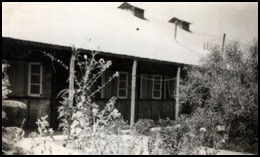

My sister and I started at the Fayid Garrison primary school, which I recall being much bigger than the Moascar primary school. My mother and I were introduced to my class teacher, a Miss Cunningham, who had a calliper on one of her legs. As soon as my mother started to talk to her, she realised that Miss Cunningham had been her sister’s primary school teacher in Hythe, Kent, during the 1920s, and she still remembered her, even though it was now 1954! This amazing coincidence was my first recollection of what have been numerous coincidences that occur every so often in this “small world”!
At the start of the day on one morning each week, a large group of padres from the various denominations descended on the school. As I recall, each class was assigned its own padre, and we had a lesson of religious instruction. Some of the classrooms were of a permanent structure, but others were large tents. We had music classes in one of these tents, and the memory of entering a large, beige circular tent with a wooden pole in the middle remains with me today. I recall learning the song “There’s a hole in my bucket, dear Liza . . .” as we sat on wooden benches, and eventually singing this as a round. Another memory from the school is that we had to fold our arms on the desk and put our heads on them to have a nap. I have a feeling that this was for the benefit of Miss Cunningham, as well as the pupils – it was very hot! The school toilets were awful: non-flushing, with wooden seats and a hole in the ground. Spelling tests were a regular morning activity – twenty words each time, and how grateful I am now for this, as I am sure that Miss Cunningham’s methods from the 1920s stood me in good stead for having a reasonable standard of spelling. School was again mornings only, and it must have been within walking distance from my home as I remember that there was a sandstorm blowing as we walked home on one occasion, and that this was an unpleasant experience.
A year later, we left Egypt and, on the way back to the UK, we stayed in Cyprus for a week’s holiday. I wanted to write to Miss Cunningham and the class, and, even now, I can remember making many starts on the letter – “Dear Miss Cunningham and all” – and ripping up consecutive attempts before achieving the final version. The phrase “it’s a Dear Miss Cunningham and all situation” has since been a long-standing joke in my family whenever any of us have had lots of goes at getting things right!
OUR SOCIAL LIFE, LEISURE ACTIVITIES AND HOLIDAYS
My recollections of the Fayid Garrison primary school are pleasant, but there were a lot of other things going on during the year of 1954. Life at our lovely bungalow, with its colourful garden, was a time of contentment and activity. My sister and I used to play with some children two bungalows along. They came from somewhere in the north of England, and their way of life seemed to be rather different from ours. I think that one of the reasons why I had formed this opinion was that they had a strange accent, and I recall that they always had a bottle of tomato ketchup on the table with every meal.
Within walking distance from our house, and somewhere near the school, was a social club, and we visited this place quite a lot. It was here that I was introduced to fizzy drinks with a cap on, and the bar tender always opened the bottle. It was essential, I recall, that I should look under the cork lining of the cap as there was a competition going on and you could win some money if you had a winning top. I remember attending a fancy-dress party at the social club; my sister went as a ladybird, and I was bluebells of Scotland.

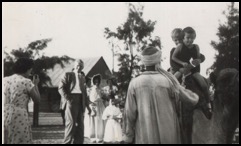
Above, left: Inside the social club. Above, right: My sister Rosemary getting on a camel at the fancy-dress party that we attended at the social club.
Fairly near to the social club were some buildings where army families lived. As I recall, these families just had been given living quarters and went to a canteen at mealtimes. This seemed rather strange to me as my family lived in very nice circumstances and were very comfortable, with our own facilities.
I’m sure that there must have been a swimming pool at Fayid, but I don’t have any recollections of one. However, I do remember trips to the Bitter lakes, where we spent many hours on the sandy beaches and in the water. (By this time, I think that things were a bit safer in Egypt, and my father didn’t need an armed guard in the car, but I remember that there was a small gun locked in the glove compartment.) To reach the beach, we had to drive through at least one village – the smell as we drove through was not pleasant, and I learned to hold my breath so that I couldn’t breathe in the odours. We had some friends who lived in a house near the beach – the man was an army officer, and I imagine that this was some sort of local hiring. The house was square and white, with stairs going up the outside to the roof. It was just the sort of house that was depicted in some of my books of the time when Jesus was alive. I have a memory of seeing cotton growing in the nearby fields, and had already been told that our bed sheets were made from Egyptian cotton.
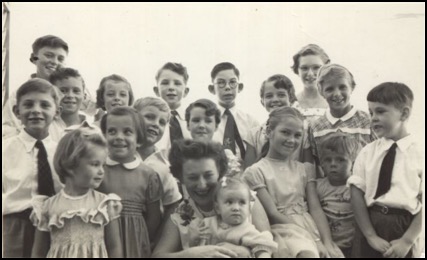
Above: This photo was taken at the first birthday of the child at the centre, at the front of the photograph, and was held at the house mentioned above.
We visited the Suez Canal frequently; I collected the names of ships in a little notebook. There was always great excitement when a troopship passed through. There was a very large war memorial sited near the Suez Canal, and my sister and I used to love running up and down its steps and climbing over the lower levels.


Below: This photo shows the base of the memorial’s two figures, and my mother, my sister and me. As I recall, there were steps leading up from the ground to this point.
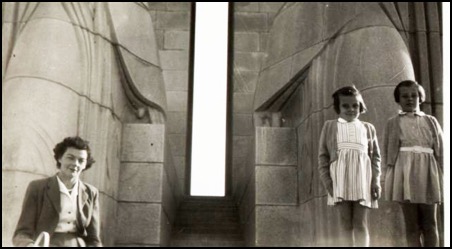
During 1954, our family visited Cairo and Alexandria for holidays. I recall travelling by taxi to Cairo and spending a couple of nights in a large, marble-floored hotel. Our time was packed with activities, and we visited the pyramids and the Sphinx at Giza. We also went to the Cairo Zoo, the Old Coptic Museum and a very large mosque that we were told had ‘a thousand lights’, which came on as our guide clapped his hands.

We travelled to Alexandria by train, and this was an experience in itself, which I don’t think my mother enjoyed very much. The Egyptian families in our compartment were very friendly, and I can recall that one had some hard-boiled eggs that had been painted purple. We were offered one, but my mother politely turned it down. (She has told me since that the journey on the train was a most unpleasant experience for her, particularly the toilet facilities, but I was not aware of this.) My impression of Alexandria was that it was a much quieter and more modern city than Cairo, which was very noisy, with strange smells. The only activity that I can remember undertaking in Alexandria was going on a harbour trip in an Egyptian sailing boat with a large, off-white sail. I remember a moment of anxiety for us when this boat managed to sail between a tug pulling a somewhat larger boat – this was a frightening experience for all of the family. I do not remember a train journey back home to Fayid, but I have a vague recollection of returning by car.
My memories are beginning to run out now, but here, briefly, are just a few more: the croaking of frogs at night; watching shooting stars in the big, open sky above the desert; the noise of the four-wheel-drive vehicles on the nearby Treaty Road; and being put off eating watermelons for life as they were grown in the Sweet Water Canal, which, I was assured by my mother, was not sweet at all, but very polluted!
It’s not far off sixty years since I lived in Egypt for two years as a young child. I have just had a look at the area using Google Earth. There is no mention of Moascar, but Lake Timsah, the Suez Canal and the Bitter lakes are just as I remember them. I read somewhere that St George’s Garrison Church is still there, but it looks as though the Moascar area has been absorbed into Ismailia, and I couldn’t locate the building. I couldn’t see the war memorial near the Suez Canal either, but I think that the beach that we used to swim from at the Great Bitter Lake is now the site of a luxury hotel. There is an airport at Fayid, and I think that this must have been the airport where we arrived and departed from. I remember approximately where we lived, and it looks as though the site is still there and is possibly an Egyptian military base. Some sort of perimeter wall surrounds it, and there are just a few buildings spread over the site. Could this be the same Fayid Garrison that we used to live in?
On reading back through the Moascar and Fayid chapters of my life story that I’ve written for TACA, I can’t help feeling what a privilege it was that my family had this wonderful experience. Memories are clearly etched in my mind, and I hope that by recording these, a little bit more history is now there for others to read in the future.’
Barbara Steels (née Miller, b.1946).
TACA CORRESPONDENCE: ‘I WOULD LIKE TO VISIT THE PRIMARY SCHOOL AND THE HOUSE WHERE WE LIVED IN BRUNSWICK, (WEST) GERMANY’
Bruce Ford, whose father was in the APTC (Army Physical Training Corps), has contacted TACA with the following query focusing on the German town of Brunswick (Braunschweig):
‘I attended Brunswick primary school from 1954 to 1956, when I was 8 to 10 years old, and would like to find out if it is still there. I would be grateful for an address or any information.’
If you can help Bruce, please contact TACA, and we’ll pass on your message.
PICTURES: WEST RIDING BARRACKS, DORTMUND, (WEST) GERMANY, 1954–56
TACA has received the following letter and photographs from Alan Robson, or rather, from 22947259 Gunner Alan Robson, BHQ Battery, 45th Field Regiment, Royal Artillery, BAOR 14, for his letter concerns his posting to West Riding Barracks in Dortmund, (West) Germany, from 1954 to 1956. (If you're interested in reading more about Alan's time at West Riding Barracks, click on: http://baor-locations.co.uk/westridingbarracksrobson. aspx.) Should you recognise any of the girls in Gunner Robson's photographs, Alan (and TACA) would be delighted to hear more.
'Having read, with great interest, many of the tales as told within the TACA archives, I, for some reason, could not shake the feeling, I was becoming ever more drawn into its pages. It truly was a strange feeling, finding oneself so deeply immersed within these stories, really strange. So much so, I began drifting back to a time when I had been a soldier, and had shared similar experiences of those times. I was a national service soldier, and conscripts at that time had very little in the way of wages. I clearly recall stepping up to the mark with an officer on parade, thrusting, as it were, the left hand forward, palm outstretched, while bringing the right hand smartly up and saluting that officer before stepping firmly back, holding tightly on to the 15 shillings sterling he had placed within my grasp. It would get a little better as time went by, but not a lot. Having finished your basic training, which was usually about eight weeks, you would then be dispersed to wherever, with my own posting taking me to Colchester, Essex. It had been rumoured that our intake was bound for the Far East, but with hostilities now at an end, mercifully we were spared this ordeal. On going overseas, however, we then became the advance party in preparation for the redeployment of the 45th Field Regiment, Royal Artillery, to Dortmund, Germany, and the West Riding Barracks.
My reading of the stories within TACA brought many memories flooding back, so I thought that I would send some pictures from that time. The two young girls in one of them may well have been the children of military personnel, whose families would have lived within the confines of the married quarters. This section was situated at the bottom of the road, as seen in the picture of the little girl playing on a big girl's bike. Also at this point was the "Stonk Club", or YMCA. This building was a firm favourite of the soldier, and likewise of the married personnel, for it was their corner shop. One could go into this building, have a coffee, or perhaps a meal, do a spot of shopping or buy your gifts, your postcards and suchlike. I do believe that you could also make a phone call home from within this place – if you had the monies, that is.

Above: Two young ladies at the entrance to West Riding Barracks. They may well have been the children of army personnel, for it was not unusual to see children waiting around outside the gates for one or other of their parents.

Below: The YMCA, or 'Stonk Club', at West Riding Barracks.

My pictures were taken in random fashion, and with no purpose other than to record a time or a place, whereon one day he or she might look back and say, "Yes, I remember that". They were all taken in the years 1954 to 1956. The pictures are but frozen images, images of buildings, of places, and of people. People who just happened to be around at that time. Individuals like myself, who had little choice and were obliged to "follow the drum". No person ever having done his or her time would ever be likely to forget it.'
Alan Robson.
PERSONAL STORY: LIFE IN LÜNEBURG, (WEST) GERMANY, 1955–58
By 1955, Barbara Steels had already accompanied her family on postings to Moascar (see above, ‘PERSONAL STORY: ‘MY EXPERIENCES WERE RATHER UNIQUE FOR A SEVEN-YEAR-OLD’, MOASCAR, EGYPT, 1953–54’), and Fayid (‘PERSONAL STORY: ‘WE VISITED THE SUEZ CANAL FREQUENTLY; I COLLECTED THE NAMES OF SHIPS IN A LITTLE NOTEBOOK’, FAYID, EGYPT, 1954–55’, also above), both then in Egypt’s (Suez) Canal Zone. Following a brief interlude in England, her next home would be in Lüneburg, (West) Germany. Although Barbara’s was a NAAFI family (and she makes particular mention here of being free of fraternisation restrictions, and of one of the first self-service NAAFI supermarkets), as her recollections show, her life barely differed from that of the army children with whom she went to school and played. (Click on the titles for her memories of Prince Rupert School, Wilhelmshaven: ‘PERSONAL STORY: PRINCE RUPERT SCHOOL, WILHELMSHAVEN, (WEST) GERMANY; THE AUTUMN TERM OF 1957’ and ‘PERSONAL STORY: PRINCE RUPERT SCHOOL, WILHELMSHAVEN, (WEST) GERMANY, 1958 THROUGH TO EARLY 1961, AND TWA TODAY’; and also for the final part of her account: ‘PERSONAL STORY: MALTA, 1961-63; FILLING THE EDUCATIONAL GAPS; THE ROYAL NAVAL SCHOOL TAL-HANDAQ’.)
‘On returning to the UK from Egypt, my father immediately took up a new posting in Lüneburg, [West] Germany. My mother, my sister and I stayed with relatives in Sussex, and Rosemary and I attended different schools for a few months. On the allocation of a house in Lüneburg, the preparation period started, and there were more injections for the three of us. By this time I disliked these, but just got on and had them. My sister was a different matter, however, and my poor mother and a doctor had a lot of trouble trying to persuade her to have them. I can recall that there was a special toy in the window of the village shop that had been promised to her – I can also remember the doctor chasing her around his room, syringe in hand! There was a successful outcome because the toy, a small doll’s bath, was purchased, and shortly afterwards we departed from Liverpool Street, via Harwich, to the Hook of Holland.
The sea voyage, our first, was in a force 8 gale, and we were all violently sick during the crossing. On arrival at the Hook, we boarded one of the military trains, and after several hours we arrived in Lüneburg, where we were met by my father.
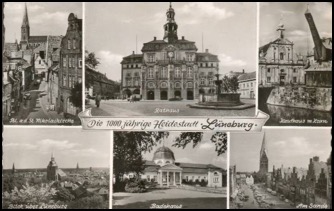

Above: I took this photo of our first house in Lüneburg My father had been in the army during the war, but was now a civilian working with NAAFI. He did not have to comply with the fraternisation restrictions that were imposed on some of our military friends, and thus we befriended the Germans in the basement and also the families of the German people who worked for my father.
on a recent visit to Germany.
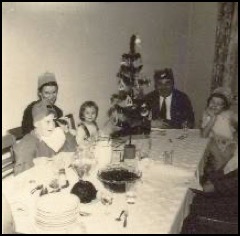
My sister and I attended Lüneburg Garrison’s primary school, which was situated in one of the barracks and was an enormous building. The school was by far the largest that I had attended, and there were lots of classes. Mr Ryan and Mr Hardman were two of my teachers, and they were rather strict compared with the female teachers that I had had at previous schools.

Below: It wasn’t until a visit to Lüneburg a few years ago that I learned that the army barracks where the school had been sited is now Lüneburg University.

We probably lived in our first house for less than a year, and then moved to another requisitioned house much closer to the school. Again, this was a lovely house, but we had it to ourselves this time. My parents did, however, befriend the German owners – the husband and wife were both doctors in the town, and they had two children. I used to swap stamps with Udo, the son. After leaving Lüneburg, my mother corresponded regularly with the wife of the family, and when she died, my mother and Udo continued corresponding. A few years ago, I met up with Udo, and he has now become great friends with our family and has visited my mother and us on several occasions.
Army quarters were being built in the town, and it wasn’t long before we moved to our third house in Lüneburg.
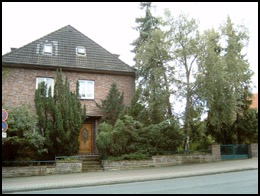
Below, left and right: Our third quarter in Lüneburg, as it looked in 1956 (left), and as it was over fifty years later, in 2007 (right).
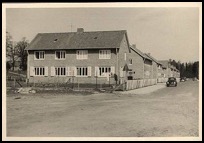
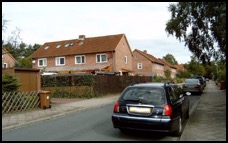
We lived in Lüneburg for three years and settled in well, met lots of people, attended lots of social events and really felt quite at home. Once we had moved into the army quarter, our friends came from a more varied background of forces children. Friendships grew, and we played in other people’s houses, as well as roller-skating and cycling in the street and playing in the nearby woods. The winter was always time for getting the sledges out, and a hill just behind our house was the ideal site for hours of snowy fun.

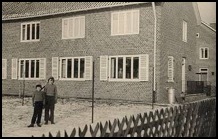
Above, left and right: Enjoying the winter in Lüneburg.
Below, left and right: Our parents seemed to have a full social life – there were always invitations on the shelf to various dos at various military establishments. My father’s job was connected with all of the services and all ranks, and there was always something to attend.
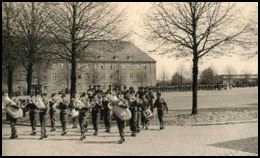

Below left and right: My mother was very much involved with the Lüneburg Brownies, of which both my sister and I were members.
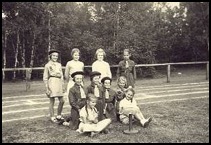

Soon after we moved to Lüneburg, a brand-new NAAFI supermarket opened up. This was at a time when self-service supermarkets were a novelty, and I recall that when this shop first opened, we had to leave our bags in lockers at the front of the store and collect them when we were ready to go through the tills.
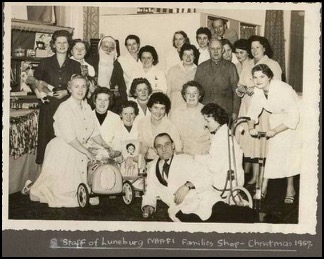
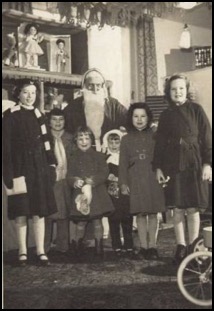

Life was not always a time for playing and enjoying social functions, though. At ten years old, I was approaching a time when my education for the future was about to change. I had heard of the Eleven Plus examination, but this wasn’t on offer at the Lüneburg school, and I and a group of other children my age sat the Moray House test. I was told that this was an equivalent test to the Eleven Plus, and have since discovered that it was a Scottish test. I don’t know why this was adopted, but that’s what I took, then being told that I had a borderline result. I didn’t know what this meant, but when I went to Prince Rupert School, Wilhelmshaven, a boarding school for the children of service personnel, all became clear.’
Barbara Steels (née Miller, b.1946).
PERSONAL STORY: MY LIFE AS AN ARMY BRAT IN LARKHILL, WILTSHIRE, AS WELL AS IN HONG KONG AND GERMANY
TACA is most grateful to Barry Hartfield, who has generously contributed his memories of his army childhood to TACA. Barry explains the background to his childhood: ‘My father was too young to go into the forces at the start of the Second World War, so for a time he was in the Home Guard (probably the original "Pike"). He did, however, join the Royal Navy towards the end of the war, I think because his elder brother was in the navy, later finding himself out in the Far East on an aircraft carrier. When he was demobbed, he joined the Territorials, then, after I was born in 1948, he joined the army. He soon found himself on his way to Korea, but his unit was then diverted to Hong Kong.’ Barry continues:
‘My mother took us two boys to Hong Kong by boat (it was a six-week-long journey) to meet up with my father, and my other brother was born in Hong Kong.
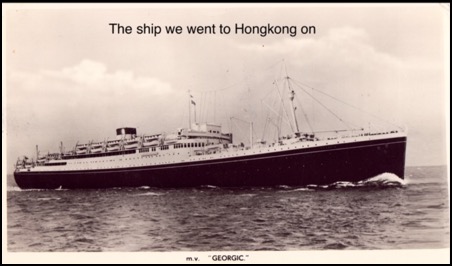
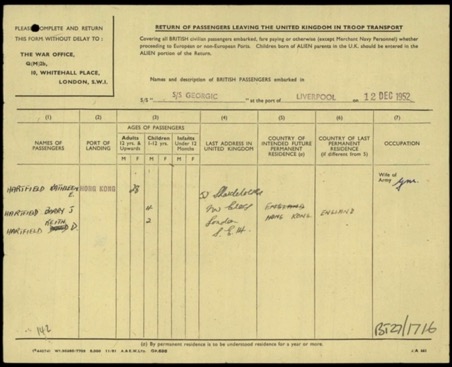
Above: The passenger manifest for our passage from Liverpool to Hong Kong aboard the SS Georgic.
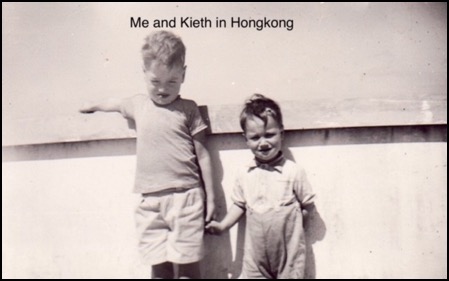



POSTED TO LARKHILL

We moved into our quarters in Alanbrook Road, a single-story building made out of corrugated iron, which was very noisy when it rained and even worse when we had hailstones. I can’t remember the number, but opposite us was a small classroom annex which I attended until I moved to the main school. This is where, apart from school lessons, I was also to learn maypole-dancing (a very enjoyable pastime). One of the only teachers I remember was Mr Brewer, a maths teacher, maths being one of the subjects I excelled in (perhaps that’s why I became a production manager in my twenties).

I must admit that I wasn’t the best-behaved boy, and would often get up to mischief. As a child, I not only had the army camp in which to find adventure, where I learnt to roller-skate on the main square (I lived on my skates, went everywhere on them and wore the wheels out), but also had Salisbury Plain to play on. Once I was caught scrumping behind one of the shops in “The Packway” by the local policeman who lived in Larkhill (his house is still there today).
I joined the Larkhill Cubs (I still have my badge today). The Cub house was not far from the garrison church, but it’s not there today. One night, coming home from Cubs, I hid in the entrance to the church in order to jump out on some of my Cub mates, slipped and, unknown to me, caught my knee on a metal spike hidden in concrete, slicing the top of my kneecap off, a scar which I carry today (one good thing that I remember about that was that I was off school for some time). I loved bob-a-job week, and would start knocking on doors around the officers’ quarters in the hope of earning more, I also would help out in the garrison church, helping to pump the church organ, which was very old.
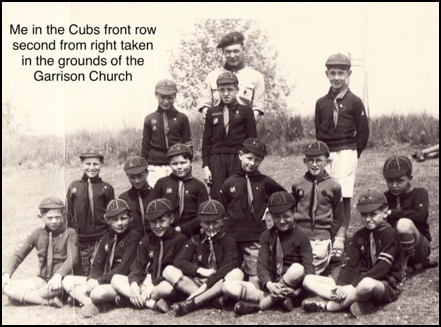
They started to knock down the corrugated houses in round about 1958. The first to go were the civilian houses. Such was our cocoon of army life that I remember someone saying to me, “Do you know that if their dad doesn’t go to work, they don’t get paid?” We couldn’t believe him: our dad always had money. We were moved to 106 Fargo Road when they started on our homes, and, that is where my fun started.
When we moved into Fargo Road, we were told that the houses’ nickname was the “steel houses”. Apparently, they were built from leftover sheeting for shipbuilding during the First World War. They were also built the wrong way round: the back was the front and vice versa; they were all painted red and filled with army personnel. When I lived there, we had a big black range to cook on; a large front garden and small back garden; and the toilet was downstairs, just inside the front/back door, so if you were in the toilet and had a visitor, it could be quite embarrassing. Across the road were air-raid shelters, although they were soon taken down. It is my belief that the foundations are still there today.
On my recent visit to Fargo Road, the land at the back of the house must have been purchased to extend the garden. The houses have been modernised and, I believe, are now privately owned.
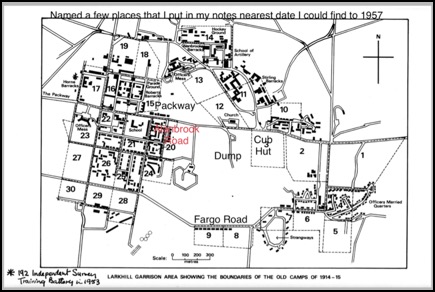
We used to walk across the field opposite to go to school, but now I see it’s fenced off. I would also cross the field to the Cubs via a burial mound, and, in the middle between the garrison church and the Packway on the other side of the road, was the local dump (gone now). Whilst rummaging around the dump one day, I found some money – it wasn’t much, but my dad made me hand it over to the local policeman (I got it back a few months later when nobody claimed it – big spend-up!)
In 1958, my father was posted to Minden, in Germany. We didn’t go with him because there were no married quarters and, because of this, this is when my mother lost control of me. It wasn’t that I got into trouble all the time, it was just the fact that, apart from going to school, I would disappear all day. I have to say that I was at my fittest and healthiest at this time in my life.
My brother and I would wander off to where the soldiers had been training to try to find spent bullets or cases. I remember foundations of old houses, which must have been where the solders practised. We once found a stack of old radio equipment that had been dumped, but to us children it was like Christmas Day, and all of the kids in our neighbourhood now had these headphones and other equipment until the army found out and sent men to collect them.
At one end of Fargo Road was the Amesbury Track, a trackway lined mostly with crab-apple trees that came out on to a road leading into Amesbury (in those days there was no dual carriageway it was just a small road).
After filling our tucked-in shirts with apples, we came to an old house (sadly gone now) before we got to Amesbury that had the biggest plum tree you have ever seen. The lady of the house would let us in to pick plums for her with a reward of more fruit for our overfilled shirts.
On other days, again going into Amesbury, we would go stickleback-fishing on the river Avon, just putting the fish into a jar and then letting them go. Another place that comes to mind is Woodhenge, which is at the end of Fargo Road leading into Amesbury and is supposed to be connected to Stonehenge. I can still hear the skylarks singing over the henge today.
At the back of our house in Fargo Road was a small wood/coppice (still there) where, during the winter, we would gather wood for Bonfire Night. It was on the land that now forms part of the extended gardens for the houses of today; then it was wasteland. Passing through the wood, which was more long than wide, we crossed a field and very soon found ourselves at Stonehenge. In those days it was open, and we (a group of army children) would play on the stones to our hearts’ content. The only facility there was an old drop-side caravan that poured many cups of tea at once for passing lorry drivers.
I am pretty sure that at the other end of Fargo Road, going towards the camp, was the NAAFI. Now there is only an imprint in the ground, but at the time it was one of the first shops I know of to go over to self-service.
During my time in Larkhill, my sister was born in Salisbury, so now we were six.

LIFE AFTER LARKHILL
Then came the time when, like many army brats, we moved to Minden.
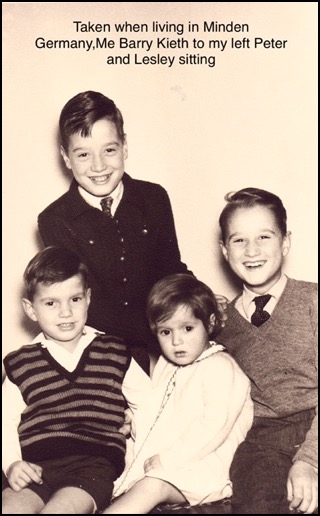
I would attend Windsor Boys’ School, a boarding school in Hamm, for the next three years, where discipline was the name of the day. I was in Sandringham House.


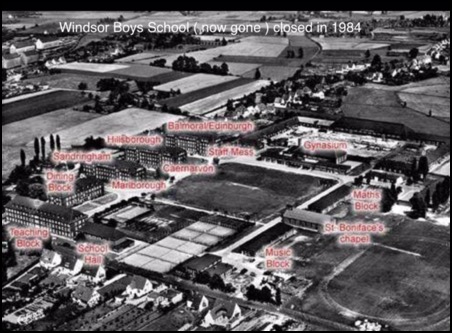
My father returned to the UK in 1963, and lived in Dulwich, in London, before being demobbed in 1964 at Woolwich. He never got over leaving the army and passed away when he was fifty-nine. As for myself, the army, and especially going to boarding school, set me up for the rest of my working life, that being spent in in production management for nearly fifty years.
Although I lived in Hong Kong and Germany, Larkhill was, to me, the happiest time of my youth, more for the freedom that my brother and I had than for anything else.’
Barry Hartfield (b.1948).
PERSONAL STORY: MEMORIES OF MÜNSTER, 1958–60
After their father was posted to Münster (in North Rhine-Westphalia, Germany) in 1958, Roger Hall attended Prince Rupert School (PRS), then based in Wilhelmshaven (see under 'Links' on TACA'S 'SCHOOLING' page), while Richard, his younger brother, went to the primary school in Münster's Oxford Barracks. Richard (whose memories of Hong Kong, 'PERSONAL STORY: HAPPY DAYS IN HONG KONG, 1953', appear above) recalls his time in Münster below, and in contacting TACA, concluded: '. . . it would be interesting to hear if any other pupils have memories of this period of time in Münster'. (Click on the highlighted link to read Roger’s army-child memories: ‘PERSONAL STORY: MEMORIES OF AN ARMY CHILDHOOD’.)
'Between 1958 and 1960, I attended Oxford Barracks Primary in Münster, with a battalion of Seaforth Highlanders based alongside. This was the first time that I had been transported to school by an army bus, having previously attended the local primary school at our last posting attached to 56 HAA [Heavy Anti-Aircraft] Regiment, Royal Artillery, based at High Legh near Knutsford in Cheshire.
My fears of living in Germany during this early post-war period were completely unfounded, and living in Münster was a very pleasant experience. This university city had been completely rebuilt in the thirteen years since the end of World War II, with lots of the shops with covered walkways having been rebuilt exactly as they had been before the war, and a big open market beside the cathedral. The married quarters seemed so luxurious, with their central heating, double glazing and a large cellar for storage – such a contrast from post-war England.
We arrived in Münster in February 1958, when Germany was having a very harsh winter. I can remember very clearly sitting on the engine cover of the school bus to keep warm, and the German bus driver, with his jodhpurs, leather jacket and peaked cap, ordering us to "sit on your sits" in his best broken English! In addition, we had some poor national serviceman to protect us in case some local decided to attack this valuable cargo! (Today's Health and Safety Executive would have a field day regarding the seating arrangements!) At the school, there was a local cook providing school dinners, which usually kept rigidly to a British menu, but occasionally we had a more exotic dessert, such as Salzburger Nockerln, which consisted of fresh fruit with cream and meringue. The teachers at Oxford School who I remember from this period were Mr Wood, the headmaster, Miss Sellars and Mr Bowen, who went on to be headmaster when Mr Wood retired. In retrospect, I am amazed that we were not taught German during this period, although we all picked up enough to go shopping, travel around town by bus and so on.
We lived in married quarters near Portsmouth Barracks (the home of the 40th Field Regiment, Royal Artillery), which was close to the Dortmund–Ems Canal. I and my friends would go and watch the barges travelling up and down this waterway, which had the added bonus of a set of locks, along with the main railway line to Osnabrück and to northern Germany, which was an added entertainment (simple pleasures seemed occupy us, especially during the school holidays). Other entertainments in Münster were visiting the Aasee, which was the local lake and beauty spot, which had pedalos and sailing dinghies for hire, and the city zoo was also close by. Another memory is belonging to the 1st Münster Cub Pack (we would meet at Winterbourne Barracks). Other regular visits included going to the NAAFI for food and pop records of the period, but Roger and I would additionally visit the local record shops in town as you had to wait so long when ordering records through the NAAFI. (There was only German TV for entertainment, so the BFN [British Forces Network] was a real lifeline for the current popular records, with the latest top twenty being broadcast on Sunday nights.) There was an AKC [Army Kinema Corporation] cinema next door to the NAAFI, where we spent many happy hours watching the latest British and American films. If my parents took me out in the car, the Möhne-Damm was fairly close by, and we would enjoy a picnic there quite often.
My father retired from the army in 1961, and we left Münster in October 1960, so all of my secondary education took place at a comprehensive school in Croydon. I think that I spent the first year feeling very miserable, having lost all of my friends and missing Germany! (The joys of being an army brat!)
In 2002, Roger and I flew to Düsseldorf, where we hired a car and visited Münster and Wilhelmshaven, staying in both and visiting all of the places that I mentioned earlier. Although the centre of Münster had hardly changed in forty years, the biggest shock was visiting where we had lived, which was still in the countryside in 1960: since then, all of the fields around the married quarters had been built on, and the old camp had been converted into luxury flats!'
Richard Hall (b.1948).
TACA CORRESPONDENCE: SINGAPORE, 1958 TO 1961
Sue Swallow (née Perry), whose father served in the Royal Electrical and Mechanical Engineers (REME), has contacted TACA with the following request for help in information-gathering:
‘I am keen to find out more about Singapore during the time I lived on the island, which was from 1958 to 1961. I do have a lot of photos and addresses and realise that some of those places no longer exist.’
If you think that you can help Sue, please e-mail her at swallow@broadsands.plus.com.
PICTURES: ‘A GUIDE TO FAMILIES GOING TO THE CARIBBEAN’, 1959, AND REVISITING JAMAICA’S UP PARK CAMP IN 1990
TACA is indebted to Barbara Rayner (née Messenger) for sharing photographs of her primary-school class in Sennelager, (West) Germany (‘PERSONAL STORY: ‘A COUPLE OF YEARS AFTER THE CLASS PHOTO WAS TAKEN, WE WERE ON A SIX-WEEK VOYAGE TO JAMAICA’’); mementoes relating to her family’s posting to Tripoli, Libya (‘PICTURES: TROOPSHIP TIPS, BOAC TICKETS AND TRAVELLING TO AND FROM TRIPOLI, LIBYA, 1950S’); mementoes of her journey from Southampton to Jamaica aboard the MS Dunera in 1960 (‘PICTURES: MEMENTOES OF A JOURNEY TO JAMAICA ABOARD THE MS DUNERA, 1960’); photographs of her family’s Jamaican married quarter in 1960 and 1990 (‘PICTURES: ‘OUR HOUSE IN JAMAICA, PICTURED IN 1960 AND IN 1990’); and a school photograph from her time in Jamaica (‘PICTURE: A SCHOOL PHOTOGRAPH, UP PARK CAMP, JAMAICA, EARLY 1960S’).
Prior to their departure for Jamaica, Barbara’s family was issued with a War Office publication dated June 1959 entitled ‘A GUIDE TO FAMILIES GOING TO THE CARIBBEAN’, some pages of which are reproduced below.

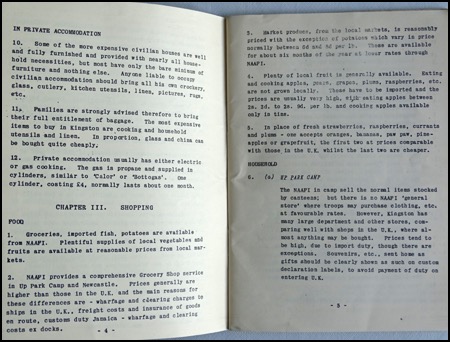
Below: Barbara also sent us this photograph of ‘me next to the Up Park Camp sign when I went back there in 1990. It was such a nostalgic trip, to see our house, the families club and swimming pool!’ Barbara and her family lived in married quarters in Up Park Camp from 1960 to 1962.
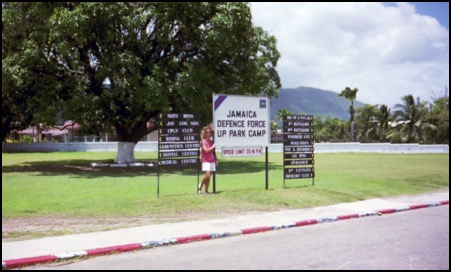
We are again grateful to Barbara for these evocative insights into her peripatetic army childhood.
TACA CORRESPONDENCE: LOOKING FOR INFORMATION ON RASAH CAMP, SEREMBAN, MALAYSIA
One-time army child Chris Fowler, whose father served in the Army Air Corps, has contacted TACA in his quest for information on Rasah Camp, in Seremban, Malaysia. Chris explains further:
‘I have little or no information on Rasah Camp. What I can tell you is that I lived in Seremban, Malaysia, at 448 England Gardens, between 1967 and 1969. A dark-green army bus would pull up outside our front garden and take me to my primary school at Rasah Camp. A friend, Caroline Harris, would sit next to me. One memory that does stick in my mind is of a trip to the zoo at Kuala Lumpur, to which a friend of my dad and his girlfriend took me and my sister for the day. On the way home in the car, I can remember the countryside looking like a scene in Africa: the sky was a magenta colour – no cloud, just a deep magenta. Talk about a setting sun – this was amazing! I have seen a similar sky in this country, and that lasted for about five minutes. No cloud, just a rich, deep red.
I also lived in Hong Kong (Kowloon Tong and Kowloon Tsai) between 1974 and 1976 and went to St George’s School there.’

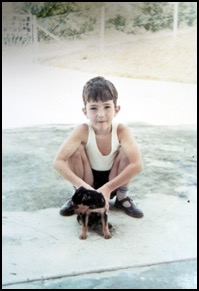
Above, left and right: Chris at the zoo in Kuala Lumpur in around 1968 (left). Chris with the family’s pet dog in the garden of his house in Seremban in about 1969 (right).

Below: Chris today.

As well as welcoming information about Rasah Camp, Chris would like to connect with Caroline Harris again. If you can help on either score, please contact TACA, and we’ll pass your message on to Chris. And click here to see his swimming certificates.
PERSONAL STORY: GREAT DAYS IN SEREMBAN, MALAYA
His father's career in the Army Catering Corps (ACC) meant that Seremban, Malaya (now Malaysia), was home to Stuart Lloyd between 1968 and 1969. In his message to TACA, Stuart recalls Christmas 1968, and 'Santa arriving in a Scout helicopter', continuing, 'I can still remember the taste of the rambutans I picked straight from the tree whilst out playing'. Stuart also has fond memories of an eventful Kettcar race.
'My dad was a cook in the army and was posted to Seremban. I was about five at the time and have vivid memories of my adventurous life. My best mate at the time was Peter Burns, and I remember all of the parents bought the kids Kettcars one Christmas and we had a race from the top of the hill, where the swimming pool was, to the bottom of the hill, which curved round to the left, towards our school. I remember falling off at the curve and being attacked by red ants. Great days!'
PERSONAL STORY: WE ‘MILITARY BRATS’ IN MALTA, 1965–67
TACA is indebted to Gary Stephen for sharing the following photographs from his family album. Gary writes:
‘My father, WO1 [Warrant Officer Class 1] Harry Gifford Rolfe, who served with the Loyal North Lancashire Regiment, was posted to both Malta and Malaysia. I and my three brothers were ‘military brats’ who attended St Andrew’s Army School, Malta, from 1965 to 1967, and Highgate Hill Army School, in Kem Rasah Army Camp, Seremban, Kuala Lumpur, Malaysia, from 1968 to 1970. Here are some photos of our time in Malta, which I hope you will enjoy seeing as much as we enjoyed both postings with our parents’. (See ‘PERSONAL STORY: ‘WE CONSIDERED MALAYSIA TO BE OUR FAVOURITE POSTING’, below, for photographs of the Stephen family’s time in Malaysia.)
Below: We ‘military brats’, 1966 (left). Leslie, Kevin and Gary playing football, 1966 (right).


Below: St Andrew’s School (left). A swimming certificate awarded by the Army Children’s School in 1967 (right).


Below: Robb Lido (left) was a very popular place with families on the island. It was named after Major General William Robb, CBE, DSO, MC, general officer commanding Malta, 1943–45. It’s now part of the Corinthia Hotel. Our Leslie, the youngest brother, at Robb Lido in 1966 (right).

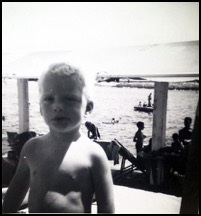
Below: Our Steven standing on the rocks, with our Kevin drinking a bottle of 7up. Sometimes there was a prize under the cork of the bottle lid, usually for another bottle or a rocket ice lolly – great days! Empty 7up bottles being loaded onto a boat (right). We used to get 1p back on the empty returns.
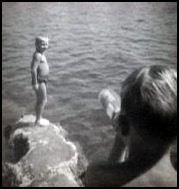

Below: Our Steven, the third brother, on his lilo out in St Paul’s Bay (left). Our Kevin, the second brother, and Steven (right) at St Paul’s Bay eating ice cream on a very hot day!


Below: Our Leslie learning to swim in St Paul’s Bay, with one of the moored rafts in the background (left). Our Leslie doing an impression of Dean Martin in 1966 (right) – check out the plastic pineapple ice bucket!


Below: Our mum, Yvonne, with our Leslie at St Paul’s Bay in 1966.
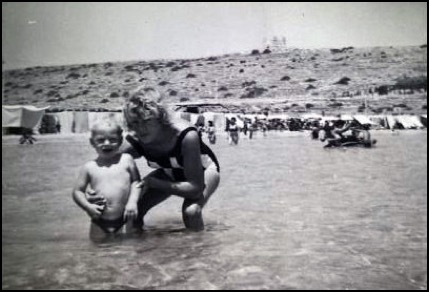
PERSONAL STORY: ‘WE CONSIDERED MALAYSIA TO BE OUR FAVOURITE POSTING’
Although Gary Stephen and his family enjoyed their posting to Malta (see above, ‘PERSONAL STORY: WE ‘MILITARY BRATS IN MALTA, 1965–67’), according to Gary, ‘I and my three brothers considered Malaysia to be our favourite posting’. He goes on to say: ‘My father, WO1 [Warrant Officer Class 1] Harry Gifford Rolfe, Loyal North Lancashire Regiment, was posted to Kem Rasah Army Camp (Bukit Rasah), Seremban, Kuala Lumpur, between 1968 and 1970. I would now like to share our experiences of our schooling and leisure time out there with you all’. Gary has done so by generously contributing the photographs below, and TACA is most grateful to him.
Below: Our first house was in Negeri Sembilan, and these photographs were taken in 1968.
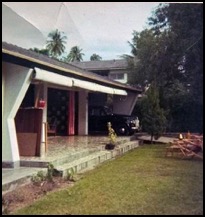
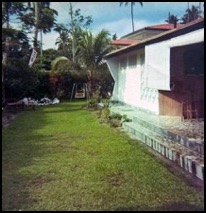
Below: Our mother, Yvonne; youngest brother, Leslie; third brother, Steven; and our Kevin, second brother, on the swing in the garden of the house in Negeri Sembilan (left). Me holding our beloved dog, Rebel, with Kevin, Steven and Leslie on his Tri-ang in 1968 (right).


Below: Me and Kevin in Negeri Sembilan in 1968, ready to go butterfly-collecting.
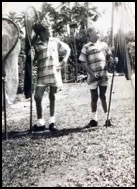
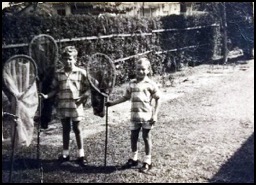
Below: Our father’s Rover P4, the first of three cars that we had during our time in Kuala Lumpur (left). His second car (right).
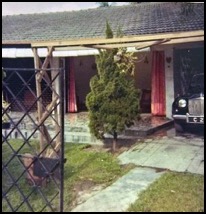
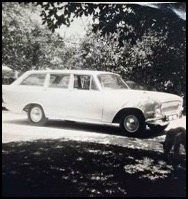
Below: Our housekeeper, Fatima, and our mother in the doorway of our second house, in Bukit Rasah, with my mother’s Triumph Herald and our father’s Consul, 1969 (left). Kevin, Mother (holding Leslie) and Steven – ‘Cheer up, Steven, it’s your turn next on the swing’ (right).

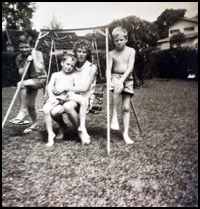
Below: Our Leslie (left) and Steven (right) playing badminton in the back garden of the house in Bukit Rasha in 1969.
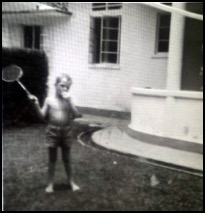

Below: Me and Leslie dressed for dinner at Government House in 1969 (left). Leslie and Steven similarly dressed for dinner at Government House in 1970 (right).


Below: Steven and me in 1970: ‘No, Steven, it’s my bow and arrow’ (left). Our Stephen with his bow and arrow (right).
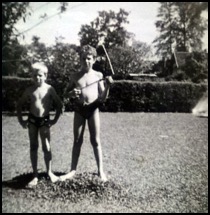

Below: Our Kevin, with our beloved dog, Little Bit, in 1970 (left). Leslie and Kevin with our Little Bit (right).

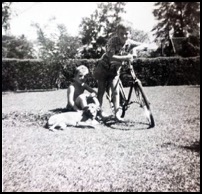
Below: Steve, me and Leslie (left). Me catching butterflies in Selangor in 1970 (right).

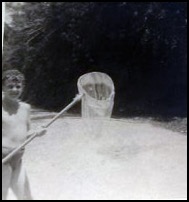
Below: Port Dickson, Negeri Sembilan, in 1968: our Kevin (left); me, Steven and Kevin (right).
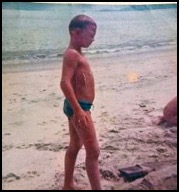
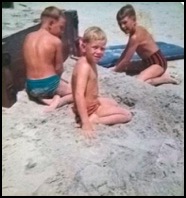
Below: Me, Steven, Leslie and Kevin in Penang in 1968 (left). Leslie and Steven in Penang in 1968 (right).
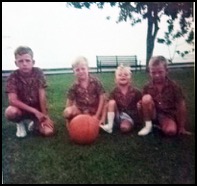

Below: Miss Lockwood’s class, Highgate Hill Primary School (motto, ‘Strive to Serve’), Kem Rasah, Seremban, Malaysia in 1968. Leslie is in the front row on the far right. The school was next to Kem Rasah Army Camp, where our father was posted.

Below: Highgate Hill Primary School’s football team, 1970; our Kevin is in the back row, fourth from left.

Below: A certificate awarded to Kevin in 1968 for coming first in Highgate Hill Primary School’s first-year boys’ sack race (left). Army families used the outdoor swimming pool in the grounds of the Kem Rasah Army Camp (right).


Below: Our late father, WO1 Harry Gifford Rolfe, with our beloved mother, Yvonne, dressed for dinner at Government House in 1970 (left). At the inter-schools’ swimming and diving championships held in Minden Barracks, Penang, in 1969; Kevin, won a silver medal; Steven, a certificate of merit; Leslie, a gold and two silver medals; and I, a bronze medal (right).

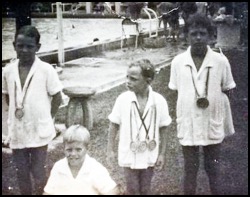
CHRISTMAS MENU, SAVOY HOSTEL, SINGAPORE, 1967
Reproduced below is the Christmas Day menu produced in 1967 by the management and staff of the Savoy Hostel in Singapore, who wished ‘their families a very happy & enjoyable Christmas’. Lynne Copping (née Wilson) is just one of the army children who stayed at the Savoy Hostel during the 1960s (see ‘PERSONAL STORY: MY ARMY CHILDHOOD IN EGYPT, THE UK AND SINGAPORE’)
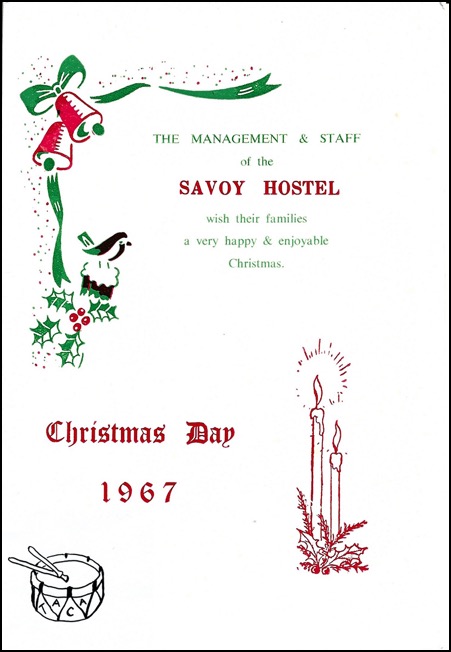
The menu reads as follows:
‘Breakfast
7.30 to 8.30 am: Grapefruit / Porridge or Cereals / Fried Bacon, Egg, Sausage, Tomato / Toast, Marmalade / Tea
10 am: Tea & Biscuits
Dinner
1 pm: Cream Tomato Soup / Salmon Vol-Au-Vent
Roast Turkey – Stuffing – White Wine / Brussel Sprouts / Roast & Creamed Potatoes / Peas / Carrots
Christmas Pudding with Brandy Sauce/ Mince Pies with Cream
Fresh Fruit
Tea/Coffee
3.45 pm: CHILDREN’S CHRISTMAS PARTY (Film Show in Lounge)
4.45 pm: Tea / Assorted Sandwiches, Cakes, Mince Pies / Jelly, Ice Cream, Squash/Tea / Novelties
BUFFET
7 pm: (Adults) / Cold Roast Beef, Pork, Assorted Pickles / Mixed Veg Salad, Cheese/Biscuits / Trifle / Christmas Cake / Tea /Coffee’
The blank page on the reverse is headed ‘Autographs’.
PICTURES: SNAPSHOTS OF DHEKELIA, CYPRUS, 1968–72
Regular contributor Peter Goble recently discovered a cache of slides in his attic, some of which dated from his posting to Cyprus with the Royal Army Medical Corps (RAMC) between 1968 and 1972, which he has kindly shared with TACA. The army child who features in many of them is his son.
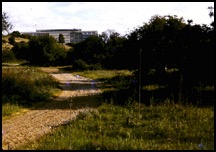
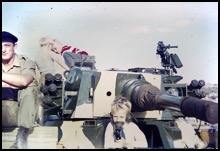
Above, left and right: BMH Dhekelia, 1970 (left); a summer fête in Dhekelia (right).
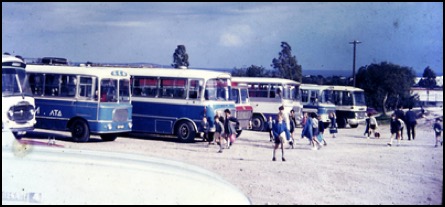
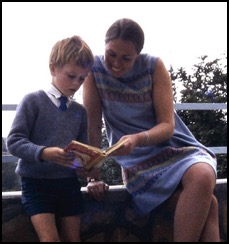

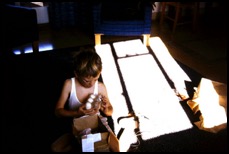
For more of Peter’s photographs, see: ‘PICTURE: A CHRISTMAS PARTY FOR ARMY CHILDREN AT THE CAMBRIDGE MILITARY HOSPITAL, ALDERSHOT, IN 1967’ and ‘PICTURE: MARRIED QUARTER IN DHEKELIA, CYPRUS, 1969’.
PERSONAL STORY: HOLIDAYS IN GIBRALTAR
'My clearest early memories of life abroad are of Gibraltar in the mid-1970s. The small peninsula (about 5 square miles) was cut off at the border from mainland Spain at the time and all transport to and from the "Rock" was by air or across the straits to Morocco. At the weekend local Spanish families used to congregate at the border fence and shout greetings and news to one another across the 100 yards or so to the Spanish side. The Union Jack was lowered every night to the sound of the Last Post.

Above: A view of Rosia and the barracks dating from the first half of the twentieth century.
The travel limitations were no great hardship to a 10-year-old, and most of the school holidays were spent at the Rosia Bay swimming club or, at the weekends, at one of the beaches on the western coast. Travel to Gibraltar by air from boarding school was as an "unaccompanied minor", which guaranteed VIP status to the garrison children as they were whisked to the front of all customs and passport queues.
As an important naval base, we could see from our balcony a succession of the UK's leading battleships and submarines, mooring on the "cobs" or artificial breakwaters in the harbour. The navy also treated the local army children to tours of the ships and submarines or short trips in the Med. Most of the major cruise ships also stopped off, so in spite of the isolation, the little garrison community and local native Gibraltarians were regularly swelled by the comings and goings in the harbour, with the tourists streaming up Main Street in search of cheap Parker pens, which, alongside the clay model apes, seemed to dominate trade for the Moroccan shopkeepers.
I recall on one occasion the local radio decided to liven up the sporting calendar by instigating a race down Main Street for children. Sadly for the organisers only two boys turned up: I and my older brother. However, the race went ahead and we both won impressive trophies: for first and second place in the boys' race.
I returned to Gibraltar about five years ago and surprisingly little had changed. Spain has modernised impressively, but Gibraltar's years of isolation seem to have left it behind, and in need of a lick of paint.'
SW (b.1963).
PERSONAL STORY: MEMORIES OF DHARAN CANTONMENT, NEPAL, 1979–80
We have Twitter to thank for Nancy Johnston’s fascinating contribution, below, as she explains: ‘Last month, I tweeted a photo of Christmas in Nepal and was asked by @ArmyChildren [TACA] if I would consider submitting our family memories. I checked with the children – now middle-aged – and the result is attached, together with jpgs. Some of the photos are a bit faded!’ Read on for those illustrated memories.
‘
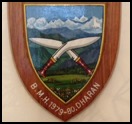
The journey from Dumbartonshire, Scotland, to Nepal seemed to take forever – taxi to Glasgow Central Station; train to London; taxi to RAF Hendon, where we spent the night; minibus to Heathrow; then many hours of sitting on the runway on board a BA VC10 before it finally took off. The result was that we missed our connection at Delhi and had to spend hours in the transit lounge, where we were offered curry sandwiches accompanied by lots of flies! We finally reached Dharan after a night in Kathmandu and a short flight to Biratnagar.
Life in Dharan Cantonment was very different from life in Scotland in 1979. There were hoopoes and mynah birds in the garden, and we saw lots of exotic creatures, including snakes, lizards and a praying mantis. We grew bananas, guavas and pineapples in our garden. The forest came right up to the fence at the gate of the camp, and there were monkeys and huge spiders in the trees and bamboo groves. We acquired old Indian bikes and spent most of the time outdoors.

Above: We rode old Indian bikes in the cantonment.
We attended school in the mornings, and most afternoons were spent in the swimming pool alongside the school. There were sixteen children at the school, and we had great fun. In addition to normal lessons, we explored the various departments in the cantonment and learned how they functioned. The butchery was a particular highlight. We watched as a pig was gutted and cut up into joints and chops, and we found out how the sausage machine worked.
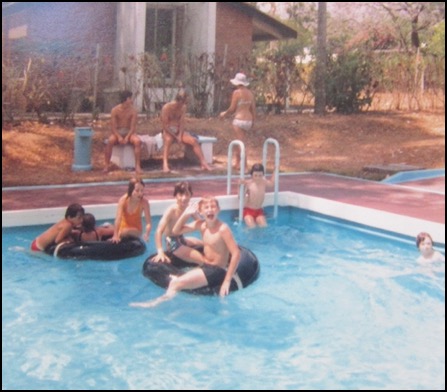
Above: We swam in the pool by the school most afternoons.
Christmas was very different in Nepal. We had crackers (bought from the bazaar), which were more like explosive devices, as when they were pulled there was a huge bang and lots of sparks! At school we had a nativity play, in which all the pupils took part. At our Christmas party, the main attraction was the chance to have an elephant ride, though not all of us would do it, as it was rather far off the ground!

Above: All of the school’s pupils took part in the Christmas nativity play.
Below: The chance to ride an elephant is an unforgettable memory of that Christmas.

There was a machine shop in the bazaar where kukris were made out of old Land Rover leaf springs, and we, unknown to our parents, persuaded the craftsmen to make one for the birthday of one of our friends. He was probably about six! The bazaar sold local sweets, dried yak cheese, which was rock hard, and gulab jamun.
We had the free run of the camp, which was pretty safe other than the time that a rabid dog got into the cantonment. The camp children all had to have a course of anti-rabies injections, but we took this in our stride.
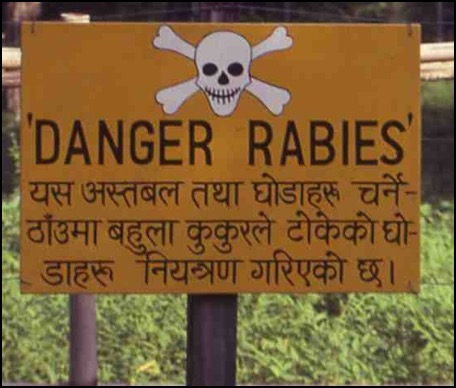
Above: Rabies was a very real threat in Dharan Cantonment.
For holidays, we went to Darjeeling, where we visited the Himalayan Mountaineering Institute’s museum; to Kalimpong, in India; to Hong Kong; and to Kathmandu, where we visited many of the temples, since destroyed in the 2015 earthquake, and also saw the living goddess.

Above: We were draped in garlands on leaving Nepal.
These are just some of our memories of a wonderful year in Nepal. We were sorry to leave in August 1980.’
TACA is immensely grateful to Nancy and her family for sharing their memories and photographs of Nepal. And if you use Twitter, you can follow Nancy and her colleagues at @SSAFAPerth.
LINKS
The following links relating to the places where army children have lived may be of interest.
- The British Army's close connection with Gibraltar (a British overseas territory) has lasted for around three hundred years, and plenty of army children have called it home during those three centuries. Since 1991, the connection has been maintained by the Gibraltar Regiment, under the umbrella of British Forces Gibraltar. If you are interested in Gibraltar, visit the Discover Gibraltar website (http://www.discovergibraltar.com), where you'll find more than three hundred fascinating pages covering Gibraltar's history, heritage and attractions, illustrated with over a thousand photographs, maps and diagrams.
- Michael Longyear, a former army child, has written and published a 40pp, limited-print-run booklet entitled Malta, 1937-1942: Some Childhood Memories. This tells of his experiences as an army child during the World War II siege of Malta (for further details, click here). Copies (which cost £4, including post and packing for the UK; overseas p&p by arrangement) can be obtained by e-mailing MLPRS@aol.com
- The Memories of Singapore website displays a wide selection of photographs and images of Singapore contributed by people (many of them former pupils of BFES schools) who lived there during the 1960s and 1970s. To view them, visit: http://www.singas.co.uk
- The BAOR Locations website (http://baor-locations.co.uk) is an information-packed work in progress for those interested in key locations associated with the British Army of the Rhine (BAOR). Here, you'll find a history of BAOR; historical facts, memories and photographs relating to BAOR locations in Germany, including barracks, British military hospitals and schools; along with a forum, guides to BFPO numbers and regiments stationed in BAOR and much more.
TACA POSTINGS ALBUM: ENGLAND
TACA POSTINGS ALBUM: INDIA
TACA POSTINGS ALBUM: GERMANY

